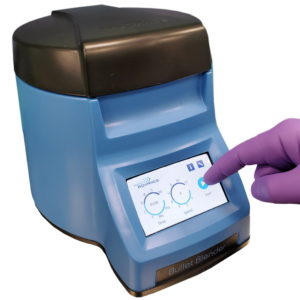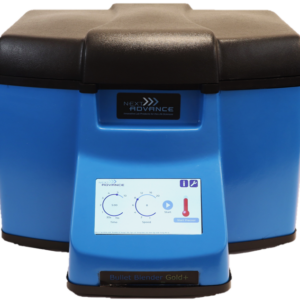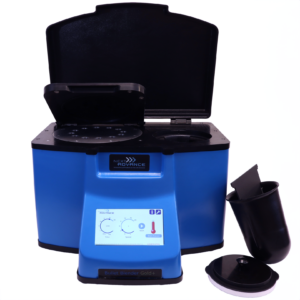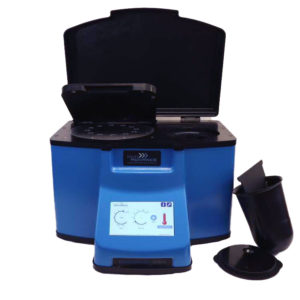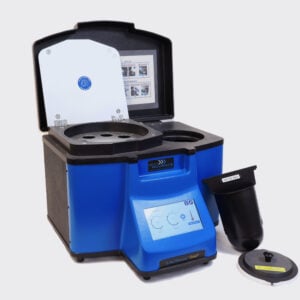Ideal for Tumor/Cancer Tissue Homogenization
Do you spend lots of time and effort homogenizing tumor/cancer tissue samples? The Bullet Blender® tissue homogenizer delivers high quality and superior yields. No other homogenizer comes close to delivering the Bullet Blender’s winning combination of top-quality performance and budget-friendly affordability. See below for a tumor/cancer tissue homogenization protocol.
Save Time, Effort and Get Superior Results with
The Bullet Blender Homogenizer
Consistent and High Yield Results
Run up to 24 samples at the same time under microprocessor-controlled conditions, ensuring experimental reproducibility and high yield. Process samples from 10mg or less up to 3.5g.No Cross Contamination
No part of the Bullet Blender ever touches the tissue – the sample tubes are kept closed during homogenization. There are no probes to clean between samples.Samples Stay Cool
The Bullet Blenders’ innovative and elegant design provides convective cooling of the samples, so they do not heat up more than several degrees. In fact, our Gold+ models hold the sample temperature to about 4ºC.Easy and Convenient to Use
Just place beads and buffer along with your tissue sample in standard tubes, load tubes directly in the Bullet Blender, select time and speed, and press start.Risk Free Purchase
Thousands of peer-reviewed journal articles attest to the consistency and quality of the Bullet Blender homogenizer. We offer a 2 year warranty, extendable to 4 years, because our Bullet Blenders are reliable and last for many years.Tumor/Cancer Tissue Homogenization Protocol
Sample size |
See the Protocol |
| microcentrifuge tube model (up to 300 mg) | Small tumor/cancer samples |
| 5mL tube model (100mg - 1g) | Medium tumor/cancer samples |
What Else Can You Homogenize? Tough or Soft, No Problem!
The Bullet Blender can process a wide range of samples including organ tissue, cell culture, plant tissue, and small organisms. You can homogenize samples as tough as mouse femur or for gentle applications such as tissue dissociation or organelle isolation.
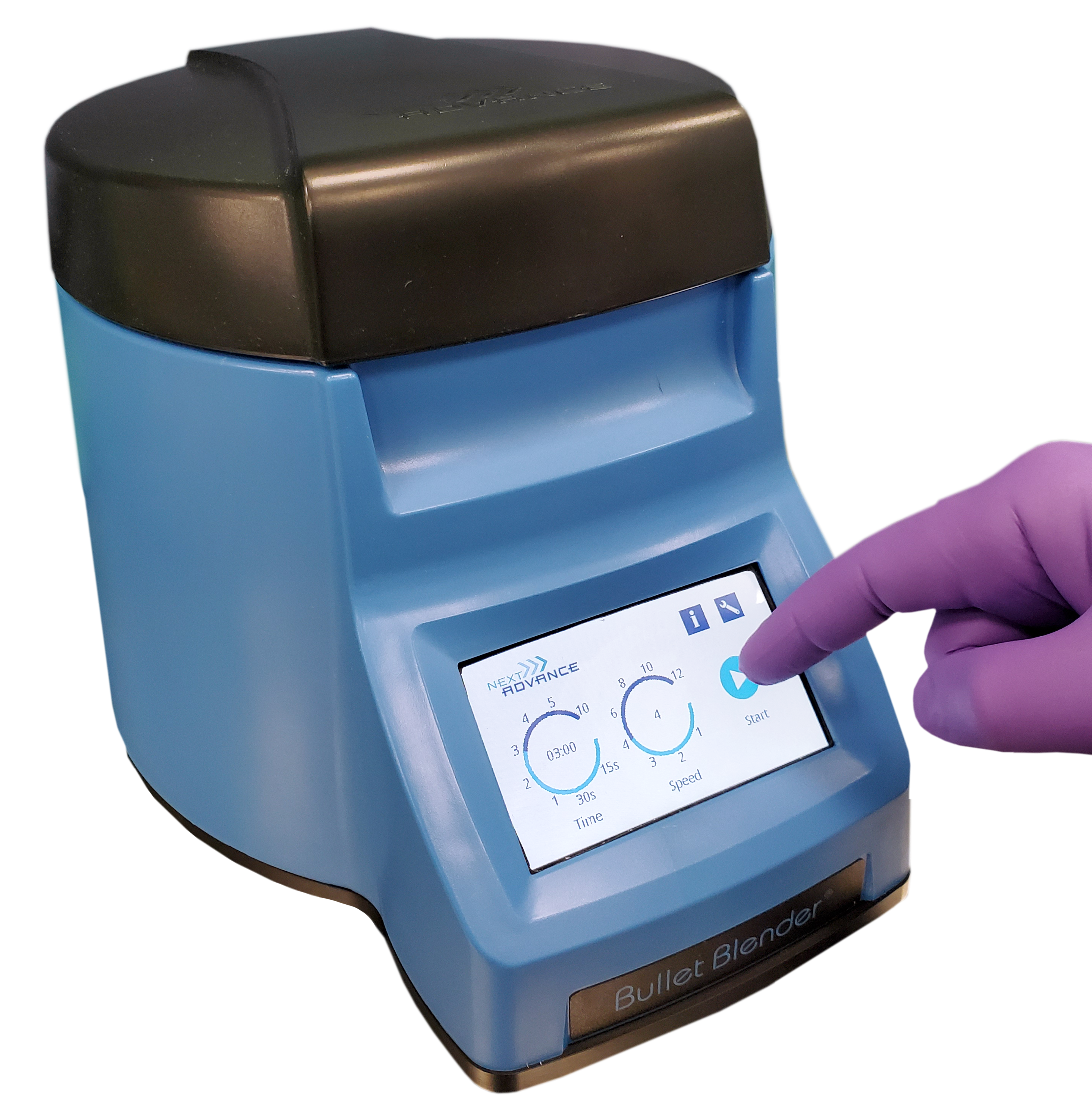
Want more guidance? Need a quote? Contact us:
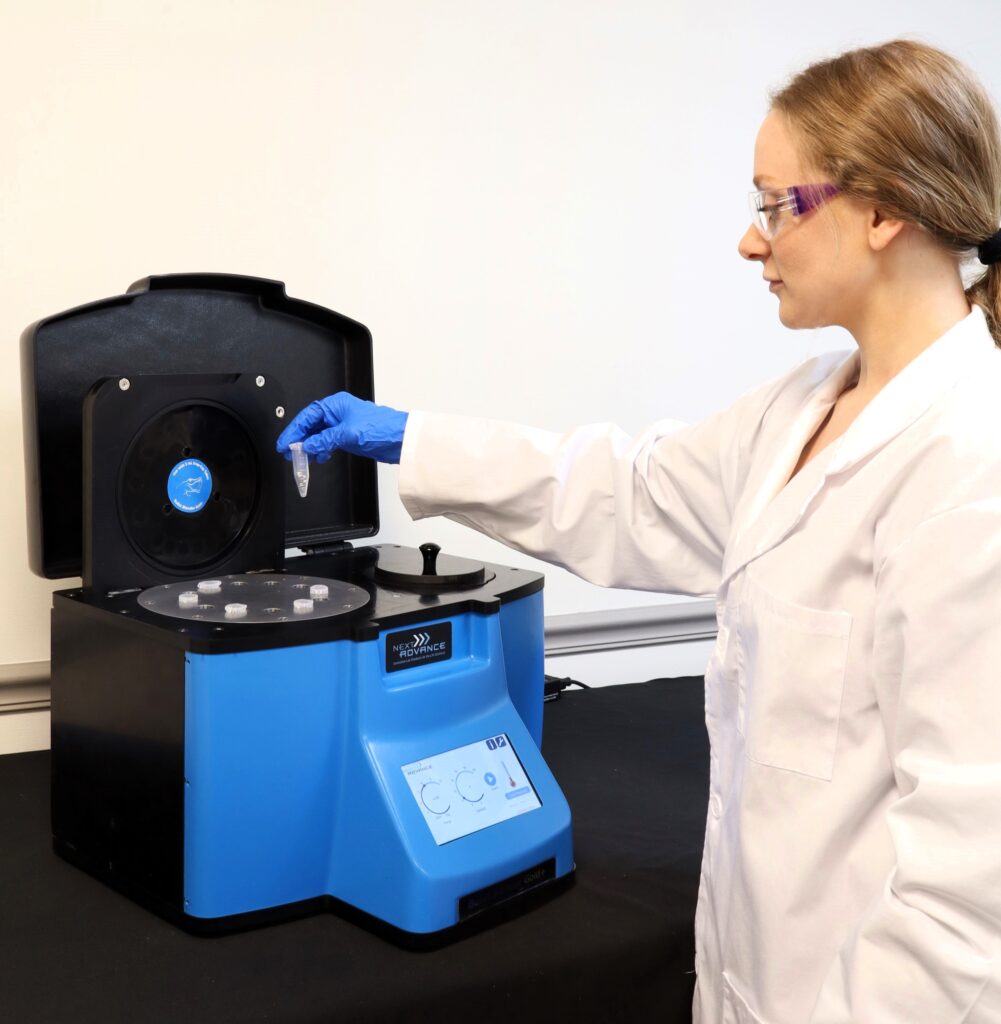
Bullet Blender Models
Select Publications using the Bullet Blender to Homogenize Tumor/Cancer Tissue
2474232
tumor
1
apa
50
date
desc
3291
https://www.nextadvance.com/wp-content/plugins/zotpress/
%7B%22status%22%3A%22success%22%2C%22updateneeded%22%3Afalse%2C%22instance%22%3Afalse%2C%22meta%22%3A%7B%22request_last%22%3A0%2C%22request_next%22%3A0%2C%22used_cache%22%3Atrue%7D%2C%22data%22%3A%5B%7B%22key%22%3A%22CBW3TNT6%22%2C%22library%22%3A%7B%22id%22%3A2474232%7D%2C%22meta%22%3A%7B%22creatorSummary%22%3A%22Masterson%20et%20al.%22%2C%22parsedDate%22%3A%222016%22%2C%22numChildren%22%3A2%7D%2C%22bib%22%3A%22%26lt%3Bdiv%20class%3D%26quot%3Bcsl-bib-body%26quot%3B%20style%3D%26quot%3Bline-height%3A%202%3B%20padding-left%3A%201em%3B%20text-indent%3A-1em%3B%26quot%3B%26gt%3B%5Cn%20%20%26lt%3Bdiv%20class%3D%26quot%3Bcsl-entry%26quot%3B%26gt%3BMasterson%2C%20L.%2C%20Winder%2C%20D.%20M.%2C%20Ball%2C%20S.%20L.%20R.%2C%20Vaughan%2C%20K.%2C%20Lehmann%2C%20M.%2C%20Scholtz%2C%20L.-U.%2C%20Sterling%2C%20J.%20C.%2C%20Sudhoff%2C%20H.%20H.%2C%20%26amp%3B%20Goon%2C%20P.%20K.%20C.%20%282016%29.%20Molecular%20analyses%20of%20unselected%20head%20and%20neck%20cancer%20cases%20demonstrates%20that%20human%20papillomavirus%20transcriptional%20activity%20is%20positively%20associated%20with%20survival%20and%20prognosis.%20%26lt%3Bi%26gt%3BBMC%20Cancer%26lt%3B%5C%2Fi%26gt%3B%2C%20%26lt%3Bi%26gt%3B16%26lt%3B%5C%2Fi%26gt%3B%2C%20367.%20%26lt%3Ba%20class%3D%26%23039%3Bzp-DOIURL%26%23039%3B%20href%3D%26%23039%3Bhttps%3A%5C%2F%5C%2Fdoi.org%5C%2F10.1186%5C%2Fs12885-016-2398-7%26%23039%3B%26gt%3Bhttps%3A%5C%2F%5C%2Fdoi.org%5C%2F10.1186%5C%2Fs12885-016-2398-7%26lt%3B%5C%2Fa%26gt%3B%26lt%3B%5C%2Fdiv%26gt%3B%5Cn%26lt%3B%5C%2Fdiv%26gt%3B%22%2C%22data%22%3A%7B%22itemType%22%3A%22journalArticle%22%2C%22title%22%3A%22Molecular%20analyses%20of%20unselected%20head%20and%20neck%20cancer%20cases%20demonstrates%20that%20human%20papillomavirus%20transcriptional%20activity%20is%20positively%20associated%20with%20survival%20and%20prognosis%22%2C%22creators%22%3A%5B%7B%22creatorType%22%3A%22author%22%2C%22firstName%22%3A%22Liam%22%2C%22lastName%22%3A%22Masterson%22%7D%2C%7B%22creatorType%22%3A%22author%22%2C%22firstName%22%3A%22David%20M.%22%2C%22lastName%22%3A%22Winder%22%7D%2C%7B%22creatorType%22%3A%22author%22%2C%22firstName%22%3A%22Siolian%20L.%20R.%22%2C%22lastName%22%3A%22Ball%22%7D%2C%7B%22creatorType%22%3A%22author%22%2C%22firstName%22%3A%22Katie%22%2C%22lastName%22%3A%22Vaughan%22%7D%2C%7B%22creatorType%22%3A%22author%22%2C%22firstName%22%3A%22Martin%22%2C%22lastName%22%3A%22Lehmann%22%7D%2C%7B%22creatorType%22%3A%22author%22%2C%22firstName%22%3A%22Lars-Uwe%22%2C%22lastName%22%3A%22Scholtz%22%7D%2C%7B%22creatorType%22%3A%22author%22%2C%22firstName%22%3A%22Jane%20C.%22%2C%22lastName%22%3A%22Sterling%22%7D%2C%7B%22creatorType%22%3A%22author%22%2C%22firstName%22%3A%22Holger%20H.%22%2C%22lastName%22%3A%22Sudhoff%22%7D%2C%7B%22creatorType%22%3A%22author%22%2C%22firstName%22%3A%22Peter%20K.%20C.%22%2C%22lastName%22%3A%22Goon%22%7D%5D%2C%22abstractNote%22%3A%22Human%20papillomavirus%20DNA%20detection%20in%20head%20and%20neck%20squamous%20cell%20carcinoma%20has%20been%20linked%20to%20improved%20patient%20prognosis.%20The%20main%20aims%20of%20the%20study%20was%20to%20test%20the%20hypotheses%20that%20HPV16%20E6%5C%2FE7%20oncogene%20and%20p53%20function%20within%20tumours%20were%20associated%20with%20the%20widely%20reported%20improved%20patient%20survival%20and%20prognosis%20in%20head%20and%20neck%20cancer.%22%2C%22date%22%3A%222016%22%2C%22language%22%3A%22%22%2C%22DOI%22%3A%2210.1186%5C%2Fs12885-016-2398-7%22%2C%22ISSN%22%3A%221471-2407%22%2C%22url%22%3A%22http%3A%5C%2F%5C%2Fdx.doi.org%5C%2F10.1186%5C%2Fs12885-016-2398-7%22%2C%22collections%22%3A%5B%22M2MNG549%22%5D%2C%22dateModified%22%3A%222016-06-24T15%3A13%3A42Z%22%7D%7D%2C%7B%22key%22%3A%22VUD8PW3Z%22%2C%22library%22%3A%7B%22id%22%3A2474232%7D%2C%22meta%22%3A%7B%22creatorSummary%22%3A%22Ruhaak%20et%20al.%22%2C%22parsedDate%22%3A%222015-11-06%22%2C%22numChildren%22%3A0%7D%2C%22bib%22%3A%22%26lt%3Bdiv%20class%3D%26quot%3Bcsl-bib-body%26quot%3B%20style%3D%26quot%3Bline-height%3A%202%3B%20padding-left%3A%201em%3B%20text-indent%3A-1em%3B%26quot%3B%26gt%3B%5Cn%20%20%26lt%3Bdiv%20class%3D%26quot%3Bcsl-entry%26quot%3B%26gt%3BRuhaak%2C%20L.%20R.%2C%20Taylor%2C%20S.%20L.%2C%20Stroble%2C%20C.%2C%20Nguyen%2C%20U.%20T.%2C%20Parker%2C%20E.%20A.%2C%20Song%2C%20T.%2C%20Lebrilla%2C%20C.%20B.%2C%20Rom%2C%20W.%20N.%2C%20Pass%2C%20H.%2C%20Kim%2C%20K.%2C%20Kelly%2C%20K.%2C%20%26amp%3B%20Miyamoto%2C%20S.%20%282015%29.%20Differential%20N-Glycosylation%20Patterns%20in%20Lung%20Adenocarcinoma%20Tissue.%20%26lt%3Bi%26gt%3BJournal%20of%20Proteome%20Research%26lt%3B%5C%2Fi%26gt%3B%2C%20%26lt%3Bi%26gt%3B14%26lt%3B%5C%2Fi%26gt%3B%2811%29%2C%204538%26%23x2013%3B4549.%20%26lt%3Ba%20class%3D%26%23039%3Bzp-DOIURL%26%23039%3B%20href%3D%26%23039%3Bhttps%3A%5C%2F%5C%2Fdoi.org%5C%2F10.1021%5C%2Facs.jproteome.5b00255%26%23039%3B%26gt%3Bhttps%3A%5C%2F%5C%2Fdoi.org%5C%2F10.1021%5C%2Facs.jproteome.5b00255%26lt%3B%5C%2Fa%26gt%3B%26lt%3B%5C%2Fdiv%26gt%3B%5Cn%26lt%3B%5C%2Fdiv%26gt%3B%22%2C%22data%22%3A%7B%22itemType%22%3A%22journalArticle%22%2C%22title%22%3A%22Differential%20N-Glycosylation%20Patterns%20in%20Lung%20Adenocarcinoma%20Tissue%22%2C%22creators%22%3A%5B%7B%22creatorType%22%3A%22author%22%2C%22firstName%22%3A%22L.%20Renee%22%2C%22lastName%22%3A%22Ruhaak%22%7D%2C%7B%22creatorType%22%3A%22author%22%2C%22firstName%22%3A%22Sandra%20L.%22%2C%22lastName%22%3A%22Taylor%22%7D%2C%7B%22creatorType%22%3A%22author%22%2C%22firstName%22%3A%22Carol%22%2C%22lastName%22%3A%22Stroble%22%7D%2C%7B%22creatorType%22%3A%22author%22%2C%22firstName%22%3A%22Uyen%20Thao%22%2C%22lastName%22%3A%22Nguyen%22%7D%2C%7B%22creatorType%22%3A%22author%22%2C%22firstName%22%3A%22Evan%20A.%22%2C%22lastName%22%3A%22Parker%22%7D%2C%7B%22creatorType%22%3A%22author%22%2C%22firstName%22%3A%22Ting%22%2C%22lastName%22%3A%22Song%22%7D%2C%7B%22creatorType%22%3A%22author%22%2C%22firstName%22%3A%22Carlito%20B.%22%2C%22lastName%22%3A%22Lebrilla%22%7D%2C%7B%22creatorType%22%3A%22author%22%2C%22firstName%22%3A%22William%20N.%22%2C%22lastName%22%3A%22Rom%22%7D%2C%7B%22creatorType%22%3A%22author%22%2C%22firstName%22%3A%22Harvey%22%2C%22lastName%22%3A%22Pass%22%7D%2C%7B%22creatorType%22%3A%22author%22%2C%22firstName%22%3A%22Kyoungmi%22%2C%22lastName%22%3A%22Kim%22%7D%2C%7B%22creatorType%22%3A%22author%22%2C%22firstName%22%3A%22Karen%22%2C%22lastName%22%3A%22Kelly%22%7D%2C%7B%22creatorType%22%3A%22author%22%2C%22firstName%22%3A%22Suzanne%22%2C%22lastName%22%3A%22Miyamoto%22%7D%5D%2C%22abstractNote%22%3A%22%22%2C%22date%22%3A%222015-11-06%22%2C%22language%22%3A%22en%22%2C%22DOI%22%3A%2210.1021%5C%2Facs.jproteome.5b00255%22%2C%22ISSN%22%3A%221535-3893%2C%201535-3907%22%2C%22url%22%3A%22http%3A%5C%2F%5C%2Fpubs.acs.org%5C%2Fdoi%5C%2F10.1021%5C%2Facs.jproteome.5b00255%22%2C%22collections%22%3A%5B%22M2MNG549%22%5D%2C%22dateModified%22%3A%222015-12-30T18%3A36%3A49Z%22%7D%7D%2C%7B%22key%22%3A%22PXU9TUAQ%22%2C%22library%22%3A%7B%22id%22%3A2474232%7D%2C%22meta%22%3A%7B%22creatorSummary%22%3A%22Byun%20et%20al.%22%2C%22parsedDate%22%3A%222015-10-13%22%2C%22numChildren%22%3A0%7D%2C%22bib%22%3A%22%26lt%3Bdiv%20class%3D%26quot%3Bcsl-bib-body%26quot%3B%20style%3D%26quot%3Bline-height%3A%202%3B%20padding-left%3A%201em%3B%20text-indent%3A-1em%3B%26quot%3B%26gt%3B%5Cn%20%20%26lt%3Bdiv%20class%3D%26quot%3Bcsl-entry%26quot%3B%26gt%3BByun%2C%20S.%2C%20Shin%2C%20S.%20H.%2C%20Lee%2C%20E.%2C%20Lee%2C%20J.%2C%20Lee%2C%20S.-Y.%2C%20Farrand%2C%20L.%2C%20Jung%2C%20S.%20K.%2C%20Cho%2C%20Y.-Y.%2C%20Um%2C%20S.-J.%2C%20Sin%2C%20H.-S.%2C%20Kwon%2C%20Y.-J.%2C%20Zhang%2C%20C.%2C%20Tsang%2C%20B.%20K.%2C%20Bode%2C%20A.%20M.%2C%20Lee%2C%20H.%20J.%2C%20Lee%2C%20K.%20W.%2C%20%26amp%3B%20Dong%2C%20Z.%20%282015%29.%20The%20retinoic%20acid%20derivative%2C%20ABPN%2C%20inhibits%20pancreatic%20cancer%20through%20induction%20of%20Nrdp1.%20%26lt%3Bi%26gt%3BCarcinogenesis%26lt%3B%5C%2Fi%26gt%3B%2C%20bgv148.%20%26lt%3Ba%20class%3D%26%23039%3Bzp-DOIURL%26%23039%3B%20href%3D%26%23039%3Bhttps%3A%5C%2F%5C%2Fdoi.org%5C%2F10.1093%5C%2Fcarcin%5C%2Fbgv148%26%23039%3B%26gt%3Bhttps%3A%5C%2F%5C%2Fdoi.org%5C%2F10.1093%5C%2Fcarcin%5C%2Fbgv148%26lt%3B%5C%2Fa%26gt%3B%26lt%3B%5C%2Fdiv%26gt%3B%5Cn%26lt%3B%5C%2Fdiv%26gt%3B%22%2C%22data%22%3A%7B%22itemType%22%3A%22journalArticle%22%2C%22title%22%3A%22The%20retinoic%20acid%20derivative%2C%20ABPN%2C%20inhibits%20pancreatic%20cancer%20through%20induction%20of%20Nrdp1%22%2C%22creators%22%3A%5B%7B%22creatorType%22%3A%22author%22%2C%22firstName%22%3A%22Sanguine%22%2C%22lastName%22%3A%22Byun%22%7D%2C%7B%22creatorType%22%3A%22author%22%2C%22firstName%22%3A%22Seung%20Ho%22%2C%22lastName%22%3A%22Shin%22%7D%2C%7B%22creatorType%22%3A%22author%22%2C%22firstName%22%3A%22Eunjung%22%2C%22lastName%22%3A%22Lee%22%7D%2C%7B%22creatorType%22%3A%22author%22%2C%22firstName%22%3A%22Jihoon%22%2C%22lastName%22%3A%22Lee%22%7D%2C%7B%22creatorType%22%3A%22author%22%2C%22firstName%22%3A%22Sung-Young%22%2C%22lastName%22%3A%22Lee%22%7D%2C%7B%22creatorType%22%3A%22author%22%2C%22firstName%22%3A%22Lee%22%2C%22lastName%22%3A%22Farrand%22%7D%2C%7B%22creatorType%22%3A%22author%22%2C%22firstName%22%3A%22Sung%20Keun%22%2C%22lastName%22%3A%22Jung%22%7D%2C%7B%22creatorType%22%3A%22author%22%2C%22firstName%22%3A%22Yong-Yeon%22%2C%22lastName%22%3A%22Cho%22%7D%2C%7B%22creatorType%22%3A%22author%22%2C%22firstName%22%3A%22Soo-Jong%22%2C%22lastName%22%3A%22Um%22%7D%2C%7B%22creatorType%22%3A%22author%22%2C%22firstName%22%3A%22Hong-Sig%22%2C%22lastName%22%3A%22Sin%22%7D%2C%7B%22creatorType%22%3A%22author%22%2C%22firstName%22%3A%22Youn-Ja%22%2C%22lastName%22%3A%22Kwon%22%7D%2C%7B%22creatorType%22%3A%22author%22%2C%22firstName%22%3A%22Chengjuan%22%2C%22lastName%22%3A%22Zhang%22%7D%2C%7B%22creatorType%22%3A%22author%22%2C%22firstName%22%3A%22Benjamin%20K.%22%2C%22lastName%22%3A%22Tsang%22%7D%2C%7B%22creatorType%22%3A%22author%22%2C%22firstName%22%3A%22Ann%20M.%22%2C%22lastName%22%3A%22Bode%22%7D%2C%7B%22creatorType%22%3A%22author%22%2C%22firstName%22%3A%22Hyong%20Joo%22%2C%22lastName%22%3A%22Lee%22%7D%2C%7B%22creatorType%22%3A%22author%22%2C%22firstName%22%3A%22Ki%20Won%22%2C%22lastName%22%3A%22Lee%22%7D%2C%7B%22creatorType%22%3A%22author%22%2C%22firstName%22%3A%22Zigang%22%2C%22lastName%22%3A%22Dong%22%7D%5D%2C%22abstractNote%22%3A%22%22%2C%22date%22%3A%222015-10-13%22%2C%22language%22%3A%22en%22%2C%22DOI%22%3A%2210.1093%5C%2Fcarcin%5C%2Fbgv148%22%2C%22ISSN%22%3A%220143-3334%2C%201460-2180%22%2C%22url%22%3A%22http%3A%5C%2F%5C%2Fwww.carcin.oxfordjournals.org%5C%2Flookup%5C%2Fdoi%5C%2F10.1093%5C%2Fcarcin%5C%2Fbgv148%22%2C%22collections%22%3A%5B%22M2MNG549%22%5D%2C%22dateModified%22%3A%222015-10-30T20%3A45%3A10Z%22%7D%7D%2C%7B%22key%22%3A%22F8XWNI8G%22%2C%22library%22%3A%7B%22id%22%3A2474232%7D%2C%22meta%22%3A%7B%22creatorSummary%22%3A%22Marien%20et%20al.%22%2C%22parsedDate%22%3A%222015-10-01%22%2C%22numChildren%22%3A0%7D%2C%22bib%22%3A%22%26lt%3Bdiv%20class%3D%26quot%3Bcsl-bib-body%26quot%3B%20style%3D%26quot%3Bline-height%3A%202%3B%20padding-left%3A%201em%3B%20text-indent%3A-1em%3B%26quot%3B%26gt%3B%5Cn%20%20%26lt%3Bdiv%20class%3D%26quot%3Bcsl-entry%26quot%3B%26gt%3BMarien%2C%20E.%2C%20Meister%2C%20M.%2C%20Muley%2C%20T.%2C%20Fieuws%2C%20S.%2C%20Bordel%2C%20S.%2C%20Derua%2C%20R.%2C%20Spraggins%2C%20J.%2C%20Van%20de%20Plas%2C%20R.%2C%20Dehairs%2C%20J.%2C%20Wouters%2C%20J.%2C%20Bagadi%2C%20M.%2C%20Dienemann%2C%20H.%2C%20Thomas%2C%20M.%2C%20Schnabel%2C%20P.%20A.%2C%20Caprioli%2C%20R.%20M.%2C%20Waelkens%2C%20E.%2C%20%26amp%3B%20Swinnen%2C%20J.%20V.%20%282015%29.%20Non-small%20cell%20lung%20cancer%20is%20characterized%20by%20dramatic%20changes%20in%20phospholipid%20profiles%3A%20Altered%20Phospholipid%20Profiles%20in%20NSCLC.%20%26lt%3Bi%26gt%3BInternational%20Journal%20of%20Cancer%26lt%3B%5C%2Fi%26gt%3B%2C%20%26lt%3Bi%26gt%3B137%26lt%3B%5C%2Fi%26gt%3B%287%29%2C%201539%26%23x2013%3B1548.%20%26lt%3Ba%20class%3D%26%23039%3Bzp-DOIURL%26%23039%3B%20href%3D%26%23039%3Bhttps%3A%5C%2F%5C%2Fdoi.org%5C%2F10.1002%5C%2Fijc.29517%26%23039%3B%26gt%3Bhttps%3A%5C%2F%5C%2Fdoi.org%5C%2F10.1002%5C%2Fijc.29517%26lt%3B%5C%2Fa%26gt%3B%26lt%3B%5C%2Fdiv%26gt%3B%5Cn%26lt%3B%5C%2Fdiv%26gt%3B%22%2C%22data%22%3A%7B%22itemType%22%3A%22journalArticle%22%2C%22title%22%3A%22Non-small%20cell%20lung%20cancer%20is%20characterized%20by%20dramatic%20changes%20in%20phospholipid%20profiles%3A%20Altered%20Phospholipid%20Profiles%20in%20NSCLC%22%2C%22creators%22%3A%5B%7B%22creatorType%22%3A%22author%22%2C%22firstName%22%3A%22Eyra%22%2C%22lastName%22%3A%22Marien%22%7D%2C%7B%22creatorType%22%3A%22author%22%2C%22firstName%22%3A%22Michael%22%2C%22lastName%22%3A%22Meister%22%7D%2C%7B%22creatorType%22%3A%22author%22%2C%22firstName%22%3A%22Thomas%22%2C%22lastName%22%3A%22Muley%22%7D%2C%7B%22creatorType%22%3A%22author%22%2C%22firstName%22%3A%22Steffen%22%2C%22lastName%22%3A%22Fieuws%22%7D%2C%7B%22creatorType%22%3A%22author%22%2C%22firstName%22%3A%22Sergio%22%2C%22lastName%22%3A%22Bordel%22%7D%2C%7B%22creatorType%22%3A%22author%22%2C%22firstName%22%3A%22Rita%22%2C%22lastName%22%3A%22Derua%22%7D%2C%7B%22creatorType%22%3A%22author%22%2C%22firstName%22%3A%22Jeffrey%22%2C%22lastName%22%3A%22Spraggins%22%7D%2C%7B%22creatorType%22%3A%22author%22%2C%22firstName%22%3A%22Raf%22%2C%22lastName%22%3A%22Van%20de%20Plas%22%7D%2C%7B%22creatorType%22%3A%22author%22%2C%22firstName%22%3A%22Jonas%22%2C%22lastName%22%3A%22Dehairs%22%7D%2C%7B%22creatorType%22%3A%22author%22%2C%22firstName%22%3A%22Jens%22%2C%22lastName%22%3A%22Wouters%22%7D%2C%7B%22creatorType%22%3A%22author%22%2C%22firstName%22%3A%22Muralidhararao%22%2C%22lastName%22%3A%22Bagadi%22%7D%2C%7B%22creatorType%22%3A%22author%22%2C%22firstName%22%3A%22Hendrik%22%2C%22lastName%22%3A%22Dienemann%22%7D%2C%7B%22creatorType%22%3A%22author%22%2C%22firstName%22%3A%22Michael%22%2C%22lastName%22%3A%22Thomas%22%7D%2C%7B%22creatorType%22%3A%22author%22%2C%22firstName%22%3A%22Philipp%20A.%22%2C%22lastName%22%3A%22Schnabel%22%7D%2C%7B%22creatorType%22%3A%22author%22%2C%22firstName%22%3A%22Richard%20M.%22%2C%22lastName%22%3A%22Caprioli%22%7D%2C%7B%22creatorType%22%3A%22author%22%2C%22firstName%22%3A%22Etienne%22%2C%22lastName%22%3A%22Waelkens%22%7D%2C%7B%22creatorType%22%3A%22author%22%2C%22firstName%22%3A%22Johannes%20V.%22%2C%22lastName%22%3A%22Swinnen%22%7D%5D%2C%22abstractNote%22%3A%22%22%2C%22date%22%3A%222015-10-01%22%2C%22language%22%3A%22en%22%2C%22DOI%22%3A%2210.1002%5C%2Fijc.29517%22%2C%22ISSN%22%3A%2200207136%22%2C%22url%22%3A%22http%3A%5C%2F%5C%2Fdoi.wiley.com%5C%2F10.1002%5C%2Fijc.29517%22%2C%22collections%22%3A%5B%22M2MNG549%22%5D%2C%22dateModified%22%3A%222015-08-05T17%3A39%3A48Z%22%7D%7D%2C%7B%22key%22%3A%22SEGC3ZGE%22%2C%22library%22%3A%7B%22id%22%3A2474232%7D%2C%22meta%22%3A%7B%22creatorSummary%22%3A%22Jallouk%20et%20al.%22%2C%22parsedDate%22%3A%222015-08-19%22%2C%22numChildren%22%3A0%7D%2C%22bib%22%3A%22%26lt%3Bdiv%20class%3D%26quot%3Bcsl-bib-body%26quot%3B%20style%3D%26quot%3Bline-height%3A%202%3B%20padding-left%3A%201em%3B%20text-indent%3A-1em%3B%26quot%3B%26gt%3B%5Cn%20%20%26lt%3Bdiv%20class%3D%26quot%3Bcsl-entry%26quot%3B%26gt%3BJallouk%2C%20A.%20P.%2C%20Palekar%2C%20R.%20U.%2C%20Marsh%2C%20J.%20N.%2C%20Pan%2C%20H.%2C%20Pham%2C%20C.%20T.%20N.%2C%20Schlesinger%2C%20P.%20H.%2C%20%26amp%3B%20Wickline%2C%20S.%20A.%20%282015%29.%20Delivery%20of%20a%20Protease-Activated%20Cytolytic%20Peptide%20Prodrug%20by%20Perfluorocarbon%20Nanoparticles.%20%26lt%3Bi%26gt%3BBioconjugate%20Chemistry%26lt%3B%5C%2Fi%26gt%3B%2C%20%26lt%3Bi%26gt%3B26%26lt%3B%5C%2Fi%26gt%3B%288%29%2C%201640%26%23x2013%3B1650.%20%26lt%3Ba%20class%3D%26%23039%3Bzp-DOIURL%26%23039%3B%20href%3D%26%23039%3Bhttps%3A%5C%2F%5C%2Fdoi.org%5C%2F10.1021%5C%2Facs.bioconjchem.5b00246%26%23039%3B%26gt%3Bhttps%3A%5C%2F%5C%2Fdoi.org%5C%2F10.1021%5C%2Facs.bioconjchem.5b00246%26lt%3B%5C%2Fa%26gt%3B%26lt%3B%5C%2Fdiv%26gt%3B%5Cn%26lt%3B%5C%2Fdiv%26gt%3B%22%2C%22data%22%3A%7B%22itemType%22%3A%22journalArticle%22%2C%22title%22%3A%22Delivery%20of%20a%20Protease-Activated%20Cytolytic%20Peptide%20Prodrug%20by%20Perfluorocarbon%20Nanoparticles%22%2C%22creators%22%3A%5B%7B%22creatorType%22%3A%22author%22%2C%22firstName%22%3A%22Andrew%20P.%22%2C%22lastName%22%3A%22Jallouk%22%7D%2C%7B%22creatorType%22%3A%22author%22%2C%22firstName%22%3A%22Rohun%20U.%22%2C%22lastName%22%3A%22Palekar%22%7D%2C%7B%22creatorType%22%3A%22author%22%2C%22firstName%22%3A%22Jon%20N.%22%2C%22lastName%22%3A%22Marsh%22%7D%2C%7B%22creatorType%22%3A%22author%22%2C%22firstName%22%3A%22Hua%22%2C%22lastName%22%3A%22Pan%22%7D%2C%7B%22creatorType%22%3A%22author%22%2C%22firstName%22%3A%22Christine%20T.%20N.%22%2C%22lastName%22%3A%22Pham%22%7D%2C%7B%22creatorType%22%3A%22author%22%2C%22firstName%22%3A%22Paul%20H.%22%2C%22lastName%22%3A%22Schlesinger%22%7D%2C%7B%22creatorType%22%3A%22author%22%2C%22firstName%22%3A%22Samuel%20A.%22%2C%22lastName%22%3A%22Wickline%22%7D%5D%2C%22abstractNote%22%3A%22%22%2C%22date%22%3A%222015-08-19%22%2C%22language%22%3A%22en%22%2C%22DOI%22%3A%2210.1021%5C%2Facs.bioconjchem.5b00246%22%2C%22ISSN%22%3A%221043-1802%2C%201520-4812%22%2C%22url%22%3A%22http%3A%5C%2F%5C%2Fpubs.acs.org%5C%2Fdoi%5C%2Fabs%5C%2F10.1021%5C%2Facs.bioconjchem.5b00246%22%2C%22collections%22%3A%5B%22M2MNG549%22%5D%2C%22dateModified%22%3A%222016-01-04T21%3A00%3A16Z%22%7D%7D%2C%7B%22key%22%3A%224DJTGCAC%22%2C%22library%22%3A%7B%22id%22%3A2474232%7D%2C%22meta%22%3A%7B%22creatorSummary%22%3A%22Keung%20et%20al.%22%2C%22parsedDate%22%3A%222015-08-03%22%2C%22numChildren%22%3A0%7D%2C%22bib%22%3A%22%26lt%3Bdiv%20class%3D%26quot%3Bcsl-bib-body%26quot%3B%20style%3D%26quot%3Bline-height%3A%202%3B%20padding-left%3A%201em%3B%20text-indent%3A-1em%3B%26quot%3B%26gt%3B%5Cn%20%20%26lt%3Bdiv%20class%3D%26quot%3Bcsl-entry%26quot%3B%26gt%3BKeung%2C%20E.%20Z.%2C%20Akdemir%2C%20K.%20C.%2C%20Al%20Sannaa%2C%20G.%20A.%2C%20Garnett%2C%20J.%2C%20Lev%2C%20D.%2C%20Torres%2C%20K.%20E.%2C%20Lazar%2C%20A.%20J.%2C%20Rai%2C%20K.%2C%20%26amp%3B%20Chin%2C%20L.%20%282015%29.%20Increased%20H3K9me3%20drives%20dedifferentiated%20phenotype%20via%20KLF6%20repression%20in%20liposarcoma.%20%26lt%3Bi%26gt%3BJournal%20of%20Clinical%20Investigation%26lt%3B%5C%2Fi%26gt%3B%2C%20%26lt%3Bi%26gt%3B125%26lt%3B%5C%2Fi%26gt%3B%288%29%2C%202965%26%23x2013%3B2978.%20%26lt%3Ba%20class%3D%26%23039%3Bzp-DOIURL%26%23039%3B%20href%3D%26%23039%3Bhttps%3A%5C%2F%5C%2Fdoi.org%5C%2F10.1172%5C%2FJCI77976%26%23039%3B%26gt%3Bhttps%3A%5C%2F%5C%2Fdoi.org%5C%2F10.1172%5C%2FJCI77976%26lt%3B%5C%2Fa%26gt%3B%26lt%3B%5C%2Fdiv%26gt%3B%5Cn%26lt%3B%5C%2Fdiv%26gt%3B%22%2C%22data%22%3A%7B%22itemType%22%3A%22journalArticle%22%2C%22title%22%3A%22Increased%20H3K9me3%20drives%20dedifferentiated%20phenotype%20via%20KLF6%20repression%20in%20liposarcoma%22%2C%22creators%22%3A%5B%7B%22creatorType%22%3A%22author%22%2C%22firstName%22%3A%22Emily%20Z.%22%2C%22lastName%22%3A%22Keung%22%7D%2C%7B%22creatorType%22%3A%22author%22%2C%22firstName%22%3A%22Kadir%20C.%22%2C%22lastName%22%3A%22Akdemir%22%7D%2C%7B%22creatorType%22%3A%22author%22%2C%22firstName%22%3A%22Ghadah%20A.%22%2C%22lastName%22%3A%22Al%20Sannaa%22%7D%2C%7B%22creatorType%22%3A%22author%22%2C%22firstName%22%3A%22Jeannine%22%2C%22lastName%22%3A%22Garnett%22%7D%2C%7B%22creatorType%22%3A%22author%22%2C%22firstName%22%3A%22Dina%22%2C%22lastName%22%3A%22Lev%22%7D%2C%7B%22creatorType%22%3A%22author%22%2C%22firstName%22%3A%22Keila%20E.%22%2C%22lastName%22%3A%22Torres%22%7D%2C%7B%22creatorType%22%3A%22author%22%2C%22firstName%22%3A%22Alexander%20J.%22%2C%22lastName%22%3A%22Lazar%22%7D%2C%7B%22creatorType%22%3A%22author%22%2C%22firstName%22%3A%22Kunal%22%2C%22lastName%22%3A%22Rai%22%7D%2C%7B%22creatorType%22%3A%22author%22%2C%22firstName%22%3A%22Lynda%22%2C%22lastName%22%3A%22Chin%22%7D%5D%2C%22abstractNote%22%3A%22%22%2C%22date%22%3A%222015-8-3%22%2C%22language%22%3A%22en%22%2C%22DOI%22%3A%2210.1172%5C%2FJCI77976%22%2C%22ISSN%22%3A%220021-9738%22%2C%22url%22%3A%22http%3A%5C%2F%5C%2Fwww.jci.org%5C%2Farticles%5C%2Fview%5C%2F77976%22%2C%22collections%22%3A%5B%22M2MNG549%22%5D%2C%22dateModified%22%3A%222015-12-31T21%3A50%3A01Z%22%7D%7D%2C%7B%22key%22%3A%22NE7SWIU4%22%2C%22library%22%3A%7B%22id%22%3A2474232%7D%2C%22meta%22%3A%7B%22creatorSummary%22%3A%22Danan-Gotthold%20et%20al.%22%2C%22parsedDate%22%3A%222015-05-26%22%2C%22numChildren%22%3A0%7D%2C%22bib%22%3A%22%26lt%3Bdiv%20class%3D%26quot%3Bcsl-bib-body%26quot%3B%20style%3D%26quot%3Bline-height%3A%202%3B%20padding-left%3A%201em%3B%20text-indent%3A-1em%3B%26quot%3B%26gt%3B%5Cn%20%20%26lt%3Bdiv%20class%3D%26quot%3Bcsl-entry%26quot%3B%26gt%3BDanan-Gotthold%2C%20M.%2C%20Golan-Gerstl%2C%20R.%2C%20Eisenberg%2C%20E.%2C%20Meir%2C%20K.%2C%20Karni%2C%20R.%2C%20%26amp%3B%20Levanon%2C%20E.%20Y.%20%282015%29.%20Identification%20of%20recurrent%20regulated%20alternative%20splicing%20events%20across%20human%20solid%20tumors.%20%26lt%3Bi%26gt%3BNucleic%20Acids%20Research%26lt%3B%5C%2Fi%26gt%3B%2C%20%26lt%3Bi%26gt%3B43%26lt%3B%5C%2Fi%26gt%3B%2810%29%2C%205130%26%23x2013%3B5144.%20%26lt%3Ba%20class%3D%26%23039%3Bzp-DOIURL%26%23039%3B%20href%3D%26%23039%3Bhttps%3A%5C%2F%5C%2Fdoi.org%5C%2F10.1093%5C%2Fnar%5C%2Fgkv210%26%23039%3B%26gt%3Bhttps%3A%5C%2F%5C%2Fdoi.org%5C%2F10.1093%5C%2Fnar%5C%2Fgkv210%26lt%3B%5C%2Fa%26gt%3B%26lt%3B%5C%2Fdiv%26gt%3B%5Cn%26lt%3B%5C%2Fdiv%26gt%3B%22%2C%22data%22%3A%7B%22itemType%22%3A%22journalArticle%22%2C%22title%22%3A%22Identification%20of%20recurrent%20regulated%20alternative%20splicing%20events%20across%20human%20solid%20tumors%22%2C%22creators%22%3A%5B%7B%22creatorType%22%3A%22author%22%2C%22firstName%22%3A%22M.%22%2C%22lastName%22%3A%22Danan-Gotthold%22%7D%2C%7B%22creatorType%22%3A%22author%22%2C%22firstName%22%3A%22R.%22%2C%22lastName%22%3A%22Golan-Gerstl%22%7D%2C%7B%22creatorType%22%3A%22author%22%2C%22firstName%22%3A%22E.%22%2C%22lastName%22%3A%22Eisenberg%22%7D%2C%7B%22creatorType%22%3A%22author%22%2C%22firstName%22%3A%22K.%22%2C%22lastName%22%3A%22Meir%22%7D%2C%7B%22creatorType%22%3A%22author%22%2C%22firstName%22%3A%22R.%22%2C%22lastName%22%3A%22Karni%22%7D%2C%7B%22creatorType%22%3A%22author%22%2C%22firstName%22%3A%22E.%20Y.%22%2C%22lastName%22%3A%22Levanon%22%7D%5D%2C%22abstractNote%22%3A%22%22%2C%22date%22%3A%222015-05-26%22%2C%22language%22%3A%22en%22%2C%22DOI%22%3A%2210.1093%5C%2Fnar%5C%2Fgkv210%22%2C%22ISSN%22%3A%220305-1048%2C%201362-4962%22%2C%22url%22%3A%22http%3A%5C%2F%5C%2Fnar.oxfordjournals.org%5C%2Flookup%5C%2Fdoi%5C%2F10.1093%5C%2Fnar%5C%2Fgkv210%22%2C%22collections%22%3A%5B%22M2MNG549%22%5D%2C%22dateModified%22%3A%222015-08-19T17%3A20%3A16Z%22%7D%7D%2C%7B%22key%22%3A%22CDKJ6W8V%22%2C%22library%22%3A%7B%22id%22%3A2474232%7D%2C%22meta%22%3A%7B%22creatorSummary%22%3A%22Grasso%20et%20al.%22%2C%22parsedDate%22%3A%222015-05-04%22%2C%22numChildren%22%3A0%7D%2C%22bib%22%3A%22%26lt%3Bdiv%20class%3D%26quot%3Bcsl-bib-body%26quot%3B%20style%3D%26quot%3Bline-height%3A%202%3B%20padding-left%3A%201em%3B%20text-indent%3A-1em%3B%26quot%3B%26gt%3B%5Cn%20%20%26lt%3Bdiv%20class%3D%26quot%3Bcsl-entry%26quot%3B%26gt%3BGrasso%2C%20C.%20S.%2C%20Tang%2C%20Y.%2C%20Truffaux%2C%20N.%2C%20Berlow%2C%20N.%20E.%2C%20Liu%2C%20L.%2C%20Debily%2C%20M.-A.%2C%20Quist%2C%20M.%20J.%2C%20Davis%2C%20L.%20E.%2C%20Huang%2C%20E.%20C.%2C%20Woo%2C%20P.%20J.%2C%20Ponnuswami%2C%20A.%2C%20Chen%2C%20S.%2C%20Johung%2C%20T.%20B.%2C%20Sun%2C%20W.%2C%20Kogiso%2C%20M.%2C%20Du%2C%20Y.%2C%20Qi%2C%20L.%2C%20Huang%2C%20Y.%2C%20H%26%23xFC%3Btt-Cabezas%2C%20M.%2C%20%26%23x2026%3B%20Monje%2C%20M.%20%282015%29.%20Functionally%20defined%20therapeutic%20targets%20in%20diffuse%20intrinsic%20pontine%20glioma.%20%26lt%3Bi%26gt%3BNature%20Medicine%26lt%3B%5C%2Fi%26gt%3B%2C%20%26lt%3Bi%26gt%3B21%26lt%3B%5C%2Fi%26gt%3B%286%29%2C%20555%26%23x2013%3B559.%20%26lt%3Ba%20class%3D%26%23039%3Bzp-DOIURL%26%23039%3B%20href%3D%26%23039%3Bhttps%3A%5C%2F%5C%2Fdoi.org%5C%2F10.1038%5C%2Fnm.3855%26%23039%3B%26gt%3Bhttps%3A%5C%2F%5C%2Fdoi.org%5C%2F10.1038%5C%2Fnm.3855%26lt%3B%5C%2Fa%26gt%3B%26lt%3B%5C%2Fdiv%26gt%3B%5Cn%26lt%3B%5C%2Fdiv%26gt%3B%22%2C%22data%22%3A%7B%22itemType%22%3A%22journalArticle%22%2C%22title%22%3A%22Functionally%20defined%20therapeutic%20targets%20in%20diffuse%20intrinsic%20pontine%20glioma%22%2C%22creators%22%3A%5B%7B%22creatorType%22%3A%22author%22%2C%22firstName%22%3A%22Catherine%20S%22%2C%22lastName%22%3A%22Grasso%22%7D%2C%7B%22creatorType%22%3A%22author%22%2C%22firstName%22%3A%22Yujie%22%2C%22lastName%22%3A%22Tang%22%7D%2C%7B%22creatorType%22%3A%22author%22%2C%22firstName%22%3A%22Nathalene%22%2C%22lastName%22%3A%22Truffaux%22%7D%2C%7B%22creatorType%22%3A%22author%22%2C%22firstName%22%3A%22Noah%20E%22%2C%22lastName%22%3A%22Berlow%22%7D%2C%7B%22creatorType%22%3A%22author%22%2C%22firstName%22%3A%22Lining%22%2C%22lastName%22%3A%22Liu%22%7D%2C%7B%22creatorType%22%3A%22author%22%2C%22firstName%22%3A%22Marie-Anne%22%2C%22lastName%22%3A%22Debily%22%7D%2C%7B%22creatorType%22%3A%22author%22%2C%22firstName%22%3A%22Michael%20J%22%2C%22lastName%22%3A%22Quist%22%7D%2C%7B%22creatorType%22%3A%22author%22%2C%22firstName%22%3A%22Lara%20E%22%2C%22lastName%22%3A%22Davis%22%7D%2C%7B%22creatorType%22%3A%22author%22%2C%22firstName%22%3A%22Elaine%20C%22%2C%22lastName%22%3A%22Huang%22%7D%2C%7B%22creatorType%22%3A%22author%22%2C%22firstName%22%3A%22Pamelyn%20J%22%2C%22lastName%22%3A%22Woo%22%7D%2C%7B%22creatorType%22%3A%22author%22%2C%22firstName%22%3A%22Anitha%22%2C%22lastName%22%3A%22Ponnuswami%22%7D%2C%7B%22creatorType%22%3A%22author%22%2C%22firstName%22%3A%22Spenser%22%2C%22lastName%22%3A%22Chen%22%7D%2C%7B%22creatorType%22%3A%22author%22%2C%22firstName%22%3A%22Tessa%20B%22%2C%22lastName%22%3A%22Johung%22%7D%2C%7B%22creatorType%22%3A%22author%22%2C%22firstName%22%3A%22Wenchao%22%2C%22lastName%22%3A%22Sun%22%7D%2C%7B%22creatorType%22%3A%22author%22%2C%22firstName%22%3A%22Mari%22%2C%22lastName%22%3A%22Kogiso%22%7D%2C%7B%22creatorType%22%3A%22author%22%2C%22firstName%22%3A%22Yuchen%22%2C%22lastName%22%3A%22Du%22%7D%2C%7B%22creatorType%22%3A%22author%22%2C%22firstName%22%3A%22Lin%22%2C%22lastName%22%3A%22Qi%22%7D%2C%7B%22creatorType%22%3A%22author%22%2C%22firstName%22%3A%22Yulun%22%2C%22lastName%22%3A%22Huang%22%7D%2C%7B%22creatorType%22%3A%22author%22%2C%22firstName%22%3A%22Marianne%22%2C%22lastName%22%3A%22H%5Cu00fctt-Cabezas%22%7D%2C%7B%22creatorType%22%3A%22author%22%2C%22firstName%22%3A%22Katherine%20E%22%2C%22lastName%22%3A%22Warren%22%7D%2C%7B%22creatorType%22%3A%22author%22%2C%22firstName%22%3A%22Ludivine%22%2C%22lastName%22%3A%22Le%20Dret%22%7D%2C%7B%22creatorType%22%3A%22author%22%2C%22firstName%22%3A%22Paul%20S%22%2C%22lastName%22%3A%22Meltzer%22%7D%2C%7B%22creatorType%22%3A%22author%22%2C%22firstName%22%3A%22Hua%22%2C%22lastName%22%3A%22Mao%22%7D%2C%7B%22creatorType%22%3A%22author%22%2C%22firstName%22%3A%22Martha%22%2C%22lastName%22%3A%22Quezado%22%7D%2C%7B%22creatorType%22%3A%22author%22%2C%22firstName%22%3A%22Dannis%20G%22%2C%22lastName%22%3A%22van%20Vuurden%22%7D%2C%7B%22creatorType%22%3A%22author%22%2C%22firstName%22%3A%22Jinu%22%2C%22lastName%22%3A%22Abraham%22%7D%2C%7B%22creatorType%22%3A%22author%22%2C%22firstName%22%3A%22Maryam%22%2C%22lastName%22%3A%22Fouladi%22%7D%2C%7B%22creatorType%22%3A%22author%22%2C%22firstName%22%3A%22Matthew%20N%22%2C%22lastName%22%3A%22Svalina%22%7D%2C%7B%22creatorType%22%3A%22author%22%2C%22firstName%22%3A%22Nicholas%22%2C%22lastName%22%3A%22Wang%22%7D%2C%7B%22creatorType%22%3A%22author%22%2C%22firstName%22%3A%22Cynthia%22%2C%22lastName%22%3A%22Hawkins%22%7D%2C%7B%22creatorType%22%3A%22author%22%2C%22firstName%22%3A%22Javad%22%2C%22lastName%22%3A%22Nazarian%22%7D%2C%7B%22creatorType%22%3A%22author%22%2C%22firstName%22%3A%22Marta%20M%22%2C%22lastName%22%3A%22Alonso%22%7D%2C%7B%22creatorType%22%3A%22author%22%2C%22firstName%22%3A%22Eric%20H%22%2C%22lastName%22%3A%22Raabe%22%7D%2C%7B%22creatorType%22%3A%22author%22%2C%22firstName%22%3A%22Esther%22%2C%22lastName%22%3A%22Hulleman%22%7D%2C%7B%22creatorType%22%3A%22author%22%2C%22firstName%22%3A%22Paul%20T%22%2C%22lastName%22%3A%22Spellman%22%7D%2C%7B%22creatorType%22%3A%22author%22%2C%22firstName%22%3A%22Xiao-Nan%22%2C%22lastName%22%3A%22Li%22%7D%2C%7B%22creatorType%22%3A%22author%22%2C%22firstName%22%3A%22Charles%22%2C%22lastName%22%3A%22Keller%22%7D%2C%7B%22creatorType%22%3A%22author%22%2C%22firstName%22%3A%22Ranadip%22%2C%22lastName%22%3A%22Pal%22%7D%2C%7B%22creatorType%22%3A%22author%22%2C%22firstName%22%3A%22Jacques%22%2C%22lastName%22%3A%22Grill%22%7D%2C%7B%22creatorType%22%3A%22author%22%2C%22firstName%22%3A%22Michelle%22%2C%22lastName%22%3A%22Monje%22%7D%5D%2C%22abstractNote%22%3A%22%22%2C%22date%22%3A%222015-5-4%22%2C%22language%22%3A%22%22%2C%22DOI%22%3A%2210.1038%5C%2Fnm.3855%22%2C%22ISSN%22%3A%221078-8956%2C%201546-170X%22%2C%22url%22%3A%22http%3A%5C%2F%5C%2Fwww.nature.com%5C%2Fdoifinder%5C%2F10.1038%5C%2Fnm.3855%22%2C%22collections%22%3A%5B%22M2MNG549%22%5D%2C%22dateModified%22%3A%222015-08-03T15%3A21%3A09Z%22%7D%7D%2C%7B%22key%22%3A%226T98SHAS%22%2C%22library%22%3A%7B%22id%22%3A2474232%7D%2C%22meta%22%3A%7B%22creatorSummary%22%3A%22Dao%20et%20al.%22%2C%22parsedDate%22%3A%222015-05-01%22%2C%22numChildren%22%3A0%7D%2C%22bib%22%3A%22%26lt%3Bdiv%20class%3D%26quot%3Bcsl-bib-body%26quot%3B%20style%3D%26quot%3Bline-height%3A%202%3B%20padding-left%3A%201em%3B%20text-indent%3A-1em%3B%26quot%3B%26gt%3B%5Cn%20%20%26lt%3Bdiv%20class%3D%26quot%3Bcsl-entry%26quot%3B%26gt%3BDao%2C%20V.%2C%20Pandeswara%2C%20S.%2C%20Liu%2C%20Y.%2C%20Hurez%2C%20V.%2C%20Dodds%2C%20S.%2C%20Callaway%2C%20D.%2C%20Liu%2C%20A.%2C%20Hasty%2C%20P.%2C%20Sharp%2C%20Z.%20D.%2C%20%26amp%3B%20Curiel%2C%20T.%20J.%20%282015%29.%20Prevention%20of%20Carcinogen%20and%20Inflammation-Induced%20Dermal%20Cancer%20by%20Oral%20Rapamycin%20Includes%20Reducing%20Genetic%20Damage.%20%26lt%3Bi%26gt%3BCancer%20Prevention%20Research%26lt%3B%5C%2Fi%26gt%3B%2C%20%26lt%3Bi%26gt%3B8%26lt%3B%5C%2Fi%26gt%3B%285%29%2C%20400%26%23x2013%3B409.%20%26lt%3Ba%20class%3D%26%23039%3Bzp-DOIURL%26%23039%3B%20href%3D%26%23039%3Bhttps%3A%5C%2F%5C%2Fdoi.org%5C%2F10.1158%5C%2F1940-6207.CAPR-14-0313-T%26%23039%3B%26gt%3Bhttps%3A%5C%2F%5C%2Fdoi.org%5C%2F10.1158%5C%2F1940-6207.CAPR-14-0313-T%26lt%3B%5C%2Fa%26gt%3B%26lt%3B%5C%2Fdiv%26gt%3B%5Cn%26lt%3B%5C%2Fdiv%26gt%3B%22%2C%22data%22%3A%7B%22itemType%22%3A%22journalArticle%22%2C%22title%22%3A%22Prevention%20of%20Carcinogen%20and%20Inflammation-Induced%20Dermal%20Cancer%20by%20Oral%20Rapamycin%20Includes%20Reducing%20Genetic%20Damage%22%2C%22creators%22%3A%5B%7B%22creatorType%22%3A%22author%22%2C%22firstName%22%3A%22V.%22%2C%22lastName%22%3A%22Dao%22%7D%2C%7B%22creatorType%22%3A%22author%22%2C%22firstName%22%3A%22S.%22%2C%22lastName%22%3A%22Pandeswara%22%7D%2C%7B%22creatorType%22%3A%22author%22%2C%22firstName%22%3A%22Y.%22%2C%22lastName%22%3A%22Liu%22%7D%2C%7B%22creatorType%22%3A%22author%22%2C%22firstName%22%3A%22V.%22%2C%22lastName%22%3A%22Hurez%22%7D%2C%7B%22creatorType%22%3A%22author%22%2C%22firstName%22%3A%22S.%22%2C%22lastName%22%3A%22Dodds%22%7D%2C%7B%22creatorType%22%3A%22author%22%2C%22firstName%22%3A%22D.%22%2C%22lastName%22%3A%22Callaway%22%7D%2C%7B%22creatorType%22%3A%22author%22%2C%22firstName%22%3A%22A.%22%2C%22lastName%22%3A%22Liu%22%7D%2C%7B%22creatorType%22%3A%22author%22%2C%22firstName%22%3A%22P.%22%2C%22lastName%22%3A%22Hasty%22%7D%2C%7B%22creatorType%22%3A%22author%22%2C%22firstName%22%3A%22Z.%20D.%22%2C%22lastName%22%3A%22Sharp%22%7D%2C%7B%22creatorType%22%3A%22author%22%2C%22firstName%22%3A%22T.%20J.%22%2C%22lastName%22%3A%22Curiel%22%7D%5D%2C%22abstractNote%22%3A%22%22%2C%22date%22%3A%222015-05-01%22%2C%22language%22%3A%22en%22%2C%22DOI%22%3A%2210.1158%5C%2F1940-6207.CAPR-14-0313-T%22%2C%22ISSN%22%3A%221940-6207%2C%201940-6215%22%2C%22url%22%3A%22http%3A%5C%2F%5C%2Fcancerpreventionresearch.aacrjournals.org%5C%2Fcgi%5C%2Fdoi%5C%2F10.1158%5C%2F1940-6207.CAPR-14-0313-T%22%2C%22collections%22%3A%5B%22M2MNG549%22%5D%2C%22dateModified%22%3A%222015-07-31T16%3A07%3A53Z%22%7D%7D%2C%7B%22key%22%3A%22DXF2632C%22%2C%22library%22%3A%7B%22id%22%3A2474232%7D%2C%22meta%22%3A%7B%22creatorSummary%22%3A%22Adelaiye%20et%20al.%22%2C%22parsedDate%22%3A%222015-02-01%22%2C%22numChildren%22%3A0%7D%2C%22bib%22%3A%22%26lt%3Bdiv%20class%3D%26quot%3Bcsl-bib-body%26quot%3B%20style%3D%26quot%3Bline-height%3A%202%3B%20padding-left%3A%201em%3B%20text-indent%3A-1em%3B%26quot%3B%26gt%3B%5Cn%20%20%26lt%3Bdiv%20class%3D%26quot%3Bcsl-entry%26quot%3B%26gt%3BAdelaiye%2C%20R.%2C%20Ciamporcero%2C%20E.%2C%20Miles%2C%20K.%20M.%2C%20Sotomayor%2C%20P.%2C%20Bard%2C%20J.%2C%20Tsompana%2C%20M.%2C%20Conroy%2C%20D.%2C%20Shen%2C%20L.%2C%20Ramakrishnan%2C%20S.%2C%20Ku%2C%20S.-Y.%2C%20Orillion%2C%20A.%2C%20Prey%2C%20J.%2C%20Fetterly%2C%20G.%2C%20Buck%2C%20M.%2C%20Chintala%2C%20S.%2C%20Bjarnason%2C%20G.%20A.%2C%20%26amp%3B%20Pili%2C%20R.%20%282015%29.%20Sunitinib%20Dose%20Escalation%20Overcomes%20Transient%20Resistance%20in%20Clear%20Cell%20Renal%20Cell%20Carcinoma%20and%20Is%20Associated%20with%20Epigenetic%20Modifications.%20%26lt%3Bi%26gt%3BMolecular%20Cancer%20Therapeutics%26lt%3B%5C%2Fi%26gt%3B%2C%20%26lt%3Bi%26gt%3B14%26lt%3B%5C%2Fi%26gt%3B%282%29%2C%20513%26%23x2013%3B522.%20%26lt%3Ba%20class%3D%26%23039%3Bzp-DOIURL%26%23039%3B%20href%3D%26%23039%3Bhttps%3A%5C%2F%5C%2Fdoi.org%5C%2F10.1158%5C%2F1535-7163.MCT-14-0208%26%23039%3B%26gt%3Bhttps%3A%5C%2F%5C%2Fdoi.org%5C%2F10.1158%5C%2F1535-7163.MCT-14-0208%26lt%3B%5C%2Fa%26gt%3B%26lt%3B%5C%2Fdiv%26gt%3B%5Cn%26lt%3B%5C%2Fdiv%26gt%3B%22%2C%22data%22%3A%7B%22itemType%22%3A%22journalArticle%22%2C%22title%22%3A%22Sunitinib%20Dose%20Escalation%20Overcomes%20Transient%20Resistance%20in%20Clear%20Cell%20Renal%20Cell%20Carcinoma%20and%20Is%20Associated%20with%20Epigenetic%20Modifications%22%2C%22creators%22%3A%5B%7B%22creatorType%22%3A%22author%22%2C%22firstName%22%3A%22R.%22%2C%22lastName%22%3A%22Adelaiye%22%7D%2C%7B%22creatorType%22%3A%22author%22%2C%22firstName%22%3A%22E.%22%2C%22lastName%22%3A%22Ciamporcero%22%7D%2C%7B%22creatorType%22%3A%22author%22%2C%22firstName%22%3A%22K.%20M.%22%2C%22lastName%22%3A%22Miles%22%7D%2C%7B%22creatorType%22%3A%22author%22%2C%22firstName%22%3A%22P.%22%2C%22lastName%22%3A%22Sotomayor%22%7D%2C%7B%22creatorType%22%3A%22author%22%2C%22firstName%22%3A%22J.%22%2C%22lastName%22%3A%22Bard%22%7D%2C%7B%22creatorType%22%3A%22author%22%2C%22firstName%22%3A%22M.%22%2C%22lastName%22%3A%22Tsompana%22%7D%2C%7B%22creatorType%22%3A%22author%22%2C%22firstName%22%3A%22D.%22%2C%22lastName%22%3A%22Conroy%22%7D%2C%7B%22creatorType%22%3A%22author%22%2C%22firstName%22%3A%22L.%22%2C%22lastName%22%3A%22Shen%22%7D%2C%7B%22creatorType%22%3A%22author%22%2C%22firstName%22%3A%22S.%22%2C%22lastName%22%3A%22Ramakrishnan%22%7D%2C%7B%22creatorType%22%3A%22author%22%2C%22firstName%22%3A%22S.-Y.%22%2C%22lastName%22%3A%22Ku%22%7D%2C%7B%22creatorType%22%3A%22author%22%2C%22firstName%22%3A%22A.%22%2C%22lastName%22%3A%22Orillion%22%7D%2C%7B%22creatorType%22%3A%22author%22%2C%22firstName%22%3A%22J.%22%2C%22lastName%22%3A%22Prey%22%7D%2C%7B%22creatorType%22%3A%22author%22%2C%22firstName%22%3A%22G.%22%2C%22lastName%22%3A%22Fetterly%22%7D%2C%7B%22creatorType%22%3A%22author%22%2C%22firstName%22%3A%22M.%22%2C%22lastName%22%3A%22Buck%22%7D%2C%7B%22creatorType%22%3A%22author%22%2C%22firstName%22%3A%22S.%22%2C%22lastName%22%3A%22Chintala%22%7D%2C%7B%22creatorType%22%3A%22author%22%2C%22firstName%22%3A%22G.%20A.%22%2C%22lastName%22%3A%22Bjarnason%22%7D%2C%7B%22creatorType%22%3A%22author%22%2C%22firstName%22%3A%22R.%22%2C%22lastName%22%3A%22Pili%22%7D%5D%2C%22abstractNote%22%3A%22%22%2C%22date%22%3A%222015-02-01%22%2C%22language%22%3A%22en%22%2C%22DOI%22%3A%2210.1158%5C%2F1535-7163.MCT-14-0208%22%2C%22ISSN%22%3A%221535-7163%2C%201538-8514%22%2C%22url%22%3A%22http%3A%5C%2F%5C%2Fmct.aacrjournals.org%5C%2Fcgi%5C%2Fdoi%5C%2F10.1158%5C%2F1535-7163.MCT-14-0208%22%2C%22collections%22%3A%5B%22M2MNG549%22%5D%2C%22dateModified%22%3A%222015-12-31T19%3A19%3A42Z%22%7D%7D%2C%7B%22key%22%3A%22F2DSZNSR%22%2C%22library%22%3A%7B%22id%22%3A2474232%7D%2C%22meta%22%3A%7B%22creatorSummary%22%3A%22Allensworth%20et%20al.%22%2C%22parsedDate%22%3A%222015%22%2C%22numChildren%22%3A0%7D%2C%22bib%22%3A%22%26lt%3Bdiv%20class%3D%26quot%3Bcsl-bib-body%26quot%3B%20style%3D%26quot%3Bline-height%3A%202%3B%20padding-left%3A%201em%3B%20text-indent%3A-1em%3B%26quot%3B%26gt%3B%5Cn%20%20%26lt%3Bdiv%20class%3D%26quot%3Bcsl-entry%26quot%3B%26gt%3BAllensworth%2C%20J.%20L.%2C%20Evans%2C%20M.%20K.%2C%20Bertucci%2C%20F.%2C%20Aldrich%2C%20A.%20J.%2C%20Festa%2C%20R.%20A.%2C%20Finetti%2C%20P.%2C%20Ueno%2C%20N.%20T.%2C%20Safi%2C%20R.%2C%20McDonnell%2C%20D.%20P.%2C%20Thiele%2C%20D.%20J.%2C%20Van%20Laere%2C%20S.%2C%20%26amp%3B%20Devi%2C%20G.%20R.%20%282015%29.%20Disulfiram%20%28DSF%29%20acts%20as%20a%20copper%20ionophore%20to%20induce%20copper-dependent%20oxidative%20stress%20and%20mediate%20anti-tumor%20efficacy%20in%20inflammatory%20breast%20cancer.%20%26lt%3Bi%26gt%3BMolecular%20Oncology%26lt%3B%5C%2Fi%26gt%3B%2C%20%26lt%3Bi%26gt%3B9%26lt%3B%5C%2Fi%26gt%3B%286%29%2C%201155%26%23x2013%3B1168.%20%26lt%3Ba%20class%3D%26%23039%3Bzp-DOIURL%26%23039%3B%20href%3D%26%23039%3Bhttps%3A%5C%2F%5C%2Fdoi.org%5C%2F10.1016%5C%2Fj.molonc.2015.02.007%26%23039%3B%26gt%3Bhttps%3A%5C%2F%5C%2Fdoi.org%5C%2F10.1016%5C%2Fj.molonc.2015.02.007%26lt%3B%5C%2Fa%26gt%3B%26lt%3B%5C%2Fdiv%26gt%3B%5Cn%26lt%3B%5C%2Fdiv%26gt%3B%22%2C%22data%22%3A%7B%22itemType%22%3A%22journalArticle%22%2C%22title%22%3A%22Disulfiram%20%28DSF%29%20acts%20as%20a%20copper%20ionophore%20to%20induce%20copper-dependent%20oxidative%20stress%20and%20mediate%20anti-tumor%20efficacy%20in%20inflammatory%20breast%20cancer%22%2C%22creators%22%3A%5B%7B%22creatorType%22%3A%22author%22%2C%22firstName%22%3A%22Jennifer%20L.%22%2C%22lastName%22%3A%22Allensworth%22%7D%2C%7B%22creatorType%22%3A%22author%22%2C%22firstName%22%3A%22Myron%20K.%22%2C%22lastName%22%3A%22Evans%22%7D%2C%7B%22creatorType%22%3A%22author%22%2C%22firstName%22%3A%22Fran%5Cu00e7ois%22%2C%22lastName%22%3A%22Bertucci%22%7D%2C%7B%22creatorType%22%3A%22author%22%2C%22firstName%22%3A%22Amy%20J.%22%2C%22lastName%22%3A%22Aldrich%22%7D%2C%7B%22creatorType%22%3A%22author%22%2C%22firstName%22%3A%22Richard%20A.%22%2C%22lastName%22%3A%22Festa%22%7D%2C%7B%22creatorType%22%3A%22author%22%2C%22firstName%22%3A%22Pascal%22%2C%22lastName%22%3A%22Finetti%22%7D%2C%7B%22creatorType%22%3A%22author%22%2C%22firstName%22%3A%22Naoto%20T.%22%2C%22lastName%22%3A%22Ueno%22%7D%2C%7B%22creatorType%22%3A%22author%22%2C%22firstName%22%3A%22Rachid%22%2C%22lastName%22%3A%22Safi%22%7D%2C%7B%22creatorType%22%3A%22author%22%2C%22firstName%22%3A%22Donald%20P.%22%2C%22lastName%22%3A%22McDonnell%22%7D%2C%7B%22creatorType%22%3A%22author%22%2C%22firstName%22%3A%22Dennis%20J.%22%2C%22lastName%22%3A%22Thiele%22%7D%2C%7B%22creatorType%22%3A%22author%22%2C%22firstName%22%3A%22Steven%22%2C%22lastName%22%3A%22Van%20Laere%22%7D%2C%7B%22creatorType%22%3A%22author%22%2C%22firstName%22%3A%22Gayathri%20R.%22%2C%22lastName%22%3A%22Devi%22%7D%5D%2C%22abstractNote%22%3A%22%22%2C%22date%22%3A%2206%5C%2F2015%22%2C%22language%22%3A%22en%22%2C%22DOI%22%3A%2210.1016%5C%2Fj.molonc.2015.02.007%22%2C%22ISSN%22%3A%2215747891%22%2C%22url%22%3A%22http%3A%5C%2F%5C%2Flinkinghub.elsevier.com%5C%2Fretrieve%5C%2Fpii%5C%2FS1574789115000319%22%2C%22collections%22%3A%5B%22M2MNG549%22%5D%2C%22dateModified%22%3A%222015-12-31T18%3A45%3A25Z%22%7D%7D%2C%7B%22key%22%3A%22U7IBUJPE%22%2C%22library%22%3A%7B%22id%22%3A2474232%7D%2C%22meta%22%3A%7B%22creatorSummary%22%3A%22Pilon%20et%20al.%22%2C%22parsedDate%22%3A%222015%22%2C%22numChildren%22%3A0%7D%2C%22bib%22%3A%22%26lt%3Bdiv%20class%3D%26quot%3Bcsl-bib-body%26quot%3B%20style%3D%26quot%3Bline-height%3A%202%3B%20padding-left%3A%201em%3B%20text-indent%3A-1em%3B%26quot%3B%26gt%3B%5Cn%20%20%26lt%3Bdiv%20class%3D%26quot%3Bcsl-entry%26quot%3B%26gt%3BPilon%2C%20J.%20L.%2C%20Clausen%2C%20D.%20J.%2C%20Hansen%2C%20R.%20J.%2C%20Lunghofer%2C%20P.%20J.%2C%20Charles%2C%20B.%2C%20Rose%2C%20B.%20J.%2C%20Thamm%2C%20D.%20H.%2C%20Gustafson%2C%20D.%20L.%2C%20Bradner%2C%20J.%20E.%2C%20%26amp%3B%20Williams%2C%20R.%20M.%20%282015%29.%20Comparative%20pharmacokinetic%20properties%20and%20antitumor%20activity%20of%20the%20marine%20HDACi%20Largazole%20and%20Largazole%20peptide%20isostere.%20%26lt%3Bi%26gt%3BCancer%20Chemotherapy%20and%20Pharmacology%26lt%3B%5C%2Fi%26gt%3B%2C%20%26lt%3Bi%26gt%3B75%26lt%3B%5C%2Fi%26gt%3B%284%29%2C%20671%26%23x2013%3B682.%20%26lt%3Ba%20class%3D%26%23039%3Bzp-DOIURL%26%23039%3B%20href%3D%26%23039%3Bhttps%3A%5C%2F%5C%2Fdoi.org%5C%2F10.1007%5C%2Fs00280-015-2675-1%26%23039%3B%26gt%3Bhttps%3A%5C%2F%5C%2Fdoi.org%5C%2F10.1007%5C%2Fs00280-015-2675-1%26lt%3B%5C%2Fa%26gt%3B%26lt%3B%5C%2Fdiv%26gt%3B%5Cn%26lt%3B%5C%2Fdiv%26gt%3B%22%2C%22data%22%3A%7B%22itemType%22%3A%22journalArticle%22%2C%22title%22%3A%22Comparative%20pharmacokinetic%20properties%20and%20antitumor%20activity%20of%20the%20marine%20HDACi%20Largazole%20and%20Largazole%20peptide%20isostere%22%2C%22creators%22%3A%5B%7B%22creatorType%22%3A%22author%22%2C%22firstName%22%3A%22John%20L.%22%2C%22lastName%22%3A%22Pilon%22%7D%2C%7B%22creatorType%22%3A%22author%22%2C%22firstName%22%3A%22Dane%20J.%22%2C%22lastName%22%3A%22Clausen%22%7D%2C%7B%22creatorType%22%3A%22author%22%2C%22firstName%22%3A%22Ryan%20J.%22%2C%22lastName%22%3A%22Hansen%22%7D%2C%7B%22creatorType%22%3A%22author%22%2C%22firstName%22%3A%22Paul%20J.%22%2C%22lastName%22%3A%22Lunghofer%22%7D%2C%7B%22creatorType%22%3A%22author%22%2C%22firstName%22%3A%22Brad%22%2C%22lastName%22%3A%22Charles%22%7D%2C%7B%22creatorType%22%3A%22author%22%2C%22firstName%22%3A%22Barbara%20J.%22%2C%22lastName%22%3A%22Rose%22%7D%2C%7B%22creatorType%22%3A%22author%22%2C%22firstName%22%3A%22Douglas%20H.%22%2C%22lastName%22%3A%22Thamm%22%7D%2C%7B%22creatorType%22%3A%22author%22%2C%22firstName%22%3A%22Daniel%20L.%22%2C%22lastName%22%3A%22Gustafson%22%7D%2C%7B%22creatorType%22%3A%22author%22%2C%22firstName%22%3A%22James%20E.%22%2C%22lastName%22%3A%22Bradner%22%7D%2C%7B%22creatorType%22%3A%22author%22%2C%22firstName%22%3A%22Robert%20M.%22%2C%22lastName%22%3A%22Williams%22%7D%5D%2C%22abstractNote%22%3A%22%22%2C%22date%22%3A%224%5C%2F2015%22%2C%22language%22%3A%22en%22%2C%22DOI%22%3A%2210.1007%5C%2Fs00280-015-2675-1%22%2C%22ISSN%22%3A%220344-5704%2C%201432-0843%22%2C%22url%22%3A%22http%3A%5C%2F%5C%2Flink.springer.com%5C%2F10.1007%5C%2Fs00280-015-2675-1%22%2C%22collections%22%3A%5B%22M2MNG549%22%5D%2C%22dateModified%22%3A%222015-12-30T20%3A56%3A34Z%22%7D%7D%2C%7B%22key%22%3A%22ZDK3PXRW%22%2C%22library%22%3A%7B%22id%22%3A2474232%7D%2C%22meta%22%3A%7B%22creatorSummary%22%3A%22Awasthi%20et%20al.%22%2C%22parsedDate%22%3A%222015%22%2C%22numChildren%22%3A0%7D%2C%22bib%22%3A%22%26lt%3Bdiv%20class%3D%26quot%3Bcsl-bib-body%26quot%3B%20style%3D%26quot%3Bline-height%3A%202%3B%20padding-left%3A%201em%3B%20text-indent%3A-1em%3B%26quot%3B%26gt%3B%5Cn%20%20%26lt%3Bdiv%20class%3D%26quot%3Bcsl-entry%26quot%3B%26gt%3BAwasthi%2C%20N.%2C%20Hinz%2C%20S.%2C%20Brekken%2C%20R.%20A.%2C%20Schwarz%2C%20M.%20A.%2C%20%26amp%3B%20Schwarz%2C%20R.%20E.%20%282015%29.%20Nintedanib%2C%20a%20triple%20angiokinase%20inhibitor%2C%20enhances%20cytotoxic%20therapy%20response%20in%20pancreatic%20cancer.%20%26lt%3Bi%26gt%3BCancer%20Letters%26lt%3B%5C%2Fi%26gt%3B%2C%20%26lt%3Bi%26gt%3B358%26lt%3B%5C%2Fi%26gt%3B%281%29%2C%2059%26%23x2013%3B66.%20%26lt%3Ba%20class%3D%26%23039%3Bzp-DOIURL%26%23039%3B%20href%3D%26%23039%3Bhttps%3A%5C%2F%5C%2Fdoi.org%5C%2F10.1016%5C%2Fj.canlet.2014.12.027%26%23039%3B%26gt%3Bhttps%3A%5C%2F%5C%2Fdoi.org%5C%2F10.1016%5C%2Fj.canlet.2014.12.027%26lt%3B%5C%2Fa%26gt%3B%26lt%3B%5C%2Fdiv%26gt%3B%5Cn%26lt%3B%5C%2Fdiv%26gt%3B%22%2C%22data%22%3A%7B%22itemType%22%3A%22journalArticle%22%2C%22title%22%3A%22Nintedanib%2C%20a%20triple%20angiokinase%20inhibitor%2C%20enhances%20cytotoxic%20therapy%20response%20in%20pancreatic%20cancer%22%2C%22creators%22%3A%5B%7B%22creatorType%22%3A%22author%22%2C%22firstName%22%3A%22Niranjan%22%2C%22lastName%22%3A%22Awasthi%22%7D%2C%7B%22creatorType%22%3A%22author%22%2C%22firstName%22%3A%22Stefan%22%2C%22lastName%22%3A%22Hinz%22%7D%2C%7B%22creatorType%22%3A%22author%22%2C%22firstName%22%3A%22Rolf%20A.%22%2C%22lastName%22%3A%22Brekken%22%7D%2C%7B%22creatorType%22%3A%22author%22%2C%22firstName%22%3A%22Margaret%20A.%22%2C%22lastName%22%3A%22Schwarz%22%7D%2C%7B%22creatorType%22%3A%22author%22%2C%22firstName%22%3A%22Roderich%20E.%22%2C%22lastName%22%3A%22Schwarz%22%7D%5D%2C%22abstractNote%22%3A%22%22%2C%22date%22%3A%2203%5C%2F2015%22%2C%22language%22%3A%22en%22%2C%22DOI%22%3A%2210.1016%5C%2Fj.canlet.2014.12.027%22%2C%22ISSN%22%3A%2203043835%22%2C%22url%22%3A%22http%3A%5C%2F%5C%2Flinkinghub.elsevier.com%5C%2Fretrieve%5C%2Fpii%5C%2FS0304383514007824%22%2C%22collections%22%3A%5B%22M2MNG549%22%5D%2C%22dateModified%22%3A%222015-08-18T17%3A24%3A27Z%22%7D%7D%2C%7B%22key%22%3A%2248PUC8WE%22%2C%22library%22%3A%7B%22id%22%3A2474232%7D%2C%22meta%22%3A%7B%22creatorSummary%22%3A%22Yoshida%20et%20al.%22%2C%22parsedDate%22%3A%222014-12-01%22%2C%22numChildren%22%3A0%7D%2C%22bib%22%3A%22%26lt%3Bdiv%20class%3D%26quot%3Bcsl-bib-body%26quot%3B%20style%3D%26quot%3Bline-height%3A%202%3B%20padding-left%3A%201em%3B%20text-indent%3A-1em%3B%26quot%3B%26gt%3B%5Cn%20%20%26lt%3Bdiv%20class%3D%26quot%3Bcsl-entry%26quot%3B%26gt%3BYoshida%2C%20Y.%2C%20Ozawa%2C%20T.%2C%20Yao%2C%20T.-W.%2C%20Shen%2C%20W.%2C%20Brown%2C%20D.%2C%20Parsa%2C%20A.%20T.%2C%20Raizer%2C%20J.%20J.%2C%20Cheng%2C%20S.-Y.%2C%20Stegh%2C%20A.%20H.%2C%20Mazar%2C%20A.%20P.%2C%20Giles%2C%20F.%20J.%2C%20Sarkaria%2C%20J.%20N.%2C%20Butowski%2C%20N.%2C%20Nicolaides%2C%20T.%2C%20%26amp%3B%20James%2C%20C.%20D.%20%282014%29.%20NT113%2C%20a%20Pan-ERBB%20Inhibitor%20with%20High%20Brain%20Penetrance%2C%20Inhibits%20the%20Growth%20of%20Glioblastoma%20Xenografts%20with%20EGFR%20Amplification.%20%26lt%3Bi%26gt%3BMolecular%20Cancer%20Therapeutics%26lt%3B%5C%2Fi%26gt%3B%2C%20%26lt%3Bi%26gt%3B13%26lt%3B%5C%2Fi%26gt%3B%2812%29%2C%202919%26%23x2013%3B2929.%20%26lt%3Ba%20class%3D%26%23039%3Bzp-DOIURL%26%23039%3B%20href%3D%26%23039%3Bhttps%3A%5C%2F%5C%2Fdoi.org%5C%2F10.1158%5C%2F1535-7163.MCT-14-0306%26%23039%3B%26gt%3Bhttps%3A%5C%2F%5C%2Fdoi.org%5C%2F10.1158%5C%2F1535-7163.MCT-14-0306%26lt%3B%5C%2Fa%26gt%3B%26lt%3B%5C%2Fdiv%26gt%3B%5Cn%26lt%3B%5C%2Fdiv%26gt%3B%22%2C%22data%22%3A%7B%22itemType%22%3A%22journalArticle%22%2C%22title%22%3A%22NT113%2C%20a%20Pan-ERBB%20Inhibitor%20with%20High%20Brain%20Penetrance%2C%20Inhibits%20the%20Growth%20of%20Glioblastoma%20Xenografts%20with%20EGFR%20Amplification%22%2C%22creators%22%3A%5B%7B%22creatorType%22%3A%22author%22%2C%22firstName%22%3A%22Y.%22%2C%22lastName%22%3A%22Yoshida%22%7D%2C%7B%22creatorType%22%3A%22author%22%2C%22firstName%22%3A%22T.%22%2C%22lastName%22%3A%22Ozawa%22%7D%2C%7B%22creatorType%22%3A%22author%22%2C%22firstName%22%3A%22T.-W.%22%2C%22lastName%22%3A%22Yao%22%7D%2C%7B%22creatorType%22%3A%22author%22%2C%22firstName%22%3A%22W.%22%2C%22lastName%22%3A%22Shen%22%7D%2C%7B%22creatorType%22%3A%22author%22%2C%22firstName%22%3A%22D.%22%2C%22lastName%22%3A%22Brown%22%7D%2C%7B%22creatorType%22%3A%22author%22%2C%22firstName%22%3A%22A.%20T.%22%2C%22lastName%22%3A%22Parsa%22%7D%2C%7B%22creatorType%22%3A%22author%22%2C%22firstName%22%3A%22J.%20J.%22%2C%22lastName%22%3A%22Raizer%22%7D%2C%7B%22creatorType%22%3A%22author%22%2C%22firstName%22%3A%22S.-Y.%22%2C%22lastName%22%3A%22Cheng%22%7D%2C%7B%22creatorType%22%3A%22author%22%2C%22firstName%22%3A%22A.%20H.%22%2C%22lastName%22%3A%22Stegh%22%7D%2C%7B%22creatorType%22%3A%22author%22%2C%22firstName%22%3A%22A.%20P.%22%2C%22lastName%22%3A%22Mazar%22%7D%2C%7B%22creatorType%22%3A%22author%22%2C%22firstName%22%3A%22F.%20J.%22%2C%22lastName%22%3A%22Giles%22%7D%2C%7B%22creatorType%22%3A%22author%22%2C%22firstName%22%3A%22J.%20N.%22%2C%22lastName%22%3A%22Sarkaria%22%7D%2C%7B%22creatorType%22%3A%22author%22%2C%22firstName%22%3A%22N.%22%2C%22lastName%22%3A%22Butowski%22%7D%2C%7B%22creatorType%22%3A%22author%22%2C%22firstName%22%3A%22T.%22%2C%22lastName%22%3A%22Nicolaides%22%7D%2C%7B%22creatorType%22%3A%22author%22%2C%22firstName%22%3A%22C.%20D.%22%2C%22lastName%22%3A%22James%22%7D%5D%2C%22abstractNote%22%3A%22%22%2C%22date%22%3A%222014-12-01%22%2C%22language%22%3A%22en%22%2C%22DOI%22%3A%2210.1158%5C%2F1535-7163.MCT-14-0306%22%2C%22ISSN%22%3A%221535-7163%2C%201538-8514%22%2C%22url%22%3A%22http%3A%5C%2F%5C%2Fmct.aacrjournals.org%5C%2Fcgi%5C%2Fdoi%5C%2F10.1158%5C%2F1535-7163.MCT-14-0306%22%2C%22collections%22%3A%5B%22M2MNG549%22%5D%2C%22dateModified%22%3A%222016-01-13T18%3A42%3A34Z%22%7D%7D%2C%7B%22key%22%3A%22VAC6U2EZ%22%2C%22library%22%3A%7B%22id%22%3A2474232%7D%2C%22meta%22%3A%7B%22creatorSummary%22%3A%22Ramos%20et%20al.%22%2C%22parsedDate%22%3A%222014-03-23%22%2C%22numChildren%22%3A0%7D%2C%22bib%22%3A%22%26lt%3Bdiv%20class%3D%26quot%3Bcsl-bib-body%26quot%3B%20style%3D%26quot%3Bline-height%3A%202%3B%20padding-left%3A%201em%3B%20text-indent%3A-1em%3B%26quot%3B%26gt%3B%5Cn%20%20%26lt%3Bdiv%20class%3D%26quot%3Bcsl-entry%26quot%3B%26gt%3BRamos%2C%20P.%2C%20Karnezis%2C%20A.%20N.%2C%20Craig%2C%20D.%20W.%2C%20Sekulic%2C%20A.%2C%20Russell%2C%20M.%20L.%2C%20Hendricks%2C%20W.%20P.%20D.%2C%20Corneveaux%2C%20J.%20J.%2C%20Barrett%2C%20M.%20T.%2C%20Shumansky%2C%20K.%2C%20Yang%2C%20Y.%2C%20Shah%2C%20S.%20P.%2C%20Prentice%2C%20L.%20M.%2C%20Marra%2C%20M.%20A.%2C%20Kiefer%2C%20J.%2C%20Zismann%2C%20V.%20L.%2C%20McEachron%2C%20T.%20A.%2C%20Salhia%2C%20B.%2C%20Prat%2C%20J.%2C%20D%26%23x2019%3BAngelo%2C%20E.%2C%20%26%23x2026%3B%20Trent%2C%20J.%20M.%20%282014%29.%20Small%20cell%20carcinoma%20of%20the%20ovary%2C%20hypercalcemic%20type%2C%20displays%20frequent%20inactivating%20germline%20and%20somatic%20mutations%20in%20SMARCA4.%20%26lt%3Bi%26gt%3BNature%20Genetics%26lt%3B%5C%2Fi%26gt%3B%2C%20%26lt%3Bi%26gt%3B46%26lt%3B%5C%2Fi%26gt%3B%285%29%2C%20427%26%23x2013%3B429.%20%26lt%3Ba%20class%3D%26%23039%3Bzp-DOIURL%26%23039%3B%20href%3D%26%23039%3Bhttps%3A%5C%2F%5C%2Fdoi.org%5C%2F10.1038%5C%2Fng.2928%26%23039%3B%26gt%3Bhttps%3A%5C%2F%5C%2Fdoi.org%5C%2F10.1038%5C%2Fng.2928%26lt%3B%5C%2Fa%26gt%3B%26lt%3B%5C%2Fdiv%26gt%3B%5Cn%26lt%3B%5C%2Fdiv%26gt%3B%22%2C%22data%22%3A%7B%22itemType%22%3A%22journalArticle%22%2C%22title%22%3A%22Small%20cell%20carcinoma%20of%20the%20ovary%2C%20hypercalcemic%20type%2C%20displays%20frequent%20inactivating%20germline%20and%20somatic%20mutations%20in%20SMARCA4%22%2C%22creators%22%3A%5B%7B%22creatorType%22%3A%22author%22%2C%22firstName%22%3A%22Pilar%22%2C%22lastName%22%3A%22Ramos%22%7D%2C%7B%22creatorType%22%3A%22author%22%2C%22firstName%22%3A%22Anthony%20N%22%2C%22lastName%22%3A%22Karnezis%22%7D%2C%7B%22creatorType%22%3A%22author%22%2C%22firstName%22%3A%22David%20W%22%2C%22lastName%22%3A%22Craig%22%7D%2C%7B%22creatorType%22%3A%22author%22%2C%22firstName%22%3A%22Aleksandar%22%2C%22lastName%22%3A%22Sekulic%22%7D%2C%7B%22creatorType%22%3A%22author%22%2C%22firstName%22%3A%22Megan%20L%22%2C%22lastName%22%3A%22Russell%22%7D%2C%7B%22creatorType%22%3A%22author%22%2C%22firstName%22%3A%22William%20P%20D%22%2C%22lastName%22%3A%22Hendricks%22%7D%2C%7B%22creatorType%22%3A%22author%22%2C%22firstName%22%3A%22Jason%20J%22%2C%22lastName%22%3A%22Corneveaux%22%7D%2C%7B%22creatorType%22%3A%22author%22%2C%22firstName%22%3A%22Michael%20T%22%2C%22lastName%22%3A%22Barrett%22%7D%2C%7B%22creatorType%22%3A%22author%22%2C%22firstName%22%3A%22Karey%22%2C%22lastName%22%3A%22Shumansky%22%7D%2C%7B%22creatorType%22%3A%22author%22%2C%22firstName%22%3A%22Yidong%22%2C%22lastName%22%3A%22Yang%22%7D%2C%7B%22creatorType%22%3A%22author%22%2C%22firstName%22%3A%22Sohrab%20P%22%2C%22lastName%22%3A%22Shah%22%7D%2C%7B%22creatorType%22%3A%22author%22%2C%22firstName%22%3A%22Leah%20M%22%2C%22lastName%22%3A%22Prentice%22%7D%2C%7B%22creatorType%22%3A%22author%22%2C%22firstName%22%3A%22Marco%20A%22%2C%22lastName%22%3A%22Marra%22%7D%2C%7B%22creatorType%22%3A%22author%22%2C%22firstName%22%3A%22Jeffrey%22%2C%22lastName%22%3A%22Kiefer%22%7D%2C%7B%22creatorType%22%3A%22author%22%2C%22firstName%22%3A%22Victoria%20L%22%2C%22lastName%22%3A%22Zismann%22%7D%2C%7B%22creatorType%22%3A%22author%22%2C%22firstName%22%3A%22Troy%20A%22%2C%22lastName%22%3A%22McEachron%22%7D%2C%7B%22creatorType%22%3A%22author%22%2C%22firstName%22%3A%22Bodour%22%2C%22lastName%22%3A%22Salhia%22%7D%2C%7B%22creatorType%22%3A%22author%22%2C%22firstName%22%3A%22Jaime%22%2C%22lastName%22%3A%22Prat%22%7D%2C%7B%22creatorType%22%3A%22author%22%2C%22firstName%22%3A%22Emanuela%22%2C%22lastName%22%3A%22D%27Angelo%22%7D%2C%7B%22creatorType%22%3A%22author%22%2C%22firstName%22%3A%22Blaise%20A%22%2C%22lastName%22%3A%22Clarke%22%7D%2C%7B%22creatorType%22%3A%22author%22%2C%22firstName%22%3A%22Joseph%20G%22%2C%22lastName%22%3A%22Pressey%22%7D%2C%7B%22creatorType%22%3A%22author%22%2C%22firstName%22%3A%22John%20H%22%2C%22lastName%22%3A%22Farley%22%7D%2C%7B%22creatorType%22%3A%22author%22%2C%22firstName%22%3A%22Stephen%20P%22%2C%22lastName%22%3A%22Anthony%22%7D%2C%7B%22creatorType%22%3A%22author%22%2C%22firstName%22%3A%22Richard%20B%20S%22%2C%22lastName%22%3A%22Roden%22%7D%2C%7B%22creatorType%22%3A%22author%22%2C%22firstName%22%3A%22Heather%20E%22%2C%22lastName%22%3A%22Cunliffe%22%7D%2C%7B%22creatorType%22%3A%22author%22%2C%22firstName%22%3A%22David%20G%22%2C%22lastName%22%3A%22Huntsman%22%7D%2C%7B%22creatorType%22%3A%22author%22%2C%22firstName%22%3A%22Jeffrey%20M%22%2C%22lastName%22%3A%22Trent%22%7D%5D%2C%22abstractNote%22%3A%22%22%2C%22date%22%3A%222014-3-23%22%2C%22language%22%3A%22%22%2C%22DOI%22%3A%2210.1038%5C%2Fng.2928%22%2C%22ISSN%22%3A%221061-4036%2C%201546-1718%22%2C%22url%22%3A%22http%3A%5C%2F%5C%2Fwww.nature.com%5C%2Fdoifinder%5C%2F10.1038%5C%2Fng.2928%22%2C%22collections%22%3A%5B%22M2MNG549%22%5D%2C%22dateModified%22%3A%222015-08-10T15%3A56%3A06Z%22%7D%7D%2C%7B%22key%22%3A%229M8PJFRE%22%2C%22library%22%3A%7B%22id%22%3A2474232%7D%2C%22meta%22%3A%7B%22creatorSummary%22%3A%22Valentino%20et%20al.%22%2C%22parsedDate%22%3A%222014-03-01%22%2C%22numChildren%22%3A0%7D%2C%22bib%22%3A%22%26lt%3Bdiv%20class%3D%26quot%3Bcsl-bib-body%26quot%3B%20style%3D%26quot%3Bline-height%3A%202%3B%20padding-left%3A%201em%3B%20text-indent%3A-1em%3B%26quot%3B%26gt%3B%5Cn%20%20%26lt%3Bdiv%20class%3D%26quot%3Bcsl-entry%26quot%3B%26gt%3BValentino%2C%20J.%20D.%2C%20Li%2C%20J.%2C%20Zaytseva%2C%20Y.%20Y.%2C%20Mustain%2C%20W.%20C.%2C%20Elliott%2C%20V.%20A.%2C%20Kim%2C%20J.%20T.%2C%20Harris%2C%20J.%20W.%2C%20Campbell%2C%20K.%2C%20Weiss%2C%20H.%2C%20Wang%2C%20C.%2C%20Song%2C%20J.%2C%20Anthony%2C%20L.%2C%20Townsend%2C%20C.%20M.%2C%20%26amp%3B%20Evers%2C%20B.%20M.%20%282014%29.%20Cotargeting%20the%20PI3K%20and%20RAS%20Pathways%20for%20the%20Treatment%20of%20Neuroendocrine%20Tumors.%20%26lt%3Bi%26gt%3BClinical%20Cancer%20Research%26lt%3B%5C%2Fi%26gt%3B%2C%20%26lt%3Bi%26gt%3B20%26lt%3B%5C%2Fi%26gt%3B%285%29%2C%201212%26%23x2013%3B1222.%20%26lt%3Ba%20class%3D%26%23039%3Bzp-DOIURL%26%23039%3B%20href%3D%26%23039%3Bhttps%3A%5C%2F%5C%2Fdoi.org%5C%2F10.1158%5C%2F1078-0432.CCR-13-1897%26%23039%3B%26gt%3Bhttps%3A%5C%2F%5C%2Fdoi.org%5C%2F10.1158%5C%2F1078-0432.CCR-13-1897%26lt%3B%5C%2Fa%26gt%3B%26lt%3B%5C%2Fdiv%26gt%3B%5Cn%26lt%3B%5C%2Fdiv%26gt%3B%22%2C%22data%22%3A%7B%22itemType%22%3A%22journalArticle%22%2C%22title%22%3A%22Cotargeting%20the%20PI3K%20and%20RAS%20Pathways%20for%20the%20Treatment%20of%20Neuroendocrine%20Tumors%22%2C%22creators%22%3A%5B%7B%22creatorType%22%3A%22author%22%2C%22firstName%22%3A%22J.%20D.%22%2C%22lastName%22%3A%22Valentino%22%7D%2C%7B%22creatorType%22%3A%22author%22%2C%22firstName%22%3A%22J.%22%2C%22lastName%22%3A%22Li%22%7D%2C%7B%22creatorType%22%3A%22author%22%2C%22firstName%22%3A%22Y.%20Y.%22%2C%22lastName%22%3A%22Zaytseva%22%7D%2C%7B%22creatorType%22%3A%22author%22%2C%22firstName%22%3A%22W.%20C.%22%2C%22lastName%22%3A%22Mustain%22%7D%2C%7B%22creatorType%22%3A%22author%22%2C%22firstName%22%3A%22V.%20A.%22%2C%22lastName%22%3A%22Elliott%22%7D%2C%7B%22creatorType%22%3A%22author%22%2C%22firstName%22%3A%22J.%20T.%22%2C%22lastName%22%3A%22Kim%22%7D%2C%7B%22creatorType%22%3A%22author%22%2C%22firstName%22%3A%22J.%20W.%22%2C%22lastName%22%3A%22Harris%22%7D%2C%7B%22creatorType%22%3A%22author%22%2C%22firstName%22%3A%22K.%22%2C%22lastName%22%3A%22Campbell%22%7D%2C%7B%22creatorType%22%3A%22author%22%2C%22firstName%22%3A%22H.%22%2C%22lastName%22%3A%22Weiss%22%7D%2C%7B%22creatorType%22%3A%22author%22%2C%22firstName%22%3A%22C.%22%2C%22lastName%22%3A%22Wang%22%7D%2C%7B%22creatorType%22%3A%22author%22%2C%22firstName%22%3A%22J.%22%2C%22lastName%22%3A%22Song%22%7D%2C%7B%22creatorType%22%3A%22author%22%2C%22firstName%22%3A%22L.%22%2C%22lastName%22%3A%22Anthony%22%7D%2C%7B%22creatorType%22%3A%22author%22%2C%22firstName%22%3A%22C.%20M.%22%2C%22lastName%22%3A%22Townsend%22%7D%2C%7B%22creatorType%22%3A%22author%22%2C%22firstName%22%3A%22B.%20M.%22%2C%22lastName%22%3A%22Evers%22%7D%5D%2C%22abstractNote%22%3A%22%22%2C%22date%22%3A%222014-03-01%22%2C%22language%22%3A%22en%22%2C%22DOI%22%3A%2210.1158%5C%2F1078-0432.CCR-13-1897%22%2C%22ISSN%22%3A%221078-0432%2C%201557-3265%22%2C%22url%22%3A%22http%3A%5C%2F%5C%2Fclincancerres.aacrjournals.org%5C%2Fcgi%5C%2Fdoi%5C%2F10.1158%5C%2F1078-0432.CCR-13-1897%22%2C%22collections%22%3A%5B%22M2MNG549%22%5D%2C%22dateModified%22%3A%222016-01-12T16%3A18%3A43Z%22%7D%7D%2C%7B%22key%22%3A%22UH2H66CC%22%2C%22library%22%3A%7B%22id%22%3A2474232%7D%2C%22meta%22%3A%7B%22creatorSummary%22%3A%22Liang%20et%20al.%22%2C%22parsedDate%22%3A%222014-01-01%22%2C%22numChildren%22%3A0%7D%2C%22bib%22%3A%22%26lt%3Bdiv%20class%3D%26quot%3Bcsl-bib-body%26quot%3B%20style%3D%26quot%3Bline-height%3A%202%3B%20padding-left%3A%201em%3B%20text-indent%3A-1em%3B%26quot%3B%26gt%3B%5Cn%20%20%26lt%3Bdiv%20class%3D%26quot%3Bcsl-entry%26quot%3B%26gt%3BLiang%2C%20W.%20S.%2C%20Aldrich%2C%20J.%2C%20Tembe%2C%20W.%2C%20Kurdoglu%2C%20A.%2C%20Cherni%2C%20I.%2C%20Phillips%2C%20L.%2C%20Reiman%2C%20R.%2C%20Baker%2C%20A.%2C%20Weiss%2C%20G.%20J.%2C%20Carpten%2C%20J.%20D.%2C%20%26amp%3B%20Craig%2C%20D.%20W.%20%282014%29.%20Long%20insert%20whole%20genome%20sequencing%20for%20copy%20number%20variant%20and%20translocation%20detection.%20%26lt%3Bi%26gt%3BNucleic%20Acids%20Research%26lt%3B%5C%2Fi%26gt%3B%2C%20%26lt%3Bi%26gt%3B42%26lt%3B%5C%2Fi%26gt%3B%282%29%2C%20e8%26%23x2013%3Be8.%20%26lt%3Ba%20class%3D%26%23039%3Bzp-DOIURL%26%23039%3B%20href%3D%26%23039%3Bhttps%3A%5C%2F%5C%2Fdoi.org%5C%2F10.1093%5C%2Fnar%5C%2Fgkt865%26%23039%3B%26gt%3Bhttps%3A%5C%2F%5C%2Fdoi.org%5C%2F10.1093%5C%2Fnar%5C%2Fgkt865%26lt%3B%5C%2Fa%26gt%3B%26lt%3B%5C%2Fdiv%26gt%3B%5Cn%26lt%3B%5C%2Fdiv%26gt%3B%22%2C%22data%22%3A%7B%22itemType%22%3A%22journalArticle%22%2C%22title%22%3A%22Long%20insert%20whole%20genome%20sequencing%20for%20copy%20number%20variant%20and%20translocation%20detection%22%2C%22creators%22%3A%5B%7B%22creatorType%22%3A%22author%22%2C%22firstName%22%3A%22W.%20S.%22%2C%22lastName%22%3A%22Liang%22%7D%2C%7B%22creatorType%22%3A%22author%22%2C%22firstName%22%3A%22J.%22%2C%22lastName%22%3A%22Aldrich%22%7D%2C%7B%22creatorType%22%3A%22author%22%2C%22firstName%22%3A%22W.%22%2C%22lastName%22%3A%22Tembe%22%7D%2C%7B%22creatorType%22%3A%22author%22%2C%22firstName%22%3A%22A.%22%2C%22lastName%22%3A%22Kurdoglu%22%7D%2C%7B%22creatorType%22%3A%22author%22%2C%22firstName%22%3A%22I.%22%2C%22lastName%22%3A%22Cherni%22%7D%2C%7B%22creatorType%22%3A%22author%22%2C%22firstName%22%3A%22L.%22%2C%22lastName%22%3A%22Phillips%22%7D%2C%7B%22creatorType%22%3A%22author%22%2C%22firstName%22%3A%22R.%22%2C%22lastName%22%3A%22Reiman%22%7D%2C%7B%22creatorType%22%3A%22author%22%2C%22firstName%22%3A%22A.%22%2C%22lastName%22%3A%22Baker%22%7D%2C%7B%22creatorType%22%3A%22author%22%2C%22firstName%22%3A%22G.%20J.%22%2C%22lastName%22%3A%22Weiss%22%7D%2C%7B%22creatorType%22%3A%22author%22%2C%22firstName%22%3A%22J.%20D.%22%2C%22lastName%22%3A%22Carpten%22%7D%2C%7B%22creatorType%22%3A%22author%22%2C%22firstName%22%3A%22D.%20W.%22%2C%22lastName%22%3A%22Craig%22%7D%5D%2C%22abstractNote%22%3A%22%22%2C%22date%22%3A%222014-01-01%22%2C%22language%22%3A%22en%22%2C%22DOI%22%3A%2210.1093%5C%2Fnar%5C%2Fgkt865%22%2C%22ISSN%22%3A%220305-1048%2C%201362-4962%22%2C%22url%22%3A%22http%3A%5C%2F%5C%2Fnar.oxfordjournals.org%5C%2Flookup%5C%2Fdoi%5C%2F10.1093%5C%2Fnar%5C%2Fgkt865%22%2C%22collections%22%3A%5B%22M2MNG549%22%5D%2C%22dateModified%22%3A%222015-07-13T15%3A14%3A26Z%22%7D%7D%2C%7B%22key%22%3A%22SHGEACHE%22%2C%22library%22%3A%7B%22id%22%3A2474232%7D%2C%22meta%22%3A%7B%22creatorSummary%22%3A%22Makowski%20et%20al.%22%2C%22parsedDate%22%3A%222014%22%2C%22numChildren%22%3A0%7D%2C%22bib%22%3A%22%26lt%3Bdiv%20class%3D%26quot%3Bcsl-bib-body%26quot%3B%20style%3D%26quot%3Bline-height%3A%202%3B%20padding-left%3A%201em%3B%20text-indent%3A-1em%3B%26quot%3B%26gt%3B%5Cn%20%20%26lt%3Bdiv%20class%3D%26quot%3Bcsl-entry%26quot%3B%26gt%3BMakowski%2C%20L.%2C%20Zhou%2C%20C.%2C%20Zhong%2C%20Y.%2C%20Kuan%2C%20P.%20F.%2C%20Fan%2C%20C.%2C%20Sampey%2C%20B.%20P.%2C%20Difurio%2C%20M.%2C%20%26amp%3B%20Bae-Jump%2C%20V.%20L.%20%282014%29.%20Obesity%20increases%20tumor%20aggressiveness%20in%20a%20genetically%20engineered%20mouse%20model%20of%20serous%20ovarian%20cancer.%20%26lt%3Bi%26gt%3BGynecologic%20Oncology%26lt%3B%5C%2Fi%26gt%3B%2C%20%26lt%3Bi%26gt%3B133%26lt%3B%5C%2Fi%26gt%3B%281%29%2C%2090%26%23x2013%3B97.%20%26lt%3Ba%20class%3D%26%23039%3Bzp-DOIURL%26%23039%3B%20href%3D%26%23039%3Bhttps%3A%5C%2F%5C%2Fdoi.org%5C%2F10.1016%5C%2Fj.ygyno.2013.12.026%26%23039%3B%26gt%3Bhttps%3A%5C%2F%5C%2Fdoi.org%5C%2F10.1016%5C%2Fj.ygyno.2013.12.026%26lt%3B%5C%2Fa%26gt%3B%26lt%3B%5C%2Fdiv%26gt%3B%5Cn%26lt%3B%5C%2Fdiv%26gt%3B%22%2C%22data%22%3A%7B%22itemType%22%3A%22journalArticle%22%2C%22title%22%3A%22Obesity%20increases%20tumor%20aggressiveness%20in%20a%20genetically%20engineered%20mouse%20model%20of%20serous%20ovarian%20cancer%22%2C%22creators%22%3A%5B%7B%22creatorType%22%3A%22author%22%2C%22firstName%22%3A%22Liza%22%2C%22lastName%22%3A%22Makowski%22%7D%2C%7B%22creatorType%22%3A%22author%22%2C%22firstName%22%3A%22Chunxiao%22%2C%22lastName%22%3A%22Zhou%22%7D%2C%7B%22creatorType%22%3A%22author%22%2C%22firstName%22%3A%22Yan%22%2C%22lastName%22%3A%22Zhong%22%7D%2C%7B%22creatorType%22%3A%22author%22%2C%22firstName%22%3A%22Pei%20Fen%22%2C%22lastName%22%3A%22Kuan%22%7D%2C%7B%22creatorType%22%3A%22author%22%2C%22firstName%22%3A%22Cheng%22%2C%22lastName%22%3A%22Fan%22%7D%2C%7B%22creatorType%22%3A%22author%22%2C%22firstName%22%3A%22Brante%20P.%22%2C%22lastName%22%3A%22Sampey%22%7D%2C%7B%22creatorType%22%3A%22author%22%2C%22firstName%22%3A%22Megan%22%2C%22lastName%22%3A%22Difurio%22%7D%2C%7B%22creatorType%22%3A%22author%22%2C%22firstName%22%3A%22Victoria%20L.%22%2C%22lastName%22%3A%22Bae-Jump%22%7D%5D%2C%22abstractNote%22%3A%22%22%2C%22date%22%3A%2204%5C%2F2014%22%2C%22language%22%3A%22en%22%2C%22DOI%22%3A%2210.1016%5C%2Fj.ygyno.2013.12.026%22%2C%22ISSN%22%3A%2200908258%22%2C%22url%22%3A%22http%3A%5C%2F%5C%2Flinkinghub.elsevier.com%5C%2Fretrieve%5C%2Fpii%5C%2FS0090825813013905%22%2C%22collections%22%3A%5B%22M2MNG549%22%5D%2C%22dateModified%22%3A%222015-08-19T16%3A32%3A12Z%22%7D%7D%2C%7B%22key%22%3A%226MRU7DIB%22%2C%22library%22%3A%7B%22id%22%3A2474232%7D%2C%22meta%22%3A%7B%22creatorSummary%22%3A%22Shanmugam%20et%20al.%22%2C%22parsedDate%22%3A%222014%22%2C%22numChildren%22%3A0%7D%2C%22bib%22%3A%22%26lt%3Bdiv%20class%3D%26quot%3Bcsl-bib-body%26quot%3B%20style%3D%26quot%3Bline-height%3A%202%3B%20padding-left%3A%201em%3B%20text-indent%3A-1em%3B%26quot%3B%26gt%3B%5Cn%20%20%26lt%3Bdiv%20class%3D%26quot%3Bcsl-entry%26quot%3B%26gt%3BShanmugam%2C%20V.%2C%20Ramanathan%2C%20R.%20K.%2C%20Lavender%2C%20N.%20A.%2C%20Sinari%2C%20S.%2C%20Chadha%2C%20M.%2C%20Liang%2C%20W.%20S.%2C%20Kurdoglu%2C%20A.%2C%20Izatt%2C%20T.%2C%20Christoforides%2C%20A.%2C%20Benson%2C%20H.%2C%20Phillips%2C%20L.%2C%20Baker%2C%20A.%2C%20Murray%2C%20C.%2C%20Hostetter%2C%20G.%2C%20Von%20Hoff%2C%20D.%20D.%2C%20Craig%2C%20D.%20W.%2C%20%26amp%3B%20Carpten%2C%20J.%20D.%20%282014%29.%20Whole%20genome%20sequencing%20reveals%20potential%20targets%20for%20therapy%20in%20patients%20with%20refractory%20KRAS%20mutated%20metastatic%20colorectal%20cancer.%20%26lt%3Bi%26gt%3BBMC%20Medical%20Genomics%26lt%3B%5C%2Fi%26gt%3B%2C%20%26lt%3Bi%26gt%3B7%26lt%3B%5C%2Fi%26gt%3B%281%29%2C%2036.%20%26lt%3Ba%20class%3D%26%23039%3Bzp-DOIURL%26%23039%3B%20href%3D%26%23039%3Bhttps%3A%5C%2F%5C%2Fdoi.org%5C%2F10.1186%5C%2F1755-8794-7-36%26%23039%3B%26gt%3Bhttps%3A%5C%2F%5C%2Fdoi.org%5C%2F10.1186%5C%2F1755-8794-7-36%26lt%3B%5C%2Fa%26gt%3B%26lt%3B%5C%2Fdiv%26gt%3B%5Cn%26lt%3B%5C%2Fdiv%26gt%3B%22%2C%22data%22%3A%7B%22itemType%22%3A%22journalArticle%22%2C%22title%22%3A%22Whole%20genome%20sequencing%20reveals%20potential%20targets%20for%20therapy%20in%20patients%20with%20refractory%20KRAS%20mutated%20metastatic%20colorectal%20cancer%22%2C%22creators%22%3A%5B%7B%22creatorType%22%3A%22author%22%2C%22firstName%22%3A%22Vijayalakshmi%22%2C%22lastName%22%3A%22Shanmugam%22%7D%2C%7B%22creatorType%22%3A%22author%22%2C%22firstName%22%3A%22Ramesh%20K%22%2C%22lastName%22%3A%22Ramanathan%22%7D%2C%7B%22creatorType%22%3A%22author%22%2C%22firstName%22%3A%22Nicole%20A%22%2C%22lastName%22%3A%22Lavender%22%7D%2C%7B%22creatorType%22%3A%22author%22%2C%22firstName%22%3A%22Shripad%22%2C%22lastName%22%3A%22Sinari%22%7D%2C%7B%22creatorType%22%3A%22author%22%2C%22firstName%22%3A%22Manpreet%22%2C%22lastName%22%3A%22Chadha%22%7D%2C%7B%22creatorType%22%3A%22author%22%2C%22firstName%22%3A%22Winnie%20S%22%2C%22lastName%22%3A%22Liang%22%7D%2C%7B%22creatorType%22%3A%22author%22%2C%22firstName%22%3A%22Ahmet%22%2C%22lastName%22%3A%22Kurdoglu%22%7D%2C%7B%22creatorType%22%3A%22author%22%2C%22firstName%22%3A%22Tyler%22%2C%22lastName%22%3A%22Izatt%22%7D%2C%7B%22creatorType%22%3A%22author%22%2C%22firstName%22%3A%22Alexis%22%2C%22lastName%22%3A%22Christoforides%22%7D%2C%7B%22creatorType%22%3A%22author%22%2C%22firstName%22%3A%22Hollie%22%2C%22lastName%22%3A%22Benson%22%7D%2C%7B%22creatorType%22%3A%22author%22%2C%22firstName%22%3A%22Lori%22%2C%22lastName%22%3A%22Phillips%22%7D%2C%7B%22creatorType%22%3A%22author%22%2C%22firstName%22%3A%22Angela%22%2C%22lastName%22%3A%22Baker%22%7D%2C%7B%22creatorType%22%3A%22author%22%2C%22firstName%22%3A%22Christopher%22%2C%22lastName%22%3A%22Murray%22%7D%2C%7B%22creatorType%22%3A%22author%22%2C%22firstName%22%3A%22Galen%22%2C%22lastName%22%3A%22Hostetter%22%7D%2C%7B%22creatorType%22%3A%22author%22%2C%22firstName%22%3A%22Daniel%20D%22%2C%22lastName%22%3A%22Von%20Hoff%22%7D%2C%7B%22creatorType%22%3A%22author%22%2C%22firstName%22%3A%22David%20W%22%2C%22lastName%22%3A%22Craig%22%7D%2C%7B%22creatorType%22%3A%22author%22%2C%22firstName%22%3A%22John%20D%22%2C%22lastName%22%3A%22Carpten%22%7D%5D%2C%22abstractNote%22%3A%22%22%2C%22date%22%3A%222014%22%2C%22language%22%3A%22en%22%2C%22DOI%22%3A%2210.1186%5C%2F1755-8794-7-36%22%2C%22ISSN%22%3A%221755-8794%22%2C%22url%22%3A%22http%3A%5C%2F%5C%2Fwww.biomedcentral.com%5C%2F1755-8794%5C%2F7%5C%2F36%22%2C%22collections%22%3A%5B%22M2MNG549%22%5D%2C%22dateModified%22%3A%222015-07-31T16%3A28%3A16Z%22%7D%7D%2C%7B%22key%22%3A%22HHWVV62W%22%2C%22library%22%3A%7B%22id%22%3A2474232%7D%2C%22meta%22%3A%7B%22creatorSummary%22%3A%22Naba%20et%20al.%22%2C%22parsedDate%22%3A%222014%22%2C%22numChildren%22%3A0%7D%2C%22bib%22%3A%22%26lt%3Bdiv%20class%3D%26quot%3Bcsl-bib-body%26quot%3B%20style%3D%26quot%3Bline-height%3A%202%3B%20padding-left%3A%201em%3B%20text-indent%3A-1em%3B%26quot%3B%26gt%3B%5Cn%20%20%26lt%3Bdiv%20class%3D%26quot%3Bcsl-entry%26quot%3B%26gt%3BNaba%2C%20A.%2C%20Clauser%2C%20K.%20R.%2C%20Whittaker%2C%20C.%20A.%2C%20Carr%2C%20S.%20A.%2C%20Tanabe%2C%20K.%20K.%2C%20%26amp%3B%20Hynes%2C%20R.%20O.%20%282014%29.%20Extracellular%20matrix%20signatures%20of%20human%20primary%20metastatic%20colon%20cancers%20and%20their%20metastases%20to%20liver.%20%26lt%3Bi%26gt%3BBMC%20Cancer%26lt%3B%5C%2Fi%26gt%3B%2C%20%26lt%3Bi%26gt%3B14%26lt%3B%5C%2Fi%26gt%3B%281%29%2C%20518.%20%26lt%3Ba%20class%3D%26%23039%3Bzp-DOIURL%26%23039%3B%20href%3D%26%23039%3Bhttps%3A%5C%2F%5C%2Fdoi.org%5C%2F10.1186%5C%2F1471-2407-14-518%26%23039%3B%26gt%3Bhttps%3A%5C%2F%5C%2Fdoi.org%5C%2F10.1186%5C%2F1471-2407-14-518%26lt%3B%5C%2Fa%26gt%3B%26lt%3B%5C%2Fdiv%26gt%3B%5Cn%26lt%3B%5C%2Fdiv%26gt%3B%22%2C%22data%22%3A%7B%22itemType%22%3A%22journalArticle%22%2C%22title%22%3A%22Extracellular%20matrix%20signatures%20of%20human%20primary%20metastatic%20colon%20cancers%20and%20their%20metastases%20to%20liver%22%2C%22creators%22%3A%5B%7B%22creatorType%22%3A%22author%22%2C%22firstName%22%3A%22Alexandra%22%2C%22lastName%22%3A%22Naba%22%7D%2C%7B%22creatorType%22%3A%22author%22%2C%22firstName%22%3A%22Karl%20R%22%2C%22lastName%22%3A%22Clauser%22%7D%2C%7B%22creatorType%22%3A%22author%22%2C%22firstName%22%3A%22Charles%20A%22%2C%22lastName%22%3A%22Whittaker%22%7D%2C%7B%22creatorType%22%3A%22author%22%2C%22firstName%22%3A%22Steven%20A%22%2C%22lastName%22%3A%22Carr%22%7D%2C%7B%22creatorType%22%3A%22author%22%2C%22firstName%22%3A%22Kenneth%20K%22%2C%22lastName%22%3A%22Tanabe%22%7D%2C%7B%22creatorType%22%3A%22author%22%2C%22firstName%22%3A%22Richard%20O%22%2C%22lastName%22%3A%22Hynes%22%7D%5D%2C%22abstractNote%22%3A%22%22%2C%22date%22%3A%222014%22%2C%22language%22%3A%22en%22%2C%22DOI%22%3A%2210.1186%5C%2F1471-2407-14-518%22%2C%22ISSN%22%3A%221471-2407%22%2C%22url%22%3A%22http%3A%5C%2F%5C%2Fwww.biomedcentral.com%5C%2F1471-2407%5C%2F14%5C%2F518%22%2C%22collections%22%3A%5B%22M2MNG549%22%5D%2C%22dateModified%22%3A%222015-08-03T14%3A45%3A20Z%22%7D%7D%2C%7B%22key%22%3A%22N7H87DHI%22%2C%22library%22%3A%7B%22id%22%3A2474232%7D%2C%22meta%22%3A%7B%22creatorSummary%22%3A%22Le%5Cu00f3n-Cabrera%20et%20al.%22%2C%22parsedDate%22%3A%222014%22%2C%22numChildren%22%3A0%7D%2C%22bib%22%3A%22%26lt%3Bdiv%20class%3D%26quot%3Bcsl-bib-body%26quot%3B%20style%3D%26quot%3Bline-height%3A%202%3B%20padding-left%3A%201em%3B%20text-indent%3A-1em%3B%26quot%3B%26gt%3B%5Cn%20%20%26lt%3Bdiv%20class%3D%26quot%3Bcsl-entry%26quot%3B%26gt%3BLe%26%23xF3%3Bn-Cabrera%2C%20S.%2C%20Callejas%2C%20B.%20E.%2C%20Ledesma-Soto%2C%20Y.%2C%20Coronel%2C%20J.%2C%20P%26%23xE9%3Brez-Plasencia%2C%20C.%2C%20Guti%26%23xE9%3Brrez-Cirlos%2C%20E.%20B.%2C%20%26%23xC1%3Bvila-Moreno%2C%20F.%2C%20Rodr%26%23xED%3Bguez-Sosa%2C%20M.%2C%20Hern%26%23xE1%3Bndez-Pando%2C%20R.%2C%20Marquina-Castillo%2C%20B.%2C%20Chirino%2C%20Y.%20I.%2C%20%26amp%3B%20Terrazas%2C%20L.%20I.%20%282014%29.%20Extraintestinal%20Helminth%20Infection%20Reduces%20the%20Development%20of%20Colitis-Associated%20Tumorigenesis.%20%26lt%3Bi%26gt%3BInternational%20Journal%20of%20Biological%20Sciences%26lt%3B%5C%2Fi%26gt%3B%2C%20%26lt%3Bi%26gt%3B10%26lt%3B%5C%2Fi%26gt%3B%289%29%2C%20948%26%23x2013%3B956.%20%26lt%3Ba%20class%3D%26%23039%3Bzp-DOIURL%26%23039%3B%20href%3D%26%23039%3Bhttps%3A%5C%2F%5C%2Fdoi.org%5C%2F10.7150%5C%2Fijbs.9033%26%23039%3B%26gt%3Bhttps%3A%5C%2F%5C%2Fdoi.org%5C%2F10.7150%5C%2Fijbs.9033%26lt%3B%5C%2Fa%26gt%3B%26lt%3B%5C%2Fdiv%26gt%3B%5Cn%26lt%3B%5C%2Fdiv%26gt%3B%22%2C%22data%22%3A%7B%22itemType%22%3A%22journalArticle%22%2C%22title%22%3A%22Extraintestinal%20Helminth%20Infection%20Reduces%20the%20Development%20of%20Colitis-Associated%20Tumorigenesis%22%2C%22creators%22%3A%5B%7B%22creatorType%22%3A%22author%22%2C%22firstName%22%3A%22Sonia%22%2C%22lastName%22%3A%22Le%5Cu00f3n-Cabrera%22%7D%2C%7B%22creatorType%22%3A%22author%22%2C%22firstName%22%3A%22Blanca%20E.%22%2C%22lastName%22%3A%22Callejas%22%7D%2C%7B%22creatorType%22%3A%22author%22%2C%22firstName%22%3A%22Yadira%22%2C%22lastName%22%3A%22Ledesma-Soto%22%7D%2C%7B%22creatorType%22%3A%22author%22%2C%22firstName%22%3A%22Jossimar%22%2C%22lastName%22%3A%22Coronel%22%7D%2C%7B%22creatorType%22%3A%22author%22%2C%22firstName%22%3A%22Carlos%22%2C%22lastName%22%3A%22P%5Cu00e9rez-Plasencia%22%7D%2C%7B%22creatorType%22%3A%22author%22%2C%22firstName%22%3A%22Emma%20B.%22%2C%22lastName%22%3A%22Guti%5Cu00e9rrez-Cirlos%22%7D%2C%7B%22creatorType%22%3A%22author%22%2C%22firstName%22%3A%22Federico%22%2C%22lastName%22%3A%22%5Cu00c1vila-Moreno%22%7D%2C%7B%22creatorType%22%3A%22author%22%2C%22firstName%22%3A%22Miriam%22%2C%22lastName%22%3A%22Rodr%5Cu00edguez-Sosa%22%7D%2C%7B%22creatorType%22%3A%22author%22%2C%22firstName%22%3A%22Rogelio%22%2C%22lastName%22%3A%22Hern%5Cu00e1ndez-Pando%22%7D%2C%7B%22creatorType%22%3A%22author%22%2C%22firstName%22%3A%22Brenda%22%2C%22lastName%22%3A%22Marquina-Castillo%22%7D%2C%7B%22creatorType%22%3A%22author%22%2C%22firstName%22%3A%22Yolanda%20I.%22%2C%22lastName%22%3A%22Chirino%22%7D%2C%7B%22creatorType%22%3A%22author%22%2C%22firstName%22%3A%22Luis%20I.%22%2C%22lastName%22%3A%22Terrazas%22%7D%5D%2C%22abstractNote%22%3A%22%22%2C%22date%22%3A%222014%22%2C%22language%22%3A%22en%22%2C%22DOI%22%3A%2210.7150%5C%2Fijbs.9033%22%2C%22ISSN%22%3A%221449-2288%22%2C%22url%22%3A%22http%3A%5C%2F%5C%2Fwww.ijbs.com%5C%2Fv10p0948.htm%22%2C%22collections%22%3A%5B%22M2MNG549%22%5D%2C%22dateModified%22%3A%222015-08-05T17%3A20%3A51Z%22%7D%7D%2C%7B%22key%22%3A%22W5H48RTZ%22%2C%22library%22%3A%7B%22id%22%3A2474232%7D%2C%22meta%22%3A%7B%22creatorSummary%22%3A%22Goh%20et%20al.%22%2C%22parsedDate%22%3A%222013-11-27%22%2C%22numChildren%22%3A0%7D%2C%22bib%22%3A%22%26lt%3Bdiv%20class%3D%26quot%3Bcsl-bib-body%26quot%3B%20style%3D%26quot%3Bline-height%3A%202%3B%20padding-left%3A%201em%3B%20text-indent%3A-1em%3B%26quot%3B%26gt%3B%5Cn%20%20%26lt%3Bdiv%20class%3D%26quot%3Bcsl-entry%26quot%3B%26gt%3BGoh%2C%20J.%2C%20Tsai%2C%20J.%2C%20Bammler%2C%20T.%20K.%2C%20Farin%2C%20F.%20M.%2C%20Endicott%2C%20E.%2C%20%26amp%3B%20Ladiges%2C%20W.%20C.%20%282013%29.%20Exercise%20Training%20in%20Transgenic%20Mice%20Is%20Associated%20with%20Attenuation%20of%20Early%20Breast%20Cancer%20Growth%20in%20a%20Dose-Dependent%20Manner.%20%26lt%3Bi%26gt%3BPLoS%20ONE%26lt%3B%5C%2Fi%26gt%3B%2C%20%26lt%3Bi%26gt%3B8%26lt%3B%5C%2Fi%26gt%3B%2811%29%2C%20e80123.%20%26lt%3Ba%20class%3D%26%23039%3Bzp-DOIURL%26%23039%3B%20href%3D%26%23039%3Bhttps%3A%5C%2F%5C%2Fdoi.org%5C%2F10.1371%5C%2Fjournal.pone.0080123%26%23039%3B%26gt%3Bhttps%3A%5C%2F%5C%2Fdoi.org%5C%2F10.1371%5C%2Fjournal.pone.0080123%26lt%3B%5C%2Fa%26gt%3B%26lt%3B%5C%2Fdiv%26gt%3B%5Cn%26lt%3B%5C%2Fdiv%26gt%3B%22%2C%22data%22%3A%7B%22itemType%22%3A%22journalArticle%22%2C%22title%22%3A%22Exercise%20Training%20in%20Transgenic%20Mice%20Is%20Associated%20with%20Attenuation%20of%20Early%20Breast%20Cancer%20Growth%20in%20a%20Dose-Dependent%20Manner%22%2C%22creators%22%3A%5B%7B%22creatorType%22%3A%22author%22%2C%22firstName%22%3A%22Jorming%22%2C%22lastName%22%3A%22Goh%22%7D%2C%7B%22creatorType%22%3A%22author%22%2C%22firstName%22%3A%22Jesse%22%2C%22lastName%22%3A%22Tsai%22%7D%2C%7B%22creatorType%22%3A%22author%22%2C%22firstName%22%3A%22Theo%20K.%22%2C%22lastName%22%3A%22Bammler%22%7D%2C%7B%22creatorType%22%3A%22author%22%2C%22firstName%22%3A%22Frederico%20M.%22%2C%22lastName%22%3A%22Farin%22%7D%2C%7B%22creatorType%22%3A%22author%22%2C%22firstName%22%3A%22Emma%22%2C%22lastName%22%3A%22Endicott%22%7D%2C%7B%22creatorType%22%3A%22author%22%2C%22firstName%22%3A%22Warren%20C.%22%2C%22lastName%22%3A%22Ladiges%22%7D%2C%7B%22creatorType%22%3A%22editor%22%2C%22firstName%22%3A%22Alejandro%22%2C%22lastName%22%3A%22Lucia%22%7D%5D%2C%22abstractNote%22%3A%22%22%2C%22date%22%3A%222013-11-27%22%2C%22language%22%3A%22en%22%2C%22DOI%22%3A%2210.1371%5C%2Fjournal.pone.0080123%22%2C%22ISSN%22%3A%221932-6203%22%2C%22url%22%3A%22http%3A%5C%2F%5C%2Fdx.plos.org%5C%2F10.1371%5C%2Fjournal.pone.0080123%22%2C%22collections%22%3A%5B%22M2MNG549%22%5D%2C%22dateModified%22%3A%222015-07-20T15%3A07%3A39Z%22%7D%7D%2C%7B%22key%22%3A%224P6DSBXQ%22%2C%22library%22%3A%7B%22id%22%3A2474232%7D%2C%22meta%22%3A%7B%22creatorSummary%22%3A%22Travica%20et%20al.%22%2C%22parsedDate%22%3A%222013-06-01%22%2C%22numChildren%22%3A0%7D%2C%22bib%22%3A%22%26lt%3Bdiv%20class%3D%26quot%3Bcsl-bib-body%26quot%3B%20style%3D%26quot%3Bline-height%3A%202%3B%20padding-left%3A%201em%3B%20text-indent%3A-1em%3B%26quot%3B%26gt%3B%5Cn%20%20%26lt%3Bdiv%20class%3D%26quot%3Bcsl-entry%26quot%3B%26gt%3BTravica%2C%20S.%2C%20Pors%2C%20K.%2C%20Loadman%2C%20P.%20M.%2C%20Shnyder%2C%20S.%20D.%2C%20Johansson%2C%20I.%2C%20Alandas%2C%20M.%20N.%2C%20Sheldrake%2C%20H.%20M.%2C%20Mkrtchian%2C%20S.%2C%20Patterson%2C%20L.%20H.%2C%20%26amp%3B%20Ingelman-Sundberg%2C%20M.%20%282013%29.%20Colon%20Cancer-Specific%20Cytochrome%20P450%202W1%20Converts%20Duocarmycin%20Analogues%20into%20Potent%20Tumor%20Cytotoxins.%20%26lt%3Bi%26gt%3BClinical%20Cancer%20Research%26lt%3B%5C%2Fi%26gt%3B%2C%20%26lt%3Bi%26gt%3B19%26lt%3B%5C%2Fi%26gt%3B%2811%29%2C%202952%26%23x2013%3B2961.%20%26lt%3Ba%20class%3D%26%23039%3Bzp-DOIURL%26%23039%3B%20href%3D%26%23039%3Bhttps%3A%5C%2F%5C%2Fdoi.org%5C%2F10.1158%5C%2F1078-0432.CCR-13-0238%26%23039%3B%26gt%3Bhttps%3A%5C%2F%5C%2Fdoi.org%5C%2F10.1158%5C%2F1078-0432.CCR-13-0238%26lt%3B%5C%2Fa%26gt%3B%26lt%3B%5C%2Fdiv%26gt%3B%5Cn%26lt%3B%5C%2Fdiv%26gt%3B%22%2C%22data%22%3A%7B%22itemType%22%3A%22journalArticle%22%2C%22title%22%3A%22Colon%20Cancer-Specific%20Cytochrome%20P450%202W1%20Converts%20Duocarmycin%20Analogues%20into%20Potent%20Tumor%20Cytotoxins%22%2C%22creators%22%3A%5B%7B%22creatorType%22%3A%22author%22%2C%22firstName%22%3A%22S.%22%2C%22lastName%22%3A%22Travica%22%7D%2C%7B%22creatorType%22%3A%22author%22%2C%22firstName%22%3A%22K.%22%2C%22lastName%22%3A%22Pors%22%7D%2C%7B%22creatorType%22%3A%22author%22%2C%22firstName%22%3A%22P.%20M.%22%2C%22lastName%22%3A%22Loadman%22%7D%2C%7B%22creatorType%22%3A%22author%22%2C%22firstName%22%3A%22S.%20D.%22%2C%22lastName%22%3A%22Shnyder%22%7D%2C%7B%22creatorType%22%3A%22author%22%2C%22firstName%22%3A%22I.%22%2C%22lastName%22%3A%22Johansson%22%7D%2C%7B%22creatorType%22%3A%22author%22%2C%22firstName%22%3A%22M.%20N.%22%2C%22lastName%22%3A%22Alandas%22%7D%2C%7B%22creatorType%22%3A%22author%22%2C%22firstName%22%3A%22H.%20M.%22%2C%22lastName%22%3A%22Sheldrake%22%7D%2C%7B%22creatorType%22%3A%22author%22%2C%22firstName%22%3A%22S.%22%2C%22lastName%22%3A%22Mkrtchian%22%7D%2C%7B%22creatorType%22%3A%22author%22%2C%22firstName%22%3A%22L.%20H.%22%2C%22lastName%22%3A%22Patterson%22%7D%2C%7B%22creatorType%22%3A%22author%22%2C%22firstName%22%3A%22M.%22%2C%22lastName%22%3A%22Ingelman-Sundberg%22%7D%5D%2C%22abstractNote%22%3A%22%22%2C%22date%22%3A%222013-06-01%22%2C%22language%22%3A%22en%22%2C%22DOI%22%3A%2210.1158%5C%2F1078-0432.CCR-13-0238%22%2C%22ISSN%22%3A%221078-0432%2C%201557-3265%22%2C%22url%22%3A%22http%3A%5C%2F%5C%2Fclincancerres.aacrjournals.org%5C%2Fcgi%5C%2Fdoi%5C%2F10.1158%5C%2F1078-0432.CCR-13-0238%22%2C%22collections%22%3A%5B%22M2MNG549%22%5D%2C%22dateModified%22%3A%222015-07-20T15%3A02%3A53Z%22%7D%7D%2C%7B%22key%22%3A%22HE4E9XSM%22%2C%22library%22%3A%7B%22id%22%3A2474232%7D%2C%22meta%22%3A%7B%22creatorSummary%22%3A%22Scrimieri%20et%20al.%22%2C%22parsedDate%22%3A%222013%22%2C%22numChildren%22%3A0%7D%2C%22bib%22%3A%22%26lt%3Bdiv%20class%3D%26quot%3Bcsl-bib-body%26quot%3B%20style%3D%26quot%3Bline-height%3A%202%3B%20padding-left%3A%201em%3B%20text-indent%3A-1em%3B%26quot%3B%26gt%3B%5Cn%20%20%26lt%3Bdiv%20class%3D%26quot%3Bcsl-entry%26quot%3B%26gt%3BScrimieri%2C%20F.%2C%20Askew%2C%20D.%2C%20Corn%2C%20D.%20J.%2C%20Eid%2C%20S.%2C%20Bobanga%2C%20I.%20D.%2C%20Bjelac%2C%20J.%20A.%2C%20Tsao%2C%20M.%20L.%2C%20Allen%2C%20F.%2C%20Othman%2C%20Y.%20S.%2C%20Wang%2C%20S.-C.%20G.%2C%20%26amp%3B%20Huang%2C%20A.%20Y.%20%282013%29.%20Murine%20leukemia%20virus%20envelope%20gp70%20is%20a%20shared%20biomarker%20for%20the%20high-sensitivity%20quantification%20of%20murine%20tumor%20burden.%20%26lt%3Bi%26gt%3BOncoImmunology%26lt%3B%5C%2Fi%26gt%3B%2C%20%26lt%3Bi%26gt%3B2%26lt%3B%5C%2Fi%26gt%3B%2811%29%2C%20e26889.%20%26lt%3Ba%20class%3D%26%23039%3Bzp-DOIURL%26%23039%3B%20href%3D%26%23039%3Bhttps%3A%5C%2F%5C%2Fdoi.org%5C%2F10.4161%5C%2Fonci.26889%26%23039%3B%26gt%3Bhttps%3A%5C%2F%5C%2Fdoi.org%5C%2F10.4161%5C%2Fonci.26889%26lt%3B%5C%2Fa%26gt%3B%26lt%3B%5C%2Fdiv%26gt%3B%5Cn%26lt%3B%5C%2Fdiv%26gt%3B%22%2C%22data%22%3A%7B%22itemType%22%3A%22journalArticle%22%2C%22title%22%3A%22Murine%20leukemia%20virus%20envelope%20gp70%20is%20a%20shared%20biomarker%20for%20the%20high-sensitivity%20quantification%20of%20murine%20tumor%20burden%22%2C%22creators%22%3A%5B%7B%22creatorType%22%3A%22author%22%2C%22firstName%22%3A%22Francesca%22%2C%22lastName%22%3A%22Scrimieri%22%7D%2C%7B%22creatorType%22%3A%22author%22%2C%22firstName%22%3A%22David%22%2C%22lastName%22%3A%22Askew%22%7D%2C%7B%22creatorType%22%3A%22author%22%2C%22firstName%22%3A%22David%20J%22%2C%22lastName%22%3A%22Corn%22%7D%2C%7B%22creatorType%22%3A%22author%22%2C%22firstName%22%3A%22Saada%22%2C%22lastName%22%3A%22Eid%22%7D%2C%7B%22creatorType%22%3A%22author%22%2C%22firstName%22%3A%22Iuliana%20D%22%2C%22lastName%22%3A%22Bobanga%22%7D%2C%7B%22creatorType%22%3A%22author%22%2C%22firstName%22%3A%22Jaclyn%20A%22%2C%22lastName%22%3A%22Bjelac%22%7D%2C%7B%22creatorType%22%3A%22author%22%2C%22firstName%22%3A%22Matthew%20L%22%2C%22lastName%22%3A%22Tsao%22%7D%2C%7B%22creatorType%22%3A%22author%22%2C%22firstName%22%3A%22Frederick%22%2C%22lastName%22%3A%22Allen%22%7D%2C%7B%22creatorType%22%3A%22author%22%2C%22firstName%22%3A%22Youmna%20S%22%2C%22lastName%22%3A%22Othman%22%7D%2C%7B%22creatorType%22%3A%22author%22%2C%22firstName%22%3A%22Shih-Chung%20G%22%2C%22lastName%22%3A%22Wang%22%7D%2C%7B%22creatorType%22%3A%22author%22%2C%22firstName%22%3A%22Alex%20Y%22%2C%22lastName%22%3A%22Huang%22%7D%5D%2C%22abstractNote%22%3A%22%22%2C%22date%22%3A%2211%5C%2F2013%22%2C%22language%22%3A%22en%22%2C%22DOI%22%3A%2210.4161%5C%2Fonci.26889%22%2C%22ISSN%22%3A%222162-402X%22%2C%22url%22%3A%22http%3A%5C%2F%5C%2Fwww.tandfonline.com%5C%2Fdoi%5C%2Fabs%5C%2F10.4161%5C%2Fonci.26889%22%2C%22collections%22%3A%5B%22M2MNG549%22%5D%2C%22dateModified%22%3A%222015-07-27T14%3A51%3A50Z%22%7D%7D%2C%7B%22key%22%3A%22DBMDZJRZ%22%2C%22library%22%3A%7B%22id%22%3A2474232%7D%2C%22meta%22%3A%7B%22creatorSummary%22%3A%22Nagarkar%20et%20al.%22%2C%22parsedDate%22%3A%222013%22%2C%22numChildren%22%3A0%7D%2C%22bib%22%3A%22%26lt%3Bdiv%20class%3D%26quot%3Bcsl-bib-body%26quot%3B%20style%3D%26quot%3Bline-height%3A%202%3B%20padding-left%3A%201em%3B%20text-indent%3A-1em%3B%26quot%3B%26gt%3B%5Cn%20%20%26lt%3Bdiv%20class%3D%26quot%3Bcsl-entry%26quot%3B%26gt%3BNagarkar%2C%20D.%20R.%2C%20Poposki%2C%20J.%20A.%2C%20Tan%2C%20B.%20K.%2C%20Comeau%2C%20M.%20R.%2C%20Peters%2C%20A.%20T.%2C%20Hulse%2C%20K.%20E.%2C%20Suh%2C%20L.%20A.%2C%20Norton%2C%20J.%2C%20Harris%2C%20K.%20E.%2C%20Grammer%2C%20L.%20C.%2C%20Chandra%2C%20R.%20K.%2C%20Conley%2C%20D.%20B.%2C%20Kern%2C%20R.%20C.%2C%20Schleimer%2C%20R.%20P.%2C%20%26amp%3B%20Kato%2C%20A.%20%282013%29.%20Thymic%20stromal%20lymphopoietin%20activity%20is%20increased%20in%20nasal%20polyps%20of%20patients%20with%20chronic%20rhinosinusitis.%20%26lt%3Bi%26gt%3BJournal%20of%20Allergy%20and%20Clinical%20Immunology%26lt%3B%5C%2Fi%26gt%3B%2C%20%26lt%3Bi%26gt%3B132%26lt%3B%5C%2Fi%26gt%3B%283%29%2C%20593-600.e12.%20%26lt%3Ba%20class%3D%26%23039%3Bzp-DOIURL%26%23039%3B%20href%3D%26%23039%3Bhttps%3A%5C%2F%5C%2Fdoi.org%5C%2F10.1016%5C%2Fj.jaci.2013.04.005%26%23039%3B%26gt%3Bhttps%3A%5C%2F%5C%2Fdoi.org%5C%2F10.1016%5C%2Fj.jaci.2013.04.005%26lt%3B%5C%2Fa%26gt%3B%26lt%3B%5C%2Fdiv%26gt%3B%5Cn%26lt%3B%5C%2Fdiv%26gt%3B%22%2C%22data%22%3A%7B%22itemType%22%3A%22journalArticle%22%2C%22title%22%3A%22Thymic%20stromal%20lymphopoietin%20activity%20is%20increased%20in%20nasal%20polyps%20of%20patients%20with%20chronic%20rhinosinusitis%22%2C%22creators%22%3A%5B%7B%22creatorType%22%3A%22author%22%2C%22firstName%22%3A%22Deepti%20R.%22%2C%22lastName%22%3A%22Nagarkar%22%7D%2C%7B%22creatorType%22%3A%22author%22%2C%22firstName%22%3A%22Julie%20A.%22%2C%22lastName%22%3A%22Poposki%22%7D%2C%7B%22creatorType%22%3A%22author%22%2C%22firstName%22%3A%22Bruce%20K.%22%2C%22lastName%22%3A%22Tan%22%7D%2C%7B%22creatorType%22%3A%22author%22%2C%22firstName%22%3A%22Michael%20R.%22%2C%22lastName%22%3A%22Comeau%22%7D%2C%7B%22creatorType%22%3A%22author%22%2C%22firstName%22%3A%22Anju%20T.%22%2C%22lastName%22%3A%22Peters%22%7D%2C%7B%22creatorType%22%3A%22author%22%2C%22firstName%22%3A%22Kathryn%20E.%22%2C%22lastName%22%3A%22Hulse%22%7D%2C%7B%22creatorType%22%3A%22author%22%2C%22firstName%22%3A%22Lydia%20A.%22%2C%22lastName%22%3A%22Suh%22%7D%2C%7B%22creatorType%22%3A%22author%22%2C%22firstName%22%3A%22James%22%2C%22lastName%22%3A%22Norton%22%7D%2C%7B%22creatorType%22%3A%22author%22%2C%22firstName%22%3A%22Kathleen%20E.%22%2C%22lastName%22%3A%22Harris%22%7D%2C%7B%22creatorType%22%3A%22author%22%2C%22firstName%22%3A%22Leslie%20C.%22%2C%22lastName%22%3A%22Grammer%22%7D%2C%7B%22creatorType%22%3A%22author%22%2C%22firstName%22%3A%22Rakesh%20K.%22%2C%22lastName%22%3A%22Chandra%22%7D%2C%7B%22creatorType%22%3A%22author%22%2C%22firstName%22%3A%22David%20B.%22%2C%22lastName%22%3A%22Conley%22%7D%2C%7B%22creatorType%22%3A%22author%22%2C%22firstName%22%3A%22Robert%20C.%22%2C%22lastName%22%3A%22Kern%22%7D%2C%7B%22creatorType%22%3A%22author%22%2C%22firstName%22%3A%22Robert%20P.%22%2C%22lastName%22%3A%22Schleimer%22%7D%2C%7B%22creatorType%22%3A%22author%22%2C%22firstName%22%3A%22Atsushi%22%2C%22lastName%22%3A%22Kato%22%7D%5D%2C%22abstractNote%22%3A%22%22%2C%22date%22%3A%2209%5C%2F2013%22%2C%22language%22%3A%22en%22%2C%22DOI%22%3A%2210.1016%5C%2Fj.jaci.2013.04.005%22%2C%22ISSN%22%3A%2200916749%22%2C%22url%22%3A%22http%3A%5C%2F%5C%2Flinkinghub.elsevier.com%5C%2Fretrieve%5C%2Fpii%5C%2FS0091674913005939%22%2C%22collections%22%3A%5B%22M2MNG549%22%5D%2C%22dateModified%22%3A%222015-07-10T15%3A35%3A43Z%22%7D%7D%2C%7B%22key%22%3A%22NCPTFXTW%22%2C%22library%22%3A%7B%22id%22%3A2474232%7D%2C%22meta%22%3A%7B%22creatorSummary%22%3A%22Ke%20et%20al.%22%2C%22parsedDate%22%3A%222013%22%2C%22numChildren%22%3A0%7D%2C%22bib%22%3A%22%26lt%3Bdiv%20class%3D%26quot%3Bcsl-bib-body%26quot%3B%20style%3D%26quot%3Bline-height%3A%202%3B%20padding-left%3A%201em%3B%20text-indent%3A-1em%3B%26quot%3B%26gt%3B%5Cn%20%20%26lt%3Bdiv%20class%3D%26quot%3Bcsl-entry%26quot%3B%26gt%3BKe%2C%20H.%2C%20Augustine%2C%20C.%20K.%2C%20Gandham%2C%20V.%20D.%2C%20Jin%2C%20J.%20Y.%2C%20Tyler%2C%20D.%20S.%2C%20Akiyama%2C%20S.%20K.%2C%20Hall%2C%20R.%20P.%2C%20%26amp%3B%20Zhang%2C%20J.%20Y.%20%282013%29.%20CYLD%20Inhibits%20Melanoma%20Growth%20and%20Progression%20through%20Suppression%20of%20the%20JNK%5C%2FAP-1%20and%20%26%23x3B2%3B1-Integrin%20Signaling%20Pathways.%20%26lt%3Bi%26gt%3BJournal%20of%20Investigative%20Dermatology%26lt%3B%5C%2Fi%26gt%3B%2C%20%26lt%3Bi%26gt%3B133%26lt%3B%5C%2Fi%26gt%3B%281%29%2C%20221%26%23x2013%3B229.%20%26lt%3Ba%20class%3D%26%23039%3Bzp-DOIURL%26%23039%3B%20href%3D%26%23039%3Bhttps%3A%5C%2F%5C%2Fdoi.org%5C%2F10.1038%5C%2Fjid.2012.253%26%23039%3B%26gt%3Bhttps%3A%5C%2F%5C%2Fdoi.org%5C%2F10.1038%5C%2Fjid.2012.253%26lt%3B%5C%2Fa%26gt%3B%26lt%3B%5C%2Fdiv%26gt%3B%5Cn%26lt%3B%5C%2Fdiv%26gt%3B%22%2C%22data%22%3A%7B%22itemType%22%3A%22journalArticle%22%2C%22title%22%3A%22CYLD%20Inhibits%20Melanoma%20Growth%20and%20Progression%20through%20Suppression%20of%20the%20JNK%5C%2FAP-1%20and%20%5Cu03b21-Integrin%20Signaling%20Pathways%22%2C%22creators%22%3A%5B%7B%22creatorType%22%3A%22author%22%2C%22firstName%22%3A%22Hengning%22%2C%22lastName%22%3A%22Ke%22%7D%2C%7B%22creatorType%22%3A%22author%22%2C%22firstName%22%3A%22Christina%20K%22%2C%22lastName%22%3A%22Augustine%22%7D%2C%7B%22creatorType%22%3A%22author%22%2C%22firstName%22%3A%22Vineela%20D%22%2C%22lastName%22%3A%22Gandham%22%7D%2C%7B%22creatorType%22%3A%22author%22%2C%22firstName%22%3A%22Jane%20Y%22%2C%22lastName%22%3A%22Jin%22%7D%2C%7B%22creatorType%22%3A%22author%22%2C%22firstName%22%3A%22Douglas%20S%22%2C%22lastName%22%3A%22Tyler%22%7D%2C%7B%22creatorType%22%3A%22author%22%2C%22firstName%22%3A%22Steven%20K%22%2C%22lastName%22%3A%22Akiyama%22%7D%2C%7B%22creatorType%22%3A%22author%22%2C%22firstName%22%3A%22Russell%20P%22%2C%22lastName%22%3A%22Hall%22%7D%2C%7B%22creatorType%22%3A%22author%22%2C%22firstName%22%3A%22Jennifer%20Y%22%2C%22lastName%22%3A%22Zhang%22%7D%5D%2C%22abstractNote%22%3A%22%22%2C%22date%22%3A%221%5C%2F2013%22%2C%22language%22%3A%22%22%2C%22DOI%22%3A%2210.1038%5C%2Fjid.2012.253%22%2C%22ISSN%22%3A%220022-202X%2C%201523-1747%22%2C%22url%22%3A%22http%3A%5C%2F%5C%2Fwww.nature.com%5C%2Fdoifinder%5C%2F10.1038%5C%2Fjid.2012.253%22%2C%22collections%22%3A%5B%22M2MNG549%22%5D%2C%22dateModified%22%3A%222015-07-09T17%3A17%3A37Z%22%7D%7D%2C%7B%22key%22%3A%22SGVQ6IV6%22%2C%22library%22%3A%7B%22id%22%3A2474232%7D%2C%22meta%22%3A%7B%22creatorSummary%22%3A%22Gilbreath%20et%20al.%22%2C%22parsedDate%22%3A%222013%22%2C%22numChildren%22%3A0%7D%2C%22bib%22%3A%22%26lt%3Bdiv%20class%3D%26quot%3Bcsl-bib-body%26quot%3B%20style%3D%26quot%3Bline-height%3A%202%3B%20padding-left%3A%201em%3B%20text-indent%3A-1em%3B%26quot%3B%26gt%3B%5Cn%20%20%26lt%3Bdiv%20class%3D%26quot%3Bcsl-entry%26quot%3B%26gt%3BGilbreath%2C%20J.%20J.%2C%20Semino-Mora%2C%20C.%2C%20Friedline%2C%20C.%20J.%2C%20Liu%2C%20H.%2C%20Bodi%2C%20K.%20L.%2C%20McAvoy%2C%20T.%20J.%2C%20Francis%2C%20J.%2C%20Nieroda%2C%20C.%2C%20Sardi%2C%20A.%2C%20Dubois%2C%20A.%2C%20Lazinski%2C%20D.%20W.%2C%20Camilli%2C%20A.%2C%20Testerman%2C%20T.%20L.%2C%20%26amp%3B%20Merrell%2C%20D.%20%282013%29.%20A%20core%20microbiome%20associated%20with%20the%20peritoneal%20tumors%20of%20pseudomyxoma%20peritonei.%20%26lt%3Bi%26gt%3BOrphanet%20Journal%20of%20Rare%20Diseases%26lt%3B%5C%2Fi%26gt%3B%2C%20%26lt%3Bi%26gt%3B8%26lt%3B%5C%2Fi%26gt%3B%281%29%2C%20105.%20%26lt%3Ba%20class%3D%26%23039%3Bzp-DOIURL%26%23039%3B%20href%3D%26%23039%3Bhttps%3A%5C%2F%5C%2Fdoi.org%5C%2F10.1186%5C%2F1750-1172-8-105%26%23039%3B%26gt%3Bhttps%3A%5C%2F%5C%2Fdoi.org%5C%2F10.1186%5C%2F1750-1172-8-105%26lt%3B%5C%2Fa%26gt%3B%26lt%3B%5C%2Fdiv%26gt%3B%5Cn%26lt%3B%5C%2Fdiv%26gt%3B%22%2C%22data%22%3A%7B%22itemType%22%3A%22journalArticle%22%2C%22title%22%3A%22A%20core%20microbiome%20associated%20with%20the%20peritoneal%20tumors%20of%20pseudomyxoma%20peritonei%22%2C%22creators%22%3A%5B%7B%22creatorType%22%3A%22author%22%2C%22firstName%22%3A%22Jeremy%20J%22%2C%22lastName%22%3A%22Gilbreath%22%7D%2C%7B%22creatorType%22%3A%22author%22%2C%22firstName%22%3A%22Cristina%22%2C%22lastName%22%3A%22Semino-Mora%22%7D%2C%7B%22creatorType%22%3A%22author%22%2C%22firstName%22%3A%22Christopher%20J%22%2C%22lastName%22%3A%22Friedline%22%7D%2C%7B%22creatorType%22%3A%22author%22%2C%22firstName%22%3A%22Hui%22%2C%22lastName%22%3A%22Liu%22%7D%2C%7B%22creatorType%22%3A%22author%22%2C%22firstName%22%3A%22Kip%20L%22%2C%22lastName%22%3A%22Bodi%22%7D%2C%7B%22creatorType%22%3A%22author%22%2C%22firstName%22%3A%22Thomas%20J%22%2C%22lastName%22%3A%22McAvoy%22%7D%2C%7B%22creatorType%22%3A%22author%22%2C%22firstName%22%3A%22Jennifer%22%2C%22lastName%22%3A%22Francis%22%7D%2C%7B%22creatorType%22%3A%22author%22%2C%22firstName%22%3A%22Carol%22%2C%22lastName%22%3A%22Nieroda%22%7D%2C%7B%22creatorType%22%3A%22author%22%2C%22firstName%22%3A%22Armando%22%2C%22lastName%22%3A%22Sardi%22%7D%2C%7B%22creatorType%22%3A%22author%22%2C%22firstName%22%3A%22Andre%22%2C%22lastName%22%3A%22Dubois%22%7D%2C%7B%22creatorType%22%3A%22author%22%2C%22firstName%22%3A%22David%20W%22%2C%22lastName%22%3A%22Lazinski%22%7D%2C%7B%22creatorType%22%3A%22author%22%2C%22firstName%22%3A%22Andrew%22%2C%22lastName%22%3A%22Camilli%22%7D%2C%7B%22creatorType%22%3A%22author%22%2C%22firstName%22%3A%22Traci%20L%22%2C%22lastName%22%3A%22Testerman%22%7D%2C%7B%22creatorType%22%3A%22author%22%2C%22firstName%22%3A%22D%22%2C%22lastName%22%3A%22Merrell%22%7D%5D%2C%22abstractNote%22%3A%22%22%2C%22date%22%3A%222013%22%2C%22language%22%3A%22en%22%2C%22DOI%22%3A%2210.1186%5C%2F1750-1172-8-105%22%2C%22ISSN%22%3A%221750-1172%22%2C%22url%22%3A%22http%3A%5C%2F%5C%2Fwww.ojrd.com%5C%2Fcontent%5C%2F8%5C%2F1%5C%2F105%22%2C%22collections%22%3A%5B%22M2MNG549%22%5D%2C%22dateModified%22%3A%222015-07-10T16%3A26%3A44Z%22%7D%7D%2C%7B%22key%22%3A%22HRAU9KAP%22%2C%22library%22%3A%7B%22id%22%3A2474232%7D%2C%22meta%22%3A%7B%22creatorSummary%22%3A%22Liang%20et%20al.%22%2C%22parsedDate%22%3A%222012-10-10%22%2C%22numChildren%22%3A0%7D%2C%22bib%22%3A%22%26lt%3Bdiv%20class%3D%26quot%3Bcsl-bib-body%26quot%3B%20style%3D%26quot%3Bline-height%3A%202%3B%20padding-left%3A%201em%3B%20text-indent%3A-1em%3B%26quot%3B%26gt%3B%5Cn%20%20%26lt%3Bdiv%20class%3D%26quot%3Bcsl-entry%26quot%3B%26gt%3BLiang%2C%20W.%20S.%2C%20Craig%2C%20D.%20W.%2C%20Carpten%2C%20J.%2C%20Borad%2C%20M.%20J.%2C%20Demeure%2C%20M.%20J.%2C%20Weiss%2C%20G.%20J.%2C%20Izatt%2C%20T.%2C%20Sinari%2C%20S.%2C%20Christoforides%2C%20A.%2C%20Aldrich%2C%20J.%2C%20Kurdoglu%2C%20A.%2C%20Barrett%2C%20M.%2C%20Phillips%2C%20L.%2C%20Benson%2C%20H.%2C%20Tembe%2C%20W.%2C%20Braggio%2C%20E.%2C%20Kiefer%2C%20J.%20A.%2C%20Legendre%2C%20C.%2C%20Posner%2C%20R.%2C%20%26%23x2026%3B%20Von%20Hoff%2C%20D.%20%282012%29.%20Genome-Wide%20Characterization%20of%20Pancreatic%20Adenocarcinoma%20Patients%20Using%20Next%20Generation%20Sequencing.%20%26lt%3Bi%26gt%3BPLoS%20ONE%26lt%3B%5C%2Fi%26gt%3B%2C%20%26lt%3Bi%26gt%3B7%26lt%3B%5C%2Fi%26gt%3B%2810%29%2C%20e43192.%20%26lt%3Ba%20class%3D%26%23039%3Bzp-DOIURL%26%23039%3B%20href%3D%26%23039%3Bhttps%3A%5C%2F%5C%2Fdoi.org%5C%2F10.1371%5C%2Fjournal.pone.0043192%26%23039%3B%26gt%3Bhttps%3A%5C%2F%5C%2Fdoi.org%5C%2F10.1371%5C%2Fjournal.pone.0043192%26lt%3B%5C%2Fa%26gt%3B%26lt%3B%5C%2Fdiv%26gt%3B%5Cn%26lt%3B%5C%2Fdiv%26gt%3B%22%2C%22data%22%3A%7B%22itemType%22%3A%22journalArticle%22%2C%22title%22%3A%22Genome-Wide%20Characterization%20of%20Pancreatic%20Adenocarcinoma%20Patients%20Using%20Next%20Generation%20Sequencing%22%2C%22creators%22%3A%5B%7B%22creatorType%22%3A%22author%22%2C%22firstName%22%3A%22Winnie%20S.%22%2C%22lastName%22%3A%22Liang%22%7D%2C%7B%22creatorType%22%3A%22author%22%2C%22firstName%22%3A%22David%20W.%22%2C%22lastName%22%3A%22Craig%22%7D%2C%7B%22creatorType%22%3A%22author%22%2C%22firstName%22%3A%22John%22%2C%22lastName%22%3A%22Carpten%22%7D%2C%7B%22creatorType%22%3A%22author%22%2C%22firstName%22%3A%22Mitesh%20J.%22%2C%22lastName%22%3A%22Borad%22%7D%2C%7B%22creatorType%22%3A%22author%22%2C%22firstName%22%3A%22Michael%20J.%22%2C%22lastName%22%3A%22Demeure%22%7D%2C%7B%22creatorType%22%3A%22author%22%2C%22firstName%22%3A%22Glen%20J.%22%2C%22lastName%22%3A%22Weiss%22%7D%2C%7B%22creatorType%22%3A%22author%22%2C%22firstName%22%3A%22Tyler%22%2C%22lastName%22%3A%22Izatt%22%7D%2C%7B%22creatorType%22%3A%22author%22%2C%22firstName%22%3A%22Shripad%22%2C%22lastName%22%3A%22Sinari%22%7D%2C%7B%22creatorType%22%3A%22author%22%2C%22firstName%22%3A%22Alexis%22%2C%22lastName%22%3A%22Christoforides%22%7D%2C%7B%22creatorType%22%3A%22author%22%2C%22firstName%22%3A%22Jessica%22%2C%22lastName%22%3A%22Aldrich%22%7D%2C%7B%22creatorType%22%3A%22author%22%2C%22firstName%22%3A%22Ahmet%22%2C%22lastName%22%3A%22Kurdoglu%22%7D%2C%7B%22creatorType%22%3A%22author%22%2C%22firstName%22%3A%22Michael%22%2C%22lastName%22%3A%22Barrett%22%7D%2C%7B%22creatorType%22%3A%22author%22%2C%22firstName%22%3A%22Lori%22%2C%22lastName%22%3A%22Phillips%22%7D%2C%7B%22creatorType%22%3A%22author%22%2C%22firstName%22%3A%22Hollie%22%2C%22lastName%22%3A%22Benson%22%7D%2C%7B%22creatorType%22%3A%22author%22%2C%22firstName%22%3A%22Waibhav%22%2C%22lastName%22%3A%22Tembe%22%7D%2C%7B%22creatorType%22%3A%22author%22%2C%22firstName%22%3A%22Esteban%22%2C%22lastName%22%3A%22Braggio%22%7D%2C%7B%22creatorType%22%3A%22author%22%2C%22firstName%22%3A%22Jeffrey%20A.%22%2C%22lastName%22%3A%22Kiefer%22%7D%2C%7B%22creatorType%22%3A%22author%22%2C%22firstName%22%3A%22Christophe%22%2C%22lastName%22%3A%22Legendre%22%7D%2C%7B%22creatorType%22%3A%22author%22%2C%22firstName%22%3A%22Richard%22%2C%22lastName%22%3A%22Posner%22%7D%2C%7B%22creatorType%22%3A%22author%22%2C%22firstName%22%3A%22Galen%20H.%22%2C%22lastName%22%3A%22Hostetter%22%7D%2C%7B%22creatorType%22%3A%22author%22%2C%22firstName%22%3A%22Angela%22%2C%22lastName%22%3A%22Baker%22%7D%2C%7B%22creatorType%22%3A%22author%22%2C%22firstName%22%3A%22Jan%20B.%22%2C%22lastName%22%3A%22Egan%22%7D%2C%7B%22creatorType%22%3A%22author%22%2C%22firstName%22%3A%22Haiyong%22%2C%22lastName%22%3A%22Han%22%7D%2C%7B%22creatorType%22%3A%22author%22%2C%22firstName%22%3A%22Douglas%22%2C%22lastName%22%3A%22Lake%22%7D%2C%7B%22creatorType%22%3A%22author%22%2C%22firstName%22%3A%22Edward%20C.%22%2C%22lastName%22%3A%22Stites%22%7D%2C%7B%22creatorType%22%3A%22author%22%2C%22firstName%22%3A%22Ramesh%20K.%22%2C%22lastName%22%3A%22Ramanathan%22%7D%2C%7B%22creatorType%22%3A%22author%22%2C%22firstName%22%3A%22Rafael%22%2C%22lastName%22%3A%22Fonseca%22%7D%2C%7B%22creatorType%22%3A%22author%22%2C%22firstName%22%3A%22A.%20Keith%22%2C%22lastName%22%3A%22Stewart%22%7D%2C%7B%22creatorType%22%3A%22author%22%2C%22firstName%22%3A%22Daniel%22%2C%22lastName%22%3A%22Von%20Hoff%22%7D%2C%7B%22creatorType%22%3A%22editor%22%2C%22firstName%22%3A%22Fazlul%20H.%22%2C%22lastName%22%3A%22Sarkar%22%7D%5D%2C%22abstractNote%22%3A%22%22%2C%22date%22%3A%222012-10-10%22%2C%22language%22%3A%22en%22%2C%22DOI%22%3A%2210.1371%5C%2Fjournal.pone.0043192%22%2C%22ISSN%22%3A%221932-6203%22%2C%22url%22%3A%22http%3A%5C%2F%5C%2Fdx.plos.org%5C%2F10.1371%5C%2Fjournal.pone.0043192%22%2C%22collections%22%3A%5B%22M2MNG549%22%5D%2C%22dateModified%22%3A%222015-07-13T15%3A11%3A39Z%22%7D%7D%2C%7B%22key%22%3A%22IKM2T767%22%2C%22library%22%3A%7B%22id%22%3A2474232%7D%2C%22meta%22%3A%7B%22creatorSummary%22%3A%22Sahu%20et%20al.%22%2C%22parsedDate%22%3A%222012-07-01%22%2C%22numChildren%22%3A0%7D%2C%22bib%22%3A%22%26lt%3Bdiv%20class%3D%26quot%3Bcsl-bib-body%26quot%3B%20style%3D%26quot%3Bline-height%3A%202%3B%20padding-left%3A%201em%3B%20text-indent%3A-1em%3B%26quot%3B%26gt%3B%5Cn%20%20%26lt%3Bdiv%20class%3D%26quot%3Bcsl-entry%26quot%3B%26gt%3BSahu%2C%20R.%20P.%2C%20Turner%2C%20M.%20J.%2C%20DaSilva%2C%20S.%20C.%2C%20Rashid%2C%20B.%20M.%2C%20Ocana%2C%20J.%20A.%2C%20Perkins%2C%20S.%20M.%2C%20Konger%2C%20R.%20L.%2C%20Touloukian%2C%20C.%20E.%2C%20Kaplan%2C%20M.%20H.%2C%20%26amp%3B%20Travers%2C%20J.%20B.%20%282012%29.%20The%20environmental%20stressor%20ultraviolet%20B%20radiation%20inhibits%20murine%20antitumor%20immunity%20through%20its%20ability%20to%20generate%20platelet-activating%20factor%20agonists.%20%26lt%3Bi%26gt%3BCarcinogenesis%26lt%3B%5C%2Fi%26gt%3B%2C%20%26lt%3Bi%26gt%3B33%26lt%3B%5C%2Fi%26gt%3B%287%29%2C%201360%26%23x2013%3B1367.%20%26lt%3Ba%20class%3D%26%23039%3Bzp-DOIURL%26%23039%3B%20href%3D%26%23039%3Bhttps%3A%5C%2F%5C%2Fdoi.org%5C%2F10.1093%5C%2Fcarcin%5C%2Fbgs152%26%23039%3B%26gt%3Bhttps%3A%5C%2F%5C%2Fdoi.org%5C%2F10.1093%5C%2Fcarcin%5C%2Fbgs152%26lt%3B%5C%2Fa%26gt%3B%26lt%3B%5C%2Fdiv%26gt%3B%5Cn%26lt%3B%5C%2Fdiv%26gt%3B%22%2C%22data%22%3A%7B%22itemType%22%3A%22journalArticle%22%2C%22title%22%3A%22The%20environmental%20stressor%20ultraviolet%20B%20radiation%20inhibits%20murine%20antitumor%20immunity%20through%20its%20ability%20to%20generate%20platelet-activating%20factor%20agonists%22%2C%22creators%22%3A%5B%7B%22creatorType%22%3A%22author%22%2C%22firstName%22%3A%22R.%20P.%22%2C%22lastName%22%3A%22Sahu%22%7D%2C%7B%22creatorType%22%3A%22author%22%2C%22firstName%22%3A%22M.%20J.%22%2C%22lastName%22%3A%22Turner%22%7D%2C%7B%22creatorType%22%3A%22author%22%2C%22firstName%22%3A%22S.%20C.%22%2C%22lastName%22%3A%22DaSilva%22%7D%2C%7B%22creatorType%22%3A%22author%22%2C%22firstName%22%3A%22B.%20M.%22%2C%22lastName%22%3A%22Rashid%22%7D%2C%7B%22creatorType%22%3A%22author%22%2C%22firstName%22%3A%22J.%20A.%22%2C%22lastName%22%3A%22Ocana%22%7D%2C%7B%22creatorType%22%3A%22author%22%2C%22firstName%22%3A%22S.%20M.%22%2C%22lastName%22%3A%22Perkins%22%7D%2C%7B%22creatorType%22%3A%22author%22%2C%22firstName%22%3A%22R.%20L.%22%2C%22lastName%22%3A%22Konger%22%7D%2C%7B%22creatorType%22%3A%22author%22%2C%22firstName%22%3A%22C.%20E.%22%2C%22lastName%22%3A%22Touloukian%22%7D%2C%7B%22creatorType%22%3A%22author%22%2C%22firstName%22%3A%22M.%20H.%22%2C%22lastName%22%3A%22Kaplan%22%7D%2C%7B%22creatorType%22%3A%22author%22%2C%22firstName%22%3A%22J.%20B.%22%2C%22lastName%22%3A%22Travers%22%7D%5D%2C%22abstractNote%22%3A%22%22%2C%22date%22%3A%222012-07-01%22%2C%22language%22%3A%22en%22%2C%22DOI%22%3A%2210.1093%5C%2Fcarcin%5C%2Fbgs152%22%2C%22ISSN%22%3A%220143-3334%2C%201460-2180%22%2C%22url%22%3A%22http%3A%5C%2F%5C%2Fwww.carcin.oxfordjournals.org%5C%2Fcgi%5C%2Fdoi%5C%2F10.1093%5C%2Fcarcin%5C%2Fbgs152%22%2C%22collections%22%3A%5B%22M2MNG549%22%5D%2C%22dateModified%22%3A%222015-07-20T15%3A10%3A19Z%22%7D%7D%2C%7B%22key%22%3A%22PPT6G4U3%22%2C%22library%22%3A%7B%22id%22%3A2474232%7D%2C%22meta%22%3A%7B%22creatorSummary%22%3A%22Weiss%20et%20al.%22%2C%22parsedDate%22%3A%222012-05-23%22%2C%22numChildren%22%3A0%7D%2C%22bib%22%3A%22%26lt%3Bdiv%20class%3D%26quot%3Bcsl-bib-body%26quot%3B%20style%3D%26quot%3Bline-height%3A%202%3B%20padding-left%3A%201em%3B%20text-indent%3A-1em%3B%26quot%3B%26gt%3B%5Cn%20%20%26lt%3Bdiv%20class%3D%26quot%3Bcsl-entry%26quot%3B%26gt%3BWeiss%2C%20G.%20J.%2C%20Liang%2C%20W.%20S.%2C%20Izatt%2C%20T.%2C%20Arora%2C%20S.%2C%20Cherni%2C%20I.%2C%20Raju%2C%20R.%20N.%2C%20Hostetter%2C%20G.%2C%20Kurdoglu%2C%20A.%2C%20Christoforides%2C%20A.%2C%20Sinari%2C%20S.%2C%20Baker%2C%20A.%20S.%2C%20Metpally%2C%20R.%2C%20Tembe%2C%20W.%20D.%2C%20Phillips%2C%20L.%2C%20Von%20Hoff%2C%20D.%20D.%2C%20Craig%2C%20D.%20W.%2C%20%26amp%3B%20Carpten%2C%20J.%20D.%20%282012%29.%20Paired%20Tumor%20and%20Normal%20Whole%20Genome%20Sequencing%20of%20Metastatic%20Olfactory%20Neuroblastoma.%20%26lt%3Bi%26gt%3BPLoS%20ONE%26lt%3B%5C%2Fi%26gt%3B%2C%20%26lt%3Bi%26gt%3B7%26lt%3B%5C%2Fi%26gt%3B%285%29%2C%20e37029.%20%26lt%3Ba%20class%3D%26%23039%3Bzp-DOIURL%26%23039%3B%20href%3D%26%23039%3Bhttps%3A%5C%2F%5C%2Fdoi.org%5C%2F10.1371%5C%2Fjournal.pone.0037029%26%23039%3B%26gt%3Bhttps%3A%5C%2F%5C%2Fdoi.org%5C%2F10.1371%5C%2Fjournal.pone.0037029%26lt%3B%5C%2Fa%26gt%3B%26lt%3B%5C%2Fdiv%26gt%3B%5Cn%26lt%3B%5C%2Fdiv%26gt%3B%22%2C%22data%22%3A%7B%22itemType%22%3A%22journalArticle%22%2C%22title%22%3A%22Paired%20Tumor%20and%20Normal%20Whole%20Genome%20Sequencing%20of%20Metastatic%20Olfactory%20Neuroblastoma%22%2C%22creators%22%3A%5B%7B%22creatorType%22%3A%22author%22%2C%22firstName%22%3A%22Glen%20J.%22%2C%22lastName%22%3A%22Weiss%22%7D%2C%7B%22creatorType%22%3A%22author%22%2C%22firstName%22%3A%22Winnie%20S.%22%2C%22lastName%22%3A%22Liang%22%7D%2C%7B%22creatorType%22%3A%22author%22%2C%22firstName%22%3A%22Tyler%22%2C%22lastName%22%3A%22Izatt%22%7D%2C%7B%22creatorType%22%3A%22author%22%2C%22firstName%22%3A%22Shilpi%22%2C%22lastName%22%3A%22Arora%22%7D%2C%7B%22creatorType%22%3A%22author%22%2C%22firstName%22%3A%22Irene%22%2C%22lastName%22%3A%22Cherni%22%7D%2C%7B%22creatorType%22%3A%22author%22%2C%22firstName%22%3A%22Robert%20N.%22%2C%22lastName%22%3A%22Raju%22%7D%2C%7B%22creatorType%22%3A%22author%22%2C%22firstName%22%3A%22Galen%22%2C%22lastName%22%3A%22Hostetter%22%7D%2C%7B%22creatorType%22%3A%22author%22%2C%22firstName%22%3A%22Ahmet%22%2C%22lastName%22%3A%22Kurdoglu%22%7D%2C%7B%22creatorType%22%3A%22author%22%2C%22firstName%22%3A%22Alexis%22%2C%22lastName%22%3A%22Christoforides%22%7D%2C%7B%22creatorType%22%3A%22author%22%2C%22firstName%22%3A%22Shripad%22%2C%22lastName%22%3A%22Sinari%22%7D%2C%7B%22creatorType%22%3A%22author%22%2C%22firstName%22%3A%22Angela%20S.%22%2C%22lastName%22%3A%22Baker%22%7D%2C%7B%22creatorType%22%3A%22author%22%2C%22firstName%22%3A%22Raghu%22%2C%22lastName%22%3A%22Metpally%22%7D%2C%7B%22creatorType%22%3A%22author%22%2C%22firstName%22%3A%22Waibhav%20D.%22%2C%22lastName%22%3A%22Tembe%22%7D%2C%7B%22creatorType%22%3A%22author%22%2C%22firstName%22%3A%22Lori%22%2C%22lastName%22%3A%22Phillips%22%7D%2C%7B%22creatorType%22%3A%22author%22%2C%22firstName%22%3A%22Daniel%20D.%22%2C%22lastName%22%3A%22Von%20Hoff%22%7D%2C%7B%22creatorType%22%3A%22author%22%2C%22firstName%22%3A%22David%20W.%22%2C%22lastName%22%3A%22Craig%22%7D%2C%7B%22creatorType%22%3A%22author%22%2C%22firstName%22%3A%22John%20D.%22%2C%22lastName%22%3A%22Carpten%22%7D%2C%7B%22creatorType%22%3A%22editor%22%2C%22firstName%22%3A%22Hassan%22%2C%22lastName%22%3A%22Ashktorab%22%7D%5D%2C%22abstractNote%22%3A%22%22%2C%22date%22%3A%222012-5-23%22%2C%22language%22%3A%22en%22%2C%22DOI%22%3A%2210.1371%5C%2Fjournal.pone.0037029%22%2C%22ISSN%22%3A%221932-6203%22%2C%22url%22%3A%22http%3A%5C%2F%5C%2Fdx.plos.org%5C%2F10.1371%5C%2Fjournal.pone.0037029%22%2C%22collections%22%3A%5B%22M2MNG549%22%5D%2C%22dateModified%22%3A%222015-07-13T15%3A08%3A43Z%22%7D%7D%2C%7B%22key%22%3A%223XT7GHAB%22%2C%22library%22%3A%7B%22id%22%3A2474232%7D%2C%22meta%22%3A%7B%22creatorSummary%22%3A%22Poulikakos%20et%20al.%22%2C%22parsedDate%22%3A%222011-11-23%22%2C%22numChildren%22%3A0%7D%2C%22bib%22%3A%22%26lt%3Bdiv%20class%3D%26quot%3Bcsl-bib-body%26quot%3B%20style%3D%26quot%3Bline-height%3A%202%3B%20padding-left%3A%201em%3B%20text-indent%3A-1em%3B%26quot%3B%26gt%3B%5Cn%20%20%26lt%3Bdiv%20class%3D%26quot%3Bcsl-entry%26quot%3B%26gt%3BPoulikakos%2C%20P.%20I.%2C%20Persaud%2C%20Y.%2C%20Janakiraman%2C%20M.%2C%20Kong%2C%20X.%2C%20Ng%2C%20C.%2C%20Moriceau%2C%20G.%2C%20Shi%2C%20H.%2C%20Atefi%2C%20M.%2C%20Titz%2C%20B.%2C%20Gabay%2C%20M.%20T.%2C%20Salton%2C%20M.%2C%20Dahlman%2C%20K.%20B.%2C%20Tadi%2C%20M.%2C%20Wargo%2C%20J.%20A.%2C%20Flaherty%2C%20K.%20T.%2C%20Kelley%2C%20M.%20C.%2C%20Misteli%2C%20T.%2C%20Chapman%2C%20P.%20B.%2C%20Sosman%2C%20J.%20A.%2C%20%26%23x2026%3B%20Solit%2C%20D.%20B.%20%282011%29.%20RAF%20inhibitor%20resistance%20is%20mediated%20by%20dimerization%20of%20aberrantly%20spliced%20BRAF%28V600E%29.%20%26lt%3Bi%26gt%3BNature%26lt%3B%5C%2Fi%26gt%3B%2C%20%26lt%3Bi%26gt%3B480%26lt%3B%5C%2Fi%26gt%3B%287377%29%2C%20387%26%23x2013%3B390.%20%26lt%3Ba%20class%3D%26%23039%3Bzp-DOIURL%26%23039%3B%20href%3D%26%23039%3Bhttps%3A%5C%2F%5C%2Fdoi.org%5C%2F10.1038%5C%2Fnature10662%26%23039%3B%26gt%3Bhttps%3A%5C%2F%5C%2Fdoi.org%5C%2F10.1038%5C%2Fnature10662%26lt%3B%5C%2Fa%26gt%3B%26lt%3B%5C%2Fdiv%26gt%3B%5Cn%26lt%3B%5C%2Fdiv%26gt%3B%22%2C%22data%22%3A%7B%22itemType%22%3A%22journalArticle%22%2C%22title%22%3A%22RAF%20inhibitor%20resistance%20is%20mediated%20by%20dimerization%20of%20aberrantly%20spliced%20BRAF%28V600E%29%22%2C%22creators%22%3A%5B%7B%22creatorType%22%3A%22author%22%2C%22firstName%22%3A%22Poulikos%20I.%22%2C%22lastName%22%3A%22Poulikakos%22%7D%2C%7B%22creatorType%22%3A%22author%22%2C%22firstName%22%3A%22Yogindra%22%2C%22lastName%22%3A%22Persaud%22%7D%2C%7B%22creatorType%22%3A%22author%22%2C%22firstName%22%3A%22Manickam%22%2C%22lastName%22%3A%22Janakiraman%22%7D%2C%7B%22creatorType%22%3A%22author%22%2C%22firstName%22%3A%22Xiangju%22%2C%22lastName%22%3A%22Kong%22%7D%2C%7B%22creatorType%22%3A%22author%22%2C%22firstName%22%3A%22Charles%22%2C%22lastName%22%3A%22Ng%22%7D%2C%7B%22creatorType%22%3A%22author%22%2C%22firstName%22%3A%22Gatien%22%2C%22lastName%22%3A%22Moriceau%22%7D%2C%7B%22creatorType%22%3A%22author%22%2C%22firstName%22%3A%22Hubing%22%2C%22lastName%22%3A%22Shi%22%7D%2C%7B%22creatorType%22%3A%22author%22%2C%22firstName%22%3A%22Mohammad%22%2C%22lastName%22%3A%22Atefi%22%7D%2C%7B%22creatorType%22%3A%22author%22%2C%22firstName%22%3A%22Bjoern%22%2C%22lastName%22%3A%22Titz%22%7D%2C%7B%22creatorType%22%3A%22author%22%2C%22firstName%22%3A%22May%20Tal%22%2C%22lastName%22%3A%22Gabay%22%7D%2C%7B%22creatorType%22%3A%22author%22%2C%22firstName%22%3A%22Maayan%22%2C%22lastName%22%3A%22Salton%22%7D%2C%7B%22creatorType%22%3A%22author%22%2C%22firstName%22%3A%22Kimberly%20B.%22%2C%22lastName%22%3A%22Dahlman%22%7D%2C%7B%22creatorType%22%3A%22author%22%2C%22firstName%22%3A%22Madhavi%22%2C%22lastName%22%3A%22Tadi%22%7D%2C%7B%22creatorType%22%3A%22author%22%2C%22firstName%22%3A%22Jennifer%20A.%22%2C%22lastName%22%3A%22Wargo%22%7D%2C%7B%22creatorType%22%3A%22author%22%2C%22firstName%22%3A%22Keith%20T.%22%2C%22lastName%22%3A%22Flaherty%22%7D%2C%7B%22creatorType%22%3A%22author%22%2C%22firstName%22%3A%22Mark%20C.%22%2C%22lastName%22%3A%22Kelley%22%7D%2C%7B%22creatorType%22%3A%22author%22%2C%22firstName%22%3A%22Tom%22%2C%22lastName%22%3A%22Misteli%22%7D%2C%7B%22creatorType%22%3A%22author%22%2C%22firstName%22%3A%22Paul%20B.%22%2C%22lastName%22%3A%22Chapman%22%7D%2C%7B%22creatorType%22%3A%22author%22%2C%22firstName%22%3A%22Jeffrey%20A.%22%2C%22lastName%22%3A%22Sosman%22%7D%2C%7B%22creatorType%22%3A%22author%22%2C%22firstName%22%3A%22Thomas%20G.%22%2C%22lastName%22%3A%22Graeber%22%7D%2C%7B%22creatorType%22%3A%22author%22%2C%22firstName%22%3A%22Antoni%22%2C%22lastName%22%3A%22Ribas%22%7D%2C%7B%22creatorType%22%3A%22author%22%2C%22firstName%22%3A%22Roger%20S.%22%2C%22lastName%22%3A%22Lo%22%7D%2C%7B%22creatorType%22%3A%22author%22%2C%22firstName%22%3A%22Neal%22%2C%22lastName%22%3A%22Rosen%22%7D%2C%7B%22creatorType%22%3A%22author%22%2C%22firstName%22%3A%22David%20B.%22%2C%22lastName%22%3A%22Solit%22%7D%5D%2C%22abstractNote%22%3A%22%22%2C%22date%22%3A%222011-11-23%22%2C%22language%22%3A%22%22%2C%22DOI%22%3A%2210.1038%5C%2Fnature10662%22%2C%22ISSN%22%3A%220028-0836%2C%201476-4687%22%2C%22url%22%3A%22http%3A%5C%2F%5C%2Fwww.nature.com%5C%2Fdoifinder%5C%2F10.1038%5C%2Fnature10662%22%2C%22collections%22%3A%5B%22M2MNG549%22%5D%2C%22dateModified%22%3A%222015-07-13T15%3A04%3A27Z%22%7D%7D%2C%7B%22key%22%3A%229279C6IA%22%2C%22library%22%3A%7B%22id%22%3A2474232%7D%2C%22meta%22%3A%7B%22creatorSummary%22%3A%22Winder%20et%20al.%22%2C%22parsedDate%22%3A%222009%22%2C%22numChildren%22%3A0%7D%2C%22bib%22%3A%22%26lt%3Bdiv%20class%3D%26quot%3Bcsl-bib-body%26quot%3B%20style%3D%26quot%3Bline-height%3A%202%3B%20padding-left%3A%201em%3B%20text-indent%3A-1em%3B%26quot%3B%26gt%3B%5Cn%20%20%26lt%3Bdiv%20class%3D%26quot%3Bcsl-entry%26quot%3B%26gt%3BWinder%2C%20D.%20M.%2C%20Ball%2C%20S.%20L.%2C%20Vaughan%2C%20K.%2C%20Hanna%2C%20N.%2C%20Woo%2C%20Y.%2C%20Fr%26%23xE4%3Bnzer%2C%20J.-T.%2C%20Sterling%2C%20J.%20C.%2C%20Stanley%2C%20M.%20A.%2C%20Sudhoff%2C%20H.%2C%20%26amp%3B%20Goon%2C%20P.%20K.%20%282009%29.%20Sensitive%20HPV%20detection%20in%20oropharyngeal%20cancers.%20%26lt%3Bi%26gt%3BBMC%20Cancer%26lt%3B%5C%2Fi%26gt%3B%2C%20%26lt%3Bi%26gt%3B9%26lt%3B%5C%2Fi%26gt%3B%281%29%2C%20440.%20%26lt%3Ba%20class%3D%26%23039%3Bzp-DOIURL%26%23039%3B%20href%3D%26%23039%3Bhttps%3A%5C%2F%5C%2Fdoi.org%5C%2F10.1186%5C%2F1471-2407-9-440%26%23039%3B%26gt%3Bhttps%3A%5C%2F%5C%2Fdoi.org%5C%2F10.1186%5C%2F1471-2407-9-440%26lt%3B%5C%2Fa%26gt%3B%26lt%3B%5C%2Fdiv%26gt%3B%5Cn%26lt%3B%5C%2Fdiv%26gt%3B%22%2C%22data%22%3A%7B%22itemType%22%3A%22journalArticle%22%2C%22title%22%3A%22Sensitive%20HPV%20detection%20in%20oropharyngeal%20cancers%22%2C%22creators%22%3A%5B%7B%22creatorType%22%3A%22author%22%2C%22firstName%22%3A%22David%20M%22%2C%22lastName%22%3A%22Winder%22%7D%2C%7B%22creatorType%22%3A%22author%22%2C%22firstName%22%3A%22Siolian%20LR%22%2C%22lastName%22%3A%22Ball%22%7D%2C%7B%22creatorType%22%3A%22author%22%2C%22firstName%22%3A%22Katie%22%2C%22lastName%22%3A%22Vaughan%22%7D%2C%7B%22creatorType%22%3A%22author%22%2C%22firstName%22%3A%22Nashat%22%2C%22lastName%22%3A%22Hanna%22%7D%2C%7B%22creatorType%22%3A%22author%22%2C%22firstName%22%3A%22Yin%22%2C%22lastName%22%3A%22Woo%22%7D%2C%7B%22creatorType%22%3A%22author%22%2C%22firstName%22%3A%22J%5Cu00fcrgen-Theodor%22%2C%22lastName%22%3A%22Fr%5Cu00e4nzer%22%7D%2C%7B%22creatorType%22%3A%22author%22%2C%22firstName%22%3A%22Jane%20C%22%2C%22lastName%22%3A%22Sterling%22%7D%2C%7B%22creatorType%22%3A%22author%22%2C%22firstName%22%3A%22Margaret%20A%22%2C%22lastName%22%3A%22Stanley%22%7D%2C%7B%22creatorType%22%3A%22author%22%2C%22firstName%22%3A%22Holger%22%2C%22lastName%22%3A%22Sudhoff%22%7D%2C%7B%22creatorType%22%3A%22author%22%2C%22firstName%22%3A%22Peter%20KC%22%2C%22lastName%22%3A%22Goon%22%7D%5D%2C%22abstractNote%22%3A%22%22%2C%22date%22%3A%222009%22%2C%22language%22%3A%22en%22%2C%22DOI%22%3A%2210.1186%5C%2F1471-2407-9-440%22%2C%22ISSN%22%3A%221471-2407%22%2C%22url%22%3A%22http%3A%5C%2F%5C%2Fwww.biomedcentral.com%5C%2F1471-2407%5C%2F9%5C%2F440%22%2C%22collections%22%3A%5B%22M2MNG549%22%5D%2C%22dateModified%22%3A%222015-07-10T16%3A13%3A10Z%22%7D%7D%5D%7D
Masterson, L., Winder, D. M., Ball, S. L. R., Vaughan, K., Lehmann, M., Scholtz, L.-U., Sterling, J. C., Sudhoff, H. H., & Goon, P. K. C. (2016). Molecular analyses of unselected head and neck cancer cases demonstrates that human papillomavirus transcriptional activity is positively associated with survival and prognosis. BMC Cancer, 16, 367. https://doi.org/10.1186/s12885-016-2398-7
Ruhaak, L. R., Taylor, S. L., Stroble, C., Nguyen, U. T., Parker, E. A., Song, T., Lebrilla, C. B., Rom, W. N., Pass, H., Kim, K., Kelly, K., & Miyamoto, S. (2015). Differential N-Glycosylation Patterns in Lung Adenocarcinoma Tissue. Journal of Proteome Research, 14(11), 4538–4549. https://doi.org/10.1021/acs.jproteome.5b00255
Byun, S., Shin, S. H., Lee, E., Lee, J., Lee, S.-Y., Farrand, L., Jung, S. K., Cho, Y.-Y., Um, S.-J., Sin, H.-S., Kwon, Y.-J., Zhang, C., Tsang, B. K., Bode, A. M., Lee, H. J., Lee, K. W., & Dong, Z. (2015). The retinoic acid derivative, ABPN, inhibits pancreatic cancer through induction of Nrdp1. Carcinogenesis, bgv148. https://doi.org/10.1093/carcin/bgv148
Marien, E., Meister, M., Muley, T., Fieuws, S., Bordel, S., Derua, R., Spraggins, J., Van de Plas, R., Dehairs, J., Wouters, J., Bagadi, M., Dienemann, H., Thomas, M., Schnabel, P. A., Caprioli, R. M., Waelkens, E., & Swinnen, J. V. (2015). Non-small cell lung cancer is characterized by dramatic changes in phospholipid profiles: Altered Phospholipid Profiles in NSCLC. International Journal of Cancer, 137(7), 1539–1548. https://doi.org/10.1002/ijc.29517
Jallouk, A. P., Palekar, R. U., Marsh, J. N., Pan, H., Pham, C. T. N., Schlesinger, P. H., & Wickline, S. A. (2015). Delivery of a Protease-Activated Cytolytic Peptide Prodrug by Perfluorocarbon Nanoparticles. Bioconjugate Chemistry, 26(8), 1640–1650. https://doi.org/10.1021/acs.bioconjchem.5b00246
Keung, E. Z., Akdemir, K. C., Al Sannaa, G. A., Garnett, J., Lev, D., Torres, K. E., Lazar, A. J., Rai, K., & Chin, L. (2015). Increased H3K9me3 drives dedifferentiated phenotype via KLF6 repression in liposarcoma. Journal of Clinical Investigation, 125(8), 2965–2978. https://doi.org/10.1172/JCI77976
Danan-Gotthold, M., Golan-Gerstl, R., Eisenberg, E., Meir, K., Karni, R., & Levanon, E. Y. (2015). Identification of recurrent regulated alternative splicing events across human solid tumors. Nucleic Acids Research, 43(10), 5130–5144. https://doi.org/10.1093/nar/gkv210
Grasso, C. S., Tang, Y., Truffaux, N., Berlow, N. E., Liu, L., Debily, M.-A., Quist, M. J., Davis, L. E., Huang, E. C., Woo, P. J., Ponnuswami, A., Chen, S., Johung, T. B., Sun, W., Kogiso, M., Du, Y., Qi, L., Huang, Y., Hütt-Cabezas, M., … Monje, M. (2015). Functionally defined therapeutic targets in diffuse intrinsic pontine glioma. Nature Medicine, 21(6), 555–559. https://doi.org/10.1038/nm.3855
Dao, V., Pandeswara, S., Liu, Y., Hurez, V., Dodds, S., Callaway, D., Liu, A., Hasty, P., Sharp, Z. D., & Curiel, T. J. (2015). Prevention of Carcinogen and Inflammation-Induced Dermal Cancer by Oral Rapamycin Includes Reducing Genetic Damage. Cancer Prevention Research, 8(5), 400–409. https://doi.org/10.1158/1940-6207.CAPR-14-0313-T
Adelaiye, R., Ciamporcero, E., Miles, K. M., Sotomayor, P., Bard, J., Tsompana, M., Conroy, D., Shen, L., Ramakrishnan, S., Ku, S.-Y., Orillion, A., Prey, J., Fetterly, G., Buck, M., Chintala, S., Bjarnason, G. A., & Pili, R. (2015). Sunitinib Dose Escalation Overcomes Transient Resistance in Clear Cell Renal Cell Carcinoma and Is Associated with Epigenetic Modifications. Molecular Cancer Therapeutics, 14(2), 513–522. https://doi.org/10.1158/1535-7163.MCT-14-0208
Allensworth, J. L., Evans, M. K., Bertucci, F., Aldrich, A. J., Festa, R. A., Finetti, P., Ueno, N. T., Safi, R., McDonnell, D. P., Thiele, D. J., Van Laere, S., & Devi, G. R. (2015). Disulfiram (DSF) acts as a copper ionophore to induce copper-dependent oxidative stress and mediate anti-tumor efficacy in inflammatory breast cancer. Molecular Oncology, 9(6), 1155–1168. https://doi.org/10.1016/j.molonc.2015.02.007
Pilon, J. L., Clausen, D. J., Hansen, R. J., Lunghofer, P. J., Charles, B., Rose, B. J., Thamm, D. H., Gustafson, D. L., Bradner, J. E., & Williams, R. M. (2015). Comparative pharmacokinetic properties and antitumor activity of the marine HDACi Largazole and Largazole peptide isostere. Cancer Chemotherapy and Pharmacology, 75(4), 671–682. https://doi.org/10.1007/s00280-015-2675-1
Awasthi, N., Hinz, S., Brekken, R. A., Schwarz, M. A., & Schwarz, R. E. (2015). Nintedanib, a triple angiokinase inhibitor, enhances cytotoxic therapy response in pancreatic cancer. Cancer Letters, 358(1), 59–66. https://doi.org/10.1016/j.canlet.2014.12.027
Yoshida, Y., Ozawa, T., Yao, T.-W., Shen, W., Brown, D., Parsa, A. T., Raizer, J. J., Cheng, S.-Y., Stegh, A. H., Mazar, A. P., Giles, F. J., Sarkaria, J. N., Butowski, N., Nicolaides, T., & James, C. D. (2014). NT113, a Pan-ERBB Inhibitor with High Brain Penetrance, Inhibits the Growth of Glioblastoma Xenografts with EGFR Amplification. Molecular Cancer Therapeutics, 13(12), 2919–2929. https://doi.org/10.1158/1535-7163.MCT-14-0306
Ramos, P., Karnezis, A. N., Craig, D. W., Sekulic, A., Russell, M. L., Hendricks, W. P. D., Corneveaux, J. J., Barrett, M. T., Shumansky, K., Yang, Y., Shah, S. P., Prentice, L. M., Marra, M. A., Kiefer, J., Zismann, V. L., McEachron, T. A., Salhia, B., Prat, J., D’Angelo, E., … Trent, J. M. (2014). Small cell carcinoma of the ovary, hypercalcemic type, displays frequent inactivating germline and somatic mutations in SMARCA4. Nature Genetics, 46(5), 427–429. https://doi.org/10.1038/ng.2928
Valentino, J. D., Li, J., Zaytseva, Y. Y., Mustain, W. C., Elliott, V. A., Kim, J. T., Harris, J. W., Campbell, K., Weiss, H., Wang, C., Song, J., Anthony, L., Townsend, C. M., & Evers, B. M. (2014). Cotargeting the PI3K and RAS Pathways for the Treatment of Neuroendocrine Tumors. Clinical Cancer Research, 20(5), 1212–1222. https://doi.org/10.1158/1078-0432.CCR-13-1897
Liang, W. S., Aldrich, J., Tembe, W., Kurdoglu, A., Cherni, I., Phillips, L., Reiman, R., Baker, A., Weiss, G. J., Carpten, J. D., & Craig, D. W. (2014). Long insert whole genome sequencing for copy number variant and translocation detection. Nucleic Acids Research, 42(2), e8–e8. https://doi.org/10.1093/nar/gkt865
Makowski, L., Zhou, C., Zhong, Y., Kuan, P. F., Fan, C., Sampey, B. P., Difurio, M., & Bae-Jump, V. L. (2014). Obesity increases tumor aggressiveness in a genetically engineered mouse model of serous ovarian cancer. Gynecologic Oncology, 133(1), 90–97. https://doi.org/10.1016/j.ygyno.2013.12.026
Shanmugam, V., Ramanathan, R. K., Lavender, N. A., Sinari, S., Chadha, M., Liang, W. S., Kurdoglu, A., Izatt, T., Christoforides, A., Benson, H., Phillips, L., Baker, A., Murray, C., Hostetter, G., Von Hoff, D. D., Craig, D. W., & Carpten, J. D. (2014). Whole genome sequencing reveals potential targets for therapy in patients with refractory KRAS mutated metastatic colorectal cancer. BMC Medical Genomics, 7(1), 36. https://doi.org/10.1186/1755-8794-7-36
Naba, A., Clauser, K. R., Whittaker, C. A., Carr, S. A., Tanabe, K. K., & Hynes, R. O. (2014). Extracellular matrix signatures of human primary metastatic colon cancers and their metastases to liver. BMC Cancer, 14(1), 518. https://doi.org/10.1186/1471-2407-14-518
León-Cabrera, S., Callejas, B. E., Ledesma-Soto, Y., Coronel, J., Pérez-Plasencia, C., Gutiérrez-Cirlos, E. B., Ávila-Moreno, F., Rodríguez-Sosa, M., Hernández-Pando, R., Marquina-Castillo, B., Chirino, Y. I., & Terrazas, L. I. (2014). Extraintestinal Helminth Infection Reduces the Development of Colitis-Associated Tumorigenesis. International Journal of Biological Sciences, 10(9), 948–956. https://doi.org/10.7150/ijbs.9033
Goh, J., Tsai, J., Bammler, T. K., Farin, F. M., Endicott, E., & Ladiges, W. C. (2013). Exercise Training in Transgenic Mice Is Associated with Attenuation of Early Breast Cancer Growth in a Dose-Dependent Manner. PLoS ONE, 8(11), e80123. https://doi.org/10.1371/journal.pone.0080123
Travica, S., Pors, K., Loadman, P. M., Shnyder, S. D., Johansson, I., Alandas, M. N., Sheldrake, H. M., Mkrtchian, S., Patterson, L. H., & Ingelman-Sundberg, M. (2013). Colon Cancer-Specific Cytochrome P450 2W1 Converts Duocarmycin Analogues into Potent Tumor Cytotoxins. Clinical Cancer Research, 19(11), 2952–2961. https://doi.org/10.1158/1078-0432.CCR-13-0238
Scrimieri, F., Askew, D., Corn, D. J., Eid, S., Bobanga, I. D., Bjelac, J. A., Tsao, M. L., Allen, F., Othman, Y. S., Wang, S.-C. G., & Huang, A. Y. (2013). Murine leukemia virus envelope gp70 is a shared biomarker for the high-sensitivity quantification of murine tumor burden. OncoImmunology, 2(11), e26889. https://doi.org/10.4161/onci.26889
Nagarkar, D. R., Poposki, J. A., Tan, B. K., Comeau, M. R., Peters, A. T., Hulse, K. E., Suh, L. A., Norton, J., Harris, K. E., Grammer, L. C., Chandra, R. K., Conley, D. B., Kern, R. C., Schleimer, R. P., & Kato, A. (2013). Thymic stromal lymphopoietin activity is increased in nasal polyps of patients with chronic rhinosinusitis. Journal of Allergy and Clinical Immunology, 132(3), 593-600.e12. https://doi.org/10.1016/j.jaci.2013.04.005
Ke, H., Augustine, C. K., Gandham, V. D., Jin, J. Y., Tyler, D. S., Akiyama, S. K., Hall, R. P., & Zhang, J. Y. (2013). CYLD Inhibits Melanoma Growth and Progression through Suppression of the JNK/AP-1 and β1-Integrin Signaling Pathways. Journal of Investigative Dermatology, 133(1), 221–229. https://doi.org/10.1038/jid.2012.253
Gilbreath, J. J., Semino-Mora, C., Friedline, C. J., Liu, H., Bodi, K. L., McAvoy, T. J., Francis, J., Nieroda, C., Sardi, A., Dubois, A., Lazinski, D. W., Camilli, A., Testerman, T. L., & Merrell, D. (2013). A core microbiome associated with the peritoneal tumors of pseudomyxoma peritonei. Orphanet Journal of Rare Diseases, 8(1), 105. https://doi.org/10.1186/1750-1172-8-105
Liang, W. S., Craig, D. W., Carpten, J., Borad, M. J., Demeure, M. J., Weiss, G. J., Izatt, T., Sinari, S., Christoforides, A., Aldrich, J., Kurdoglu, A., Barrett, M., Phillips, L., Benson, H., Tembe, W., Braggio, E., Kiefer, J. A., Legendre, C., Posner, R., … Von Hoff, D. (2012). Genome-Wide Characterization of Pancreatic Adenocarcinoma Patients Using Next Generation Sequencing. PLoS ONE, 7(10), e43192. https://doi.org/10.1371/journal.pone.0043192
Sahu, R. P., Turner, M. J., DaSilva, S. C., Rashid, B. M., Ocana, J. A., Perkins, S. M., Konger, R. L., Touloukian, C. E., Kaplan, M. H., & Travers, J. B. (2012). The environmental stressor ultraviolet B radiation inhibits murine antitumor immunity through its ability to generate platelet-activating factor agonists. Carcinogenesis, 33(7), 1360–1367. https://doi.org/10.1093/carcin/bgs152
Weiss, G. J., Liang, W. S., Izatt, T., Arora, S., Cherni, I., Raju, R. N., Hostetter, G., Kurdoglu, A., Christoforides, A., Sinari, S., Baker, A. S., Metpally, R., Tembe, W. D., Phillips, L., Von Hoff, D. D., Craig, D. W., & Carpten, J. D. (2012). Paired Tumor and Normal Whole Genome Sequencing of Metastatic Olfactory Neuroblastoma. PLoS ONE, 7(5), e37029. https://doi.org/10.1371/journal.pone.0037029
Poulikakos, P. I., Persaud, Y., Janakiraman, M., Kong, X., Ng, C., Moriceau, G., Shi, H., Atefi, M., Titz, B., Gabay, M. T., Salton, M., Dahlman, K. B., Tadi, M., Wargo, J. A., Flaherty, K. T., Kelley, M. C., Misteli, T., Chapman, P. B., Sosman, J. A., … Solit, D. B. (2011). RAF inhibitor resistance is mediated by dimerization of aberrantly spliced BRAF(V600E). Nature, 480(7377), 387–390. https://doi.org/10.1038/nature10662
Winder, D. M., Ball, S. L., Vaughan, K., Hanna, N., Woo, Y., Fränzer, J.-T., Sterling, J. C., Stanley, M. A., Sudhoff, H., & Goon, P. K. (2009). Sensitive HPV detection in oropharyngeal cancers. BMC Cancer, 9(1), 440. https://doi.org/10.1186/1471-2407-9-440

